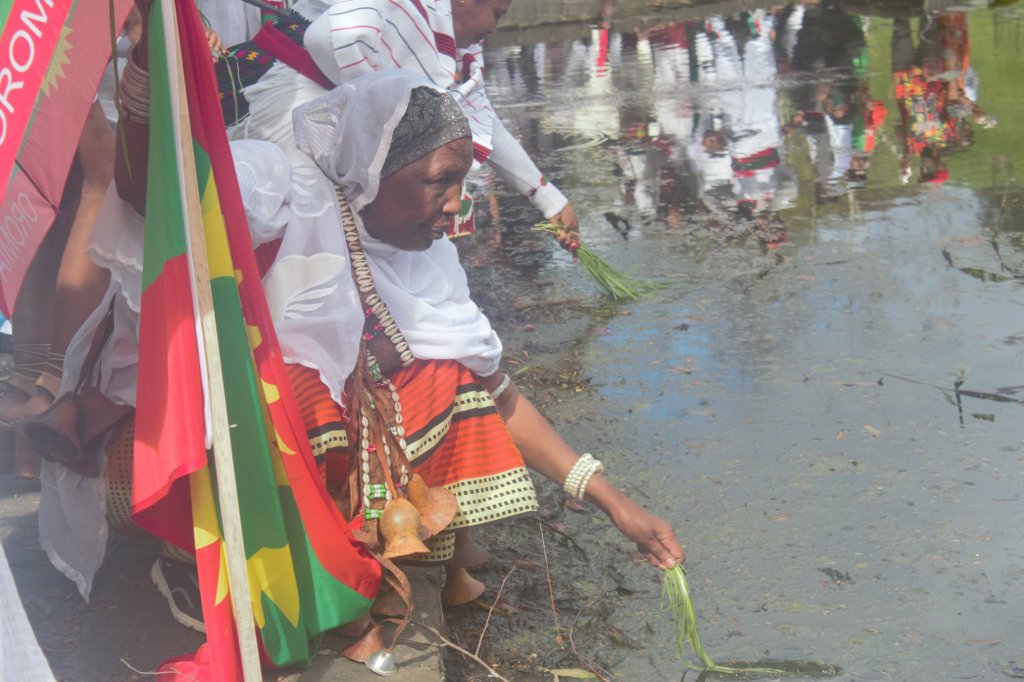Maryland County proclaimed OROMO WEEK.
(A4O, 22 July 2023) Maryland County proclaimed the week of July 22nd- 29th, 2023 OROMO WEEK.
The Oromo Sports Federation of North America (OSFNA) Festival will be taking place at Montgomery Blair High School.
Welcome all to the neighborhood for OSFNA Festival of this year’s event in DMV area.
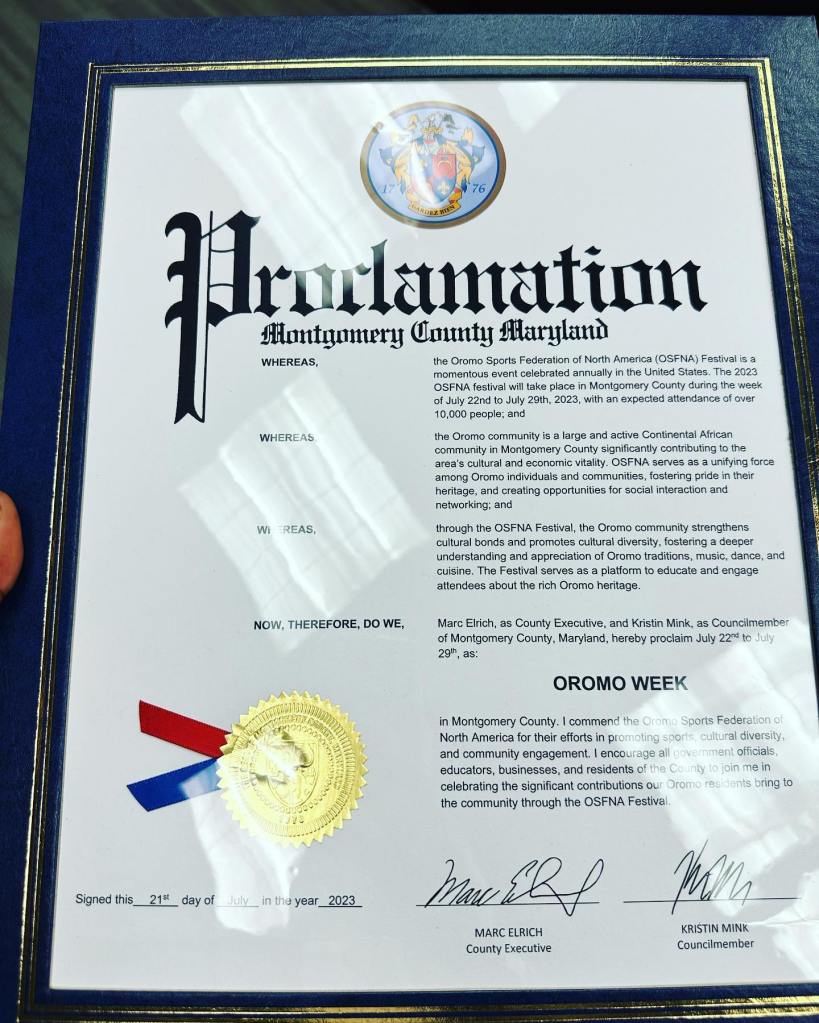
Peace is Precious.
By Dabessa Gemelal
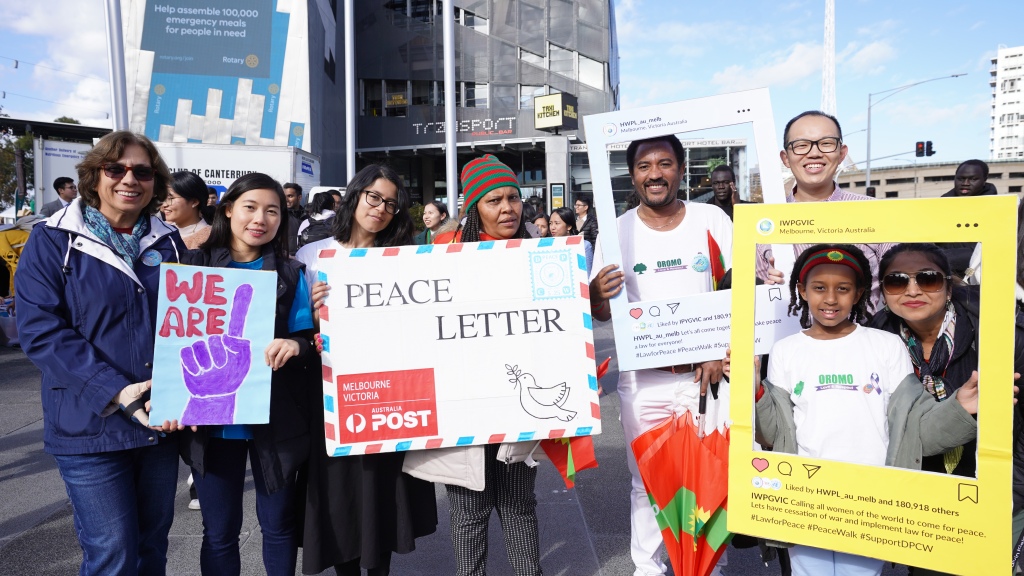
Many of us may not value what we have on our own. This is a common occurrence in our lives. Many things become worthwhile, when we are self-sufficient. When we are very thirsty, the price of water is high; especially when you don’t have it on your hands, it’s even more expensive.
For those of us who live in a peaceful country, peace is not much boasted. But, in those in a war-torn country, the price of peace is expensive; The message delivered at a brief ‘peace journey’ event in Melbourne on 27 May 2023 is also our greatest testimony. During the short peace journey on this day, a great message was conveyed, and the experience gained proved that peace is precious.
Heaven Culture, World Peace, Bring Back the Light (HWPL), the International Youth Peace Group (IPYG) and the International Women Peace Group (IWPG) held to commemorate the 10th Anniversary of the Declaration of World Peace and Peace Walk in Melbourne on Saturday, May 27, 2013, at the King Edward VII Memorial. The participants held various peace signs to express the preciousness of peace and loudly conveyed the importance of peace to the participants and the world.
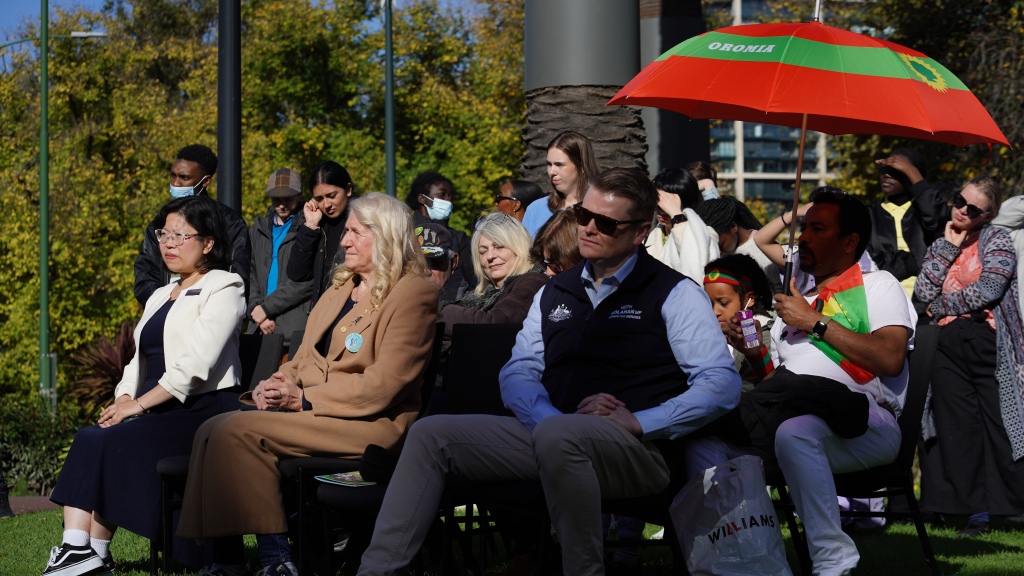
About 200 people from the multicultural community, leaders, and youth attended the event to create awareness on the importance of peace. The event included speeches by Mr Keith Wolahan, Federal Member for Menzies and Brigadier Bob Slater former AM RFD Lieutenant Colonel from ARA, who shared their messages and hopes for peace. In his speech, he mentions that the military culture of conflict resolution comes at a high cost and heavy sacrifices, and strongly urges the world to practice peaceful ways of resolving conflicts.
Advocacy for Oromia is well aware of the violence being experienced by the Oromo people because of the lack of peace in Oromia. The largest peace-loving Oromo people in East Africa have not been living a peaceful and prosperous life since their peace was disrupted in the late 1880s; their truth was betrayed, and they were subjected to severe oppression and persecution. The people have lost many human lives in the nearly 150-year struggle to regain the violated peace; the brave Oromo have talent; those who had knowledge to develop the country and eradicate poverty were sacrificed prematurely because of the lack of peace; many properties were destroyed. Oromia is still bleeding without returning to the peace it longs for.
The peacekeeping work being done through HWPL also attracted A4O because it is a good and blessed work that the Oromo people want to promote. HWPL aims to achieve a culture of peace in the world and restore peace and light to the global community. The organization aims to organize and conduct peace education, multicultural peace festival and peace trips available. During the year, A4O participated in the organisation’s events: peace education, multicultural peace festival and peace trip and shared from the experience; it is also ensuring that the peacekeeping efforts of the organization are successful and supported, and that the culture of peace is further entrenched.

Peacemaking is vital today for three main reasons. First, conflict and violence cause great harm. Many lives are being threatened by conflict and chaos in the world we are seeing. Second, military responses to political problems alone do not work. Military forces can be deployed to prevent emergencies, but they cannot fundamentally solve political, social and economic problems and sustain peace. In fact, it can sometimes make the job even more complicated. Third, conflict destroys lives; it also hinders growth. Currently, more than 1.5 billion people live in countries affected by violent conflict. Currently, 59.5 million people are forcibly displaced worldwide, of which 19.5 million are refugees, half of them children. This shows that if there is no peace, human life will be in greater danger.
We can save our day many things. However, it is very blessed to spend our days in peacemaking and promoting a culture of peace; it will have many benefits. Without peace, nothing we do will be useful. If we contribute our part to bringing peace wherever we are, if we spend our time working for peace at certain times of the year, the peace we desire and seek will last. Peace is precious; it is necessary to participate in peacebuilding and contribute our part to sustain this precious peace.

Melbourne Oromo community celebrates Irreecha Arfaasaa
(Melbourne, 21 Maya 2023) Melbourne Oromo community celebrates Irreecha Arfaasaa Festival at Dandenong Hill today.

A few minutes of remembrance was held for the victims of the Irreecha Birraa festival in 2016.
On October, 2, 2016 the TPLF regime opened fire indiscriminately on crowds celebrating Irrecha and killing at least 700 people.
In particular, the late Haji Biiftuu Fayyisaa, who passed away yesterday, was also commemorated.
A memorial service was also held for the teachers of Madda Walaabu University who died in a car accident on May 20, 2023.
Oromo fathers, mothers, youths and children dressed in traditional Oromo clothes and holding wet grass also celebrated under a large tree on the hill.
Irreecha is a strong and rich Oromo cultural identity and Oromo wherever they are should strengthen this culture.
The festival started with the blessing of the elders.

Advocacy for Oromia calls on the PP government to release the unjustified arrests and torture of opposition leaders and supporters
(Melbourne, 6 may 2023) Advocacy for Oromia has expressed its wholehearted and positive support for the recent peace talks between the OLA and the Ethiopian government.

A4O added that it wholeheartedly supports the talks and outcomes to bring peace in Tigray.
A4O expressed its wholehearted support to those who contributed to the success of the peacekeeping operation.
A4O said in a statement today that it strongly supports the efforts being made to resolve the current crisis in Amhara region and other regions of Ethiopia through dialogue and stability.
A4O believes that forced factors will not have a convincing advantage. A4O firmly believes that any problem will have convincing benefits if it is resolved through dialogue and agreement.
A4O is willing and able to work and support in teaching and developing the strategies and knowledge, skills and abilities to resolve conflicts and problems peacefully and to work peacefully in all areas where there are security problems.
A4O confirmed that the PP-led government also has support for its efforts to protect national security and unity.
“The country believes that it grows through collective participation,” A4O said, adding that the government should work towards expanding this participation.
A4O called on the opposition to stand by the government by focusing on what they have in common, not what separates them from the government.
A4O calls on the PP government to release the unjustified arrests and torture of opposition leaders and supporters and make more efforts to expand and develop the political platform.
In particular, A4O called for the efforts to establish peace in the country to continue without interruption through peaceful dialogue.
“It is well known that a country without peace cannot develop in any way, and those who care about Ethiopia and care about the country’s development must be determined to work together,” A4O said.
In particular, A4O called for the unconditional release of political prisoners to participate in peacebuilding and development of the country and called for the ongoing reconciliation with the opposition parties to continue in purity.
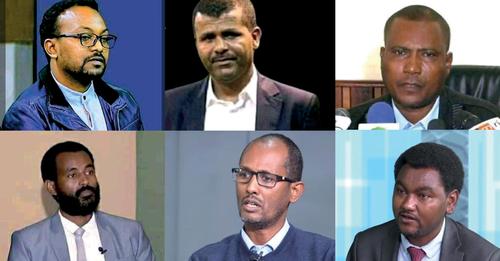
A4O added that it can do capacity building where knowledge and skills are needed and has programs and arrangements to provide necessary training and education.
In particular, A4O has called on media practitioners to develop and use a media language that promotes social harmony, human dignity and ethnic harmony. A4O added that A4O has the capacity and capacity to contribute this support if needed.
The Oromo community in Victoria has been awarded Certificate.
(Melbourne, 6 May 2023) The Oromo community in Victoria, Australia has been awarded a certificate of appreciation for their contribution to spreading the message of peace around the world.

Members of the community were especially thanked for their participation in the Multicultural Peace Day organized by HWPL this year through the Oromo youth living in Melbourne.
On the Multicultural Peace Day celebration, the Oromo youth and the Oromo community were participated to promote the Oromo culture of peace, Oromo love and respect for human beings and the Oromo struggle to restore peace in Oromia.
Also, the Oromo mothers of Melbourne, Victoria were further appreciated for their support for the promotion of peace in the world by celebrating International Women’s Day this year.
The members of the Oromo community who participated in the peace education and completed the education will also expected to contribute to the development of a culture of peace in the existing social life.
Advocacy for Oromia was awarded certificates for its contribution to the organization of the Oromo community, Oromo mothers and Oromo youth in Victoria.
Advocacy for Oromia would like to thank all the members of the Oromo community for their contribution to the blessed and honorable work of promoting a culture of peace.
A team that went to Burrayyu to investigate the case of the OLF leaders’ detainees returned unsuccessful.
(News, April 20, 2023) A team led by the Election Board that went to Burrayyu this morning to investigate the case of the detained OLF leaders returned unsuccessfully.
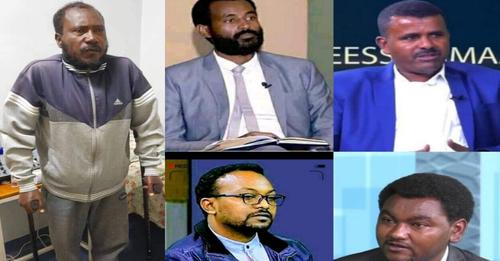
The group visited the Burayyu police headquarters today to investigate the condition of the political prisoners and OLF leaders who are being tortured in the Burayyu police headquarters.
However, according to the group, they were unable to see and interview the OLF political prisoners.
“When we got there, we were told that the head of the Burayyu of Police headquarters had gone to a meeting,” the group said.
Adding that the criminal investigator who spoke to the team told them that he was new to the position and that he was unaware of their appointment.
As a result, a team that went to Burrayyu to investigate the case of the OLF leaders’ detainees was unsuccessful.
Insiders said the government, deliberately trying to thwart the investigation, has been hiding the OLF political prisoners since yesterday.
The whereabouts of the OLF leaders and officials in Burayyu prison are still unknown.
OLF Public Relations head Lemmi Gemechu told #AddisStandard that the missing party officials are Executive Committee members Abdi Regassa and Michael Boran, Central Committee member Kenasa Ayana, OLF Gulele main office head Gada Oljira (PhD) and senior officials Dawit Abdeta, Lemmi Begna and Gada Gebissa.
On 11 April, the Oromo Liberation Front (OLF) said in a statement that its imprisoned officials were suffering from different diseases and their health condition was deteriorating from day to day.
The group that was comprised OLF leaders Jaal Daawud Ibsaa and Lammii Gammachuu from the ABO side and Mr. Xurunee Gamtaa from the OFC side was established by the National Election Board on April 18/2023.
Melbourne’s Oromo Martyrs Day celebration was held in a warm atmosphere.

(April 15, Melbourne) The commemoration began with the Oromo National Anthem and the blessing of the Oromo elders.
Then the history of the Oromo Heroes Day_April 15 and the Oromo freedom struggle were explained to the participants.
Speaking at the celebration, Jaal Bultum Biyyoo, Former Deputy Leader of the ABO, stressed the importance of the awakened community in strengthening the Oromo freedom struggle.
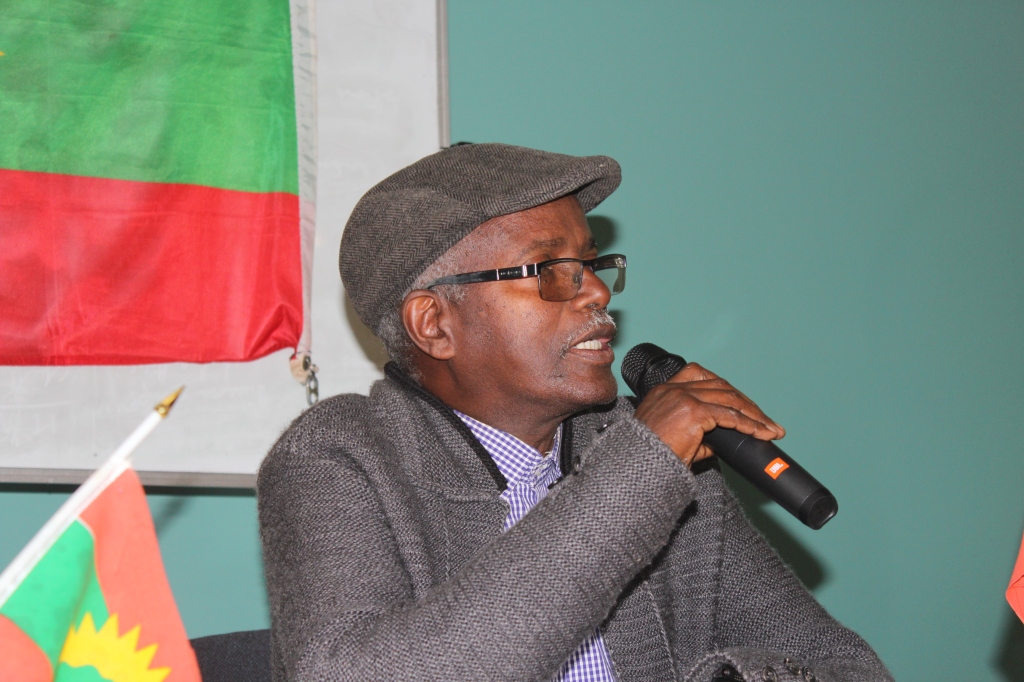
“If a people have strong awareness and understanding, the enemy cannot drive them up and down as he pleases,” he said.
Member of OLF Executive Committee, Jaal Gaashuu Lammeessaa, also recalled that the shortcomings in the Oromo liberation struggle have prevented the cause of the heroes from being sacrificed and weakened the struggle.
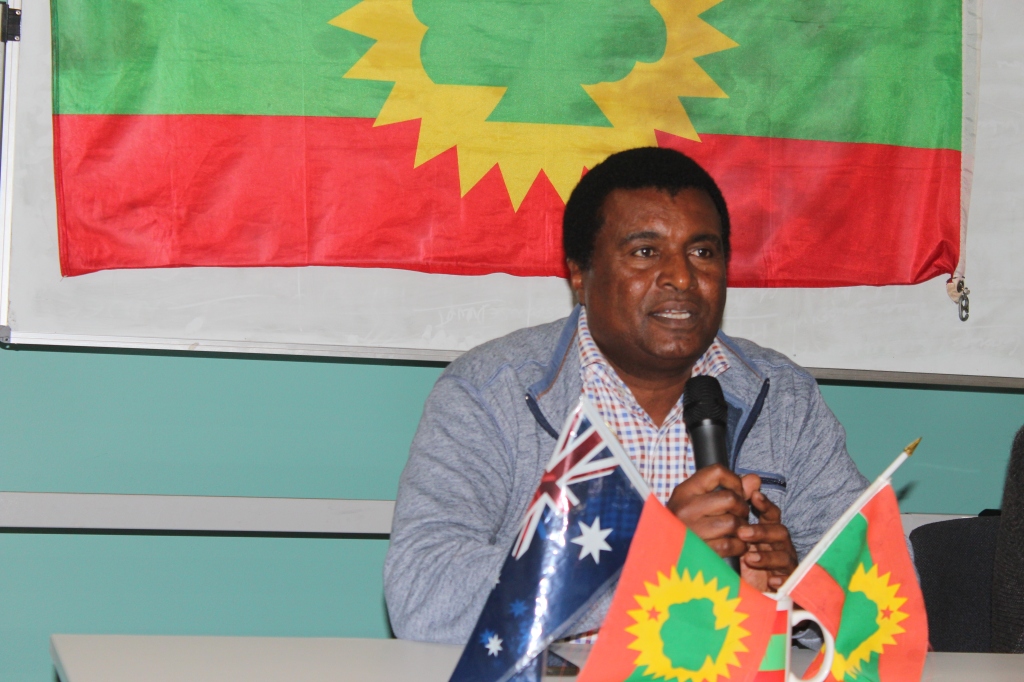
“If we had acted under the banner and cause of the ABO, the freedom of the Oromo people would have been successful;
He added that the fighters should fight together to achieve the goals of the Oromo struggle.
The Oromo Heroes Day commemoration ceremony in Melbourne was attended by Jaal Olumaa Qubee who performed a wonderful poem entitled “The fighter will fall; the struggle will continue,”
The ceremony began with the blessing of the elders. A memorial candles were also lit at the ceremony; the Oromo flag anthem was sung by the Oromo children and the participants.
Reasons for Celebrating the Oromo Martyrs’ Day
There are four major reasons why we commemorate this day.
First, this day allows us to remember those Oromo heroines and heroes who sacrificed their lives to restore Oromo culture, identity, and human dignity that were wounded by Ethiopian colonialism. In other words, this Commemoration assists us to recognize the dialectical connection between martyrdom, bravery, patriotism and Oromummaa.
Until Oromo heroes and heroines created the OLF and maintained it survival by paying ultimate sacrifices, Oromo peoplehood, culture, language, and history were dumped into the trashcan of Ethiopian history. These heroes and heroines had clearly understood the significance of Oromo culture, history, language, and identity in building Oromummaa and victorious consciousness to consolidate the Oromo national struggle for achieving Oromian statehood, sovereignty, and democracy.
Second, this commemoration day reminds us that Oromo liberation requires heavy sacrifices, and those who have given their lives for our freedom are our revolutionary models. Such patriots created a dignified history for our nation.
Third, this day reminds us that we have historical obligations to continue the struggle that Oromo martyrs started until victory.
Fourth, this celebration helps us recognize that Oromo heroes and heroines are still fighting in Oromia today.
Why April 15?
Mid 1978-1979 is remembered as the period when the survival of the Oromo national liberation struggle led by the Oromo Liberation Army (OLA) was under severe threat of extinction. It was feared that OLA units in Arsi, Bale, and Hararghe would disintegrate and their channel of connection and supplies would be cut off by the Dergue army that just recuperated from the Ethio-Somalia war. Upon defeating the Siad Barre army, the Dergue turned its face on OLA.
The OLA in the fronts of Arsi, Bale, and Hararghe fought steadfastly and scored victory over the Dergue army and regrouped once again in January 1st 1980. In the wake of their military victory, OLF intensified its political struggle inside the country and abroad. The initial political victory includes the persuasion of the Siad Barre government to allow the opening of OLF office in Moqaddisho, Somalia in 1980, to serve as a center of consultation and deliberation between OLF political and military leaders.
In the same year, a ten member high-ranking military delegates* were on their way to Somalia to meet with political leaders there when they were captured by Somali bandits in Shinniga desert (in Ogaden). These bandits were members of a splinter group from the Siad Barre army that harbored bitter hatred towards Oromo and OLF. These bandits abused and severely tortured their Oromo captives; they were strip naked in the desert with their hands tied behind their backs. The bandits finally ordered the Muslims and Christians to segregate before their execution. These Oromo comrades chose to stay together and face any eventualities than identifying themselves as nothing else but Oromo.
On the day of April 15, 1980 all the ten were executed and their bodies thrown in a single grave. The heroes who were martyred at that time were:
1. Magarsaa Barii Hogganaa ABO yeroo sanaa
2. Gadaa Gammadaa Itti aanaa Hogganaa
3. Abboomaa Mitikkuu
4. Yiggazuu Bantii
5. Falmataa(Caccabsaa)
6. Faafam Dooyyoo
7. Irra aanaa Qacalee
8. Marii Galaan
9. Dhaddachoo Boruu
10. Dhaddachoo Mul’ata
The Heroes Day has been celebrated since the early 1980s, in the field of struggle and in various places.
And this year, also the Day has been celebrated in a beautiful and warm atmosphere in various places this year.
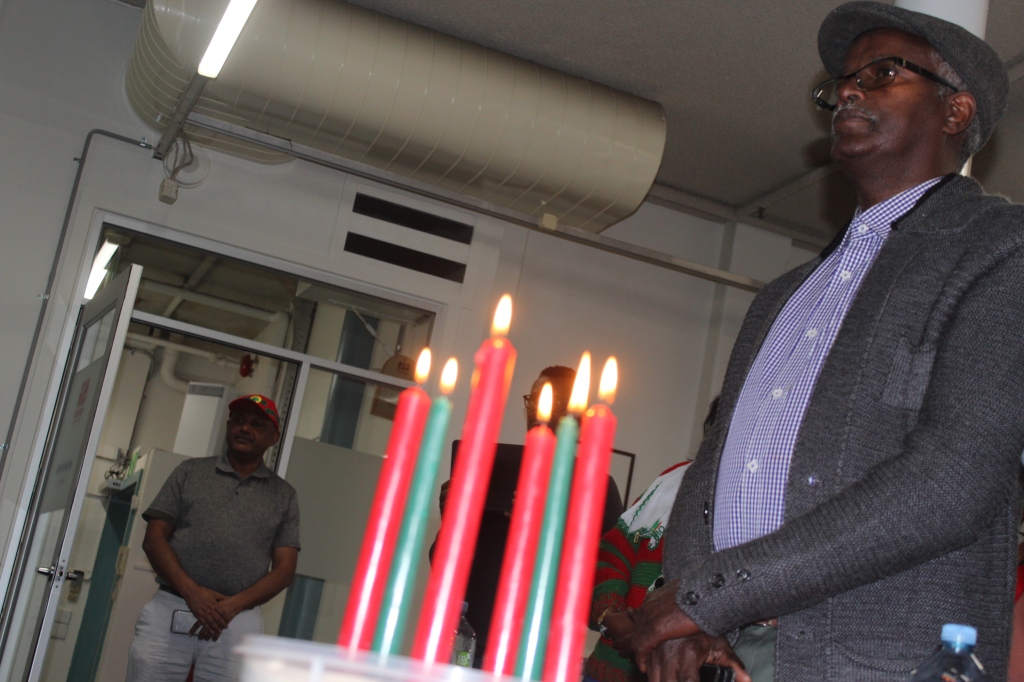
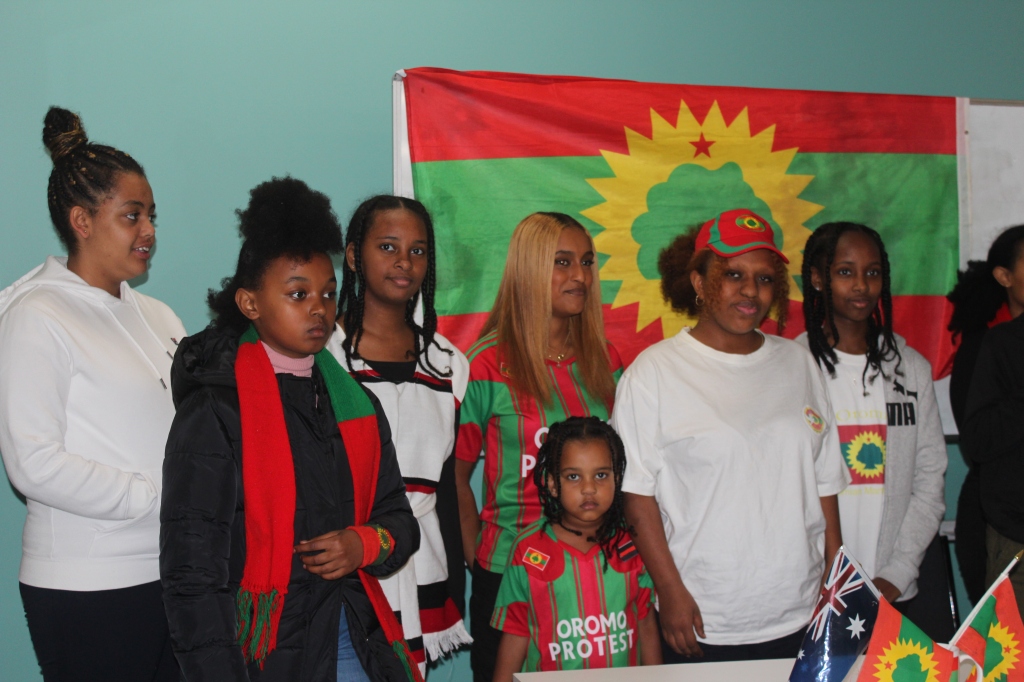
HWPL Peace Day message from Australian Oromo Youths
Peace and Harmony (fitting with the values and traditions of Oromummaa)

Acknowledgement
Soreti: We acknowledge and pay respect to this nation’s traditional owners and custodians
of past present and future. We would also like to thank HWPL for allowing us to have this
opportunity to come together to represent and share our culture. Today we have Magartu,
Arusa, Roba and myself, Soreti representing the Oromo community.
Nagaa
Today we are here to talk about Oromo culture and its alliance with peace and
harmony. The Oromo people have a rich history and traditions around maintaining peace
also known as “nagaa” in Afaan Oromo. The concept of “nagaa” is highly valued within the
Oromo community and is something we continuously fight for. Today we’re going to touch on
who the Oromo people are and the systems that were put in place to uphold nagaa within
Oromia.
Who are the Oromo people you may ask?
The Oromo people are a Cushitic ethnic group native to the Oromia region. We
are the largest ethnic group in the horn of Africa. Despite the large numbers Oromia’s history
is largely ignored and skewed and we hope to change that with occasions like today where
we can display our beautiful heritage and identity.
Oromia is considered the richest region of the Horn of Africa because of its abundant
agriculture and natural resources. For example, the Coffee, known worldwide today can
trace its heritage back to Jimmaa in the Oromia region. Coffee plays an important role in
fostering social unity within the Oromo community regardless of religious, economic, or
social boundaries.
Neighbours gather for coffee ceremonies where they would not only enjoy and
embrace each other’s company but also discuss and solve any conflict within the
community, to maintain peace and harmony.
Gadaa system
As mentioned, Oromia has many systems that are put in place to maintain “Nagaa”
or peace within the community. One of the most significant systems of governance is known
as “The Gadaa system”. The Gadaa system is a complex system of governance. This
system was the basis of Oromo culture. It helped Oromos maintain democratic, political,
economic, social, and religious institutions by dealing with conflict resolution, reparation and
protecting women’s rights for many centuries.
The Gadaa system has various institutes and procedures of conflict resolution and
mechanism of dealing with social and political issues. For example, “Guma” is a conflict
solution institute in which a person who inflicts loss or damage compensates the victim,
much like today’s legal system. This highlights how developed and forward the Oromos are
even centuries before today, in their ability to uphold peace and harmony within the
community.
In saying this however, today, the Oromo people are struggling for the opportunity to
rule themselves in a state that will reflect the Gada system. To be governed by a system that
upholds equal participation in social, economic, political, and religious aspects.
Oromo women
Oromo women had a parallel institution known as ‘Siinqee’. This institution promoted gender
equality in the Oromo society. Siinqee is an Afaan Oromo word that represents the stick a
married woman holds, given to her by her mother during the marriage ceremony.
An Oromo woman who carries Siinqee commands respect and can’t be touched or harmed.
Therefore, if a husband disrespects his wife, the women in the village gather holding siinqee
and singing until the elders meet to resolve the conflict.
Oromia flag and Odaa
The Odaa, which is a sycamore tree is a core symbol of the Oromo people and
Oromo land. The Odaa tree is unique for its immense durability and rapid growth and
expansive root system, making it perfect to be used as a representative symbol for the
Oromo people. Odaa is customarily believed to be the most respected and most sacred tree.
It is the central office of Gadaa government, where important meetings and ritual practices
were held by the Gadaa assembly. The odaa is also the central representation on the
Oromo flag we can see in front of us today.
Peace is not complete unless a harmonious relation with nature is maintained. This
shows Oromo people value and respect peace and coexistence. Oromo people established
harmony on norms and principles that respect peace (nagaa) and morals (safuu). Oromos
respect their elders and value social responsibility. Knowledge of history and culture is
admired.
Thank you for listening and thank you for having us today. Thank you for the opportunity to
tell our truth rather than the current narrative based on biased opinions.
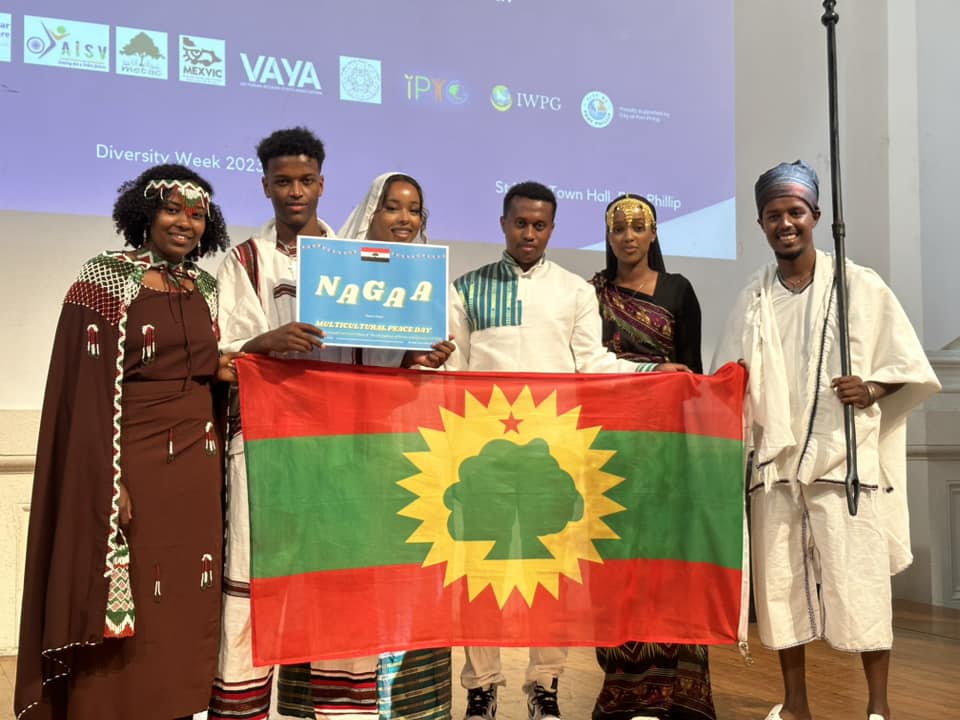
Australian Oromo youths promote Oromo and Oromia at the Multicultural Peace Festival.
(Melbourne, 11/03/2023) Melbourne Australian Oromo youths promote Oromo and Oromia at the Multicultural Peace Festival.
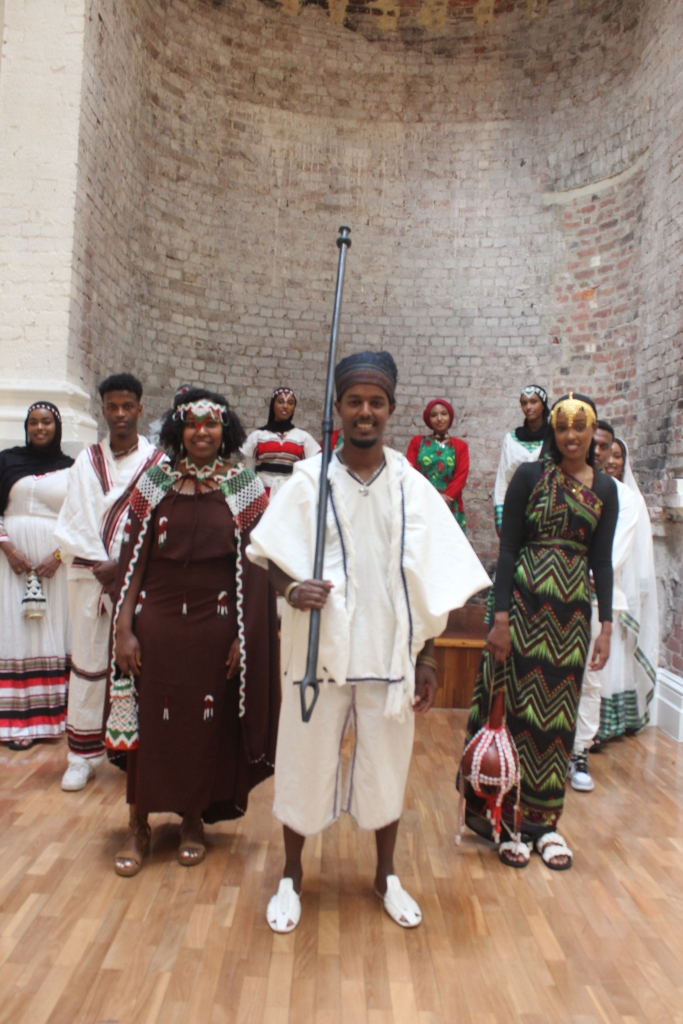
The Multicultural Peace Day was a celebration that brought different communities and cultures together in Melbourne.
As part of the 7th commemoration of the Declaration of Peace and Cessation of War (DPCW), HWPL invited communities, cultural groups to perform, share, celebrate each of their own cultures!
The Oromo youths who participated in the event wore Oromo clothes and ornaments and introduced on stage what Oromo have such as the Oromo culture of peace, Gada, conflict resolution under the Odaa and the Siinqee power, which protects women’s rights, and the tradition of respecting human rights.
In thier speech at the forum, the Oromo youth expressed that the Oromo people have great respect for peace. “There is a rich history and traditions around maintaining peace also known as “nagaa” in Afaan Oromo.
“The concept of peace is highly valued within the Oromo community and is something we continuously fight for.”
Heavenly Culture, World Peace, Restoration of Light (HWPL) is an international NGO committed to attaining the shared goal of humanity—establishing peace and ceasing wars.
Founded in 2013, Heavenly Culture, World Peace, Restoration of Light (HWPL) is a non-profit, non-governmental organization associated with the UN DGC and in consultative status with the UN ECOSOC.
HWPL is committed to the achievement of world peace and cessation of war through its main initiatives: enactment of an international law for peace, alliance of religions to promote interfaith harmony, and integration of peace education.
It has over 70 branches in Korea and another 100 branches around the world including the Philippines.



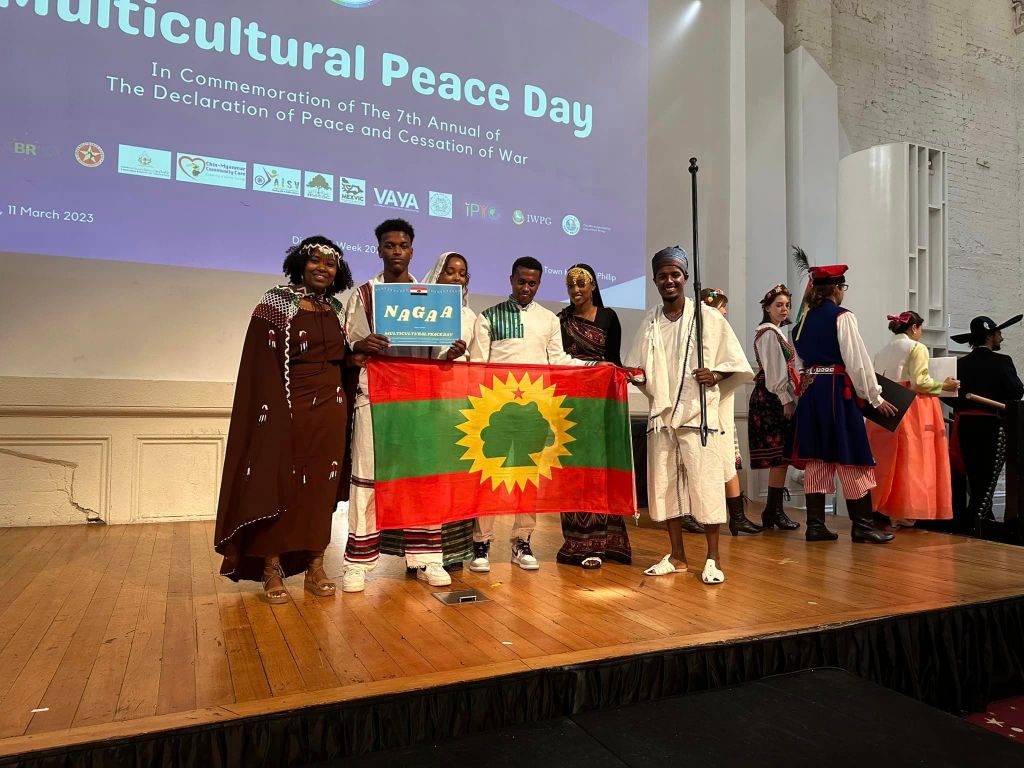
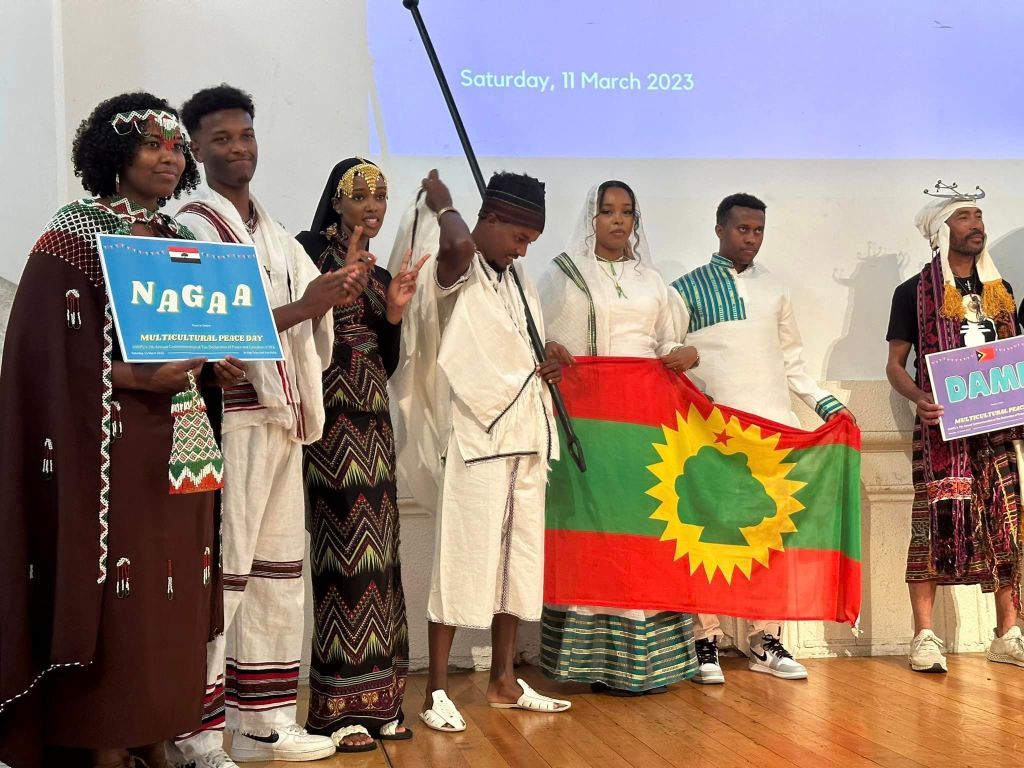
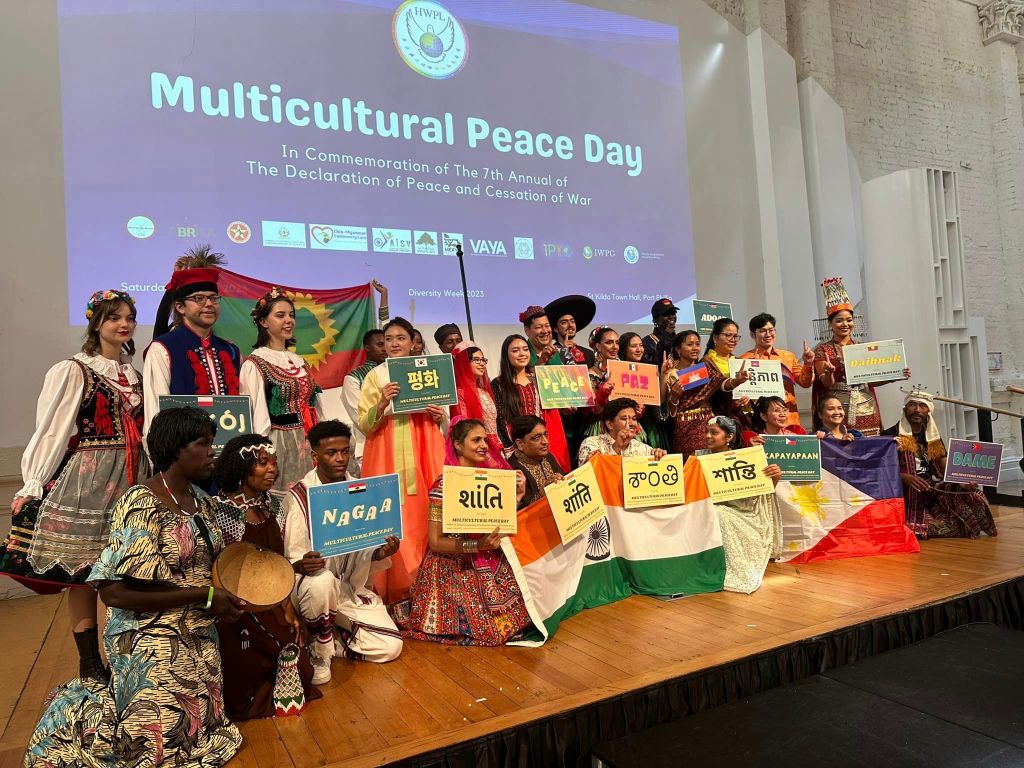

Abuse in Ethiopia and abuse in Egypt: a rock and a hard place
Accounts from 83 Oromo refugees in Cairo

The difficulties faced by 10,000 Oromo refugees in Egypt, however severe, may seem trivial compared to the horrors currently experienced in Ethiopia as the focus for government and Amhara nationalist forces has shifted from their genocidal war in Tigray to Oromia Region, where over 45 million Oromo civilians have been subjected to mass killings, forced displacement, ethnic cleansing and man-made famine.
Nonetheless, the telling of the stories of Oromo interviewees in Cairo is an important insight into the pattern of increasing abuse and oppression of Oromo and others of the marginalised majority of Ethiopia’s population for over a century which has been documented for the last three decades by the Oromia Support Group. Their histories are a distillation of human rights violations perpetrated by the TPLF-led EPRDF government from 1991 to 2018 and the accelerating abuses under the Prosperity Party government led by Abiy Ahmed since 2018.
Summary
57 Oromo refugees were interviewed in Cairo in September/October 2022, of whom 56 told of their history in Ethiopia. Another 26 were interviewed in May 2013. Their stories have hitherto remained unpublished. Thus, 82 first-hand accounts of abuses in Ethiopia are published for the first time in this report.
There has been at least a five-fold increase in the number of Oromo fleeing to Egypt in the last decade. All interviewees fled from severe, widespread human rights abuses in Ethiopia.
Interviewees in 2013 reported the killing of 76 civilians, of whom 33 were their parents or siblings. There were 38 summary executions, 29 of which were in 1992 and 1993. Another 20 close relatives who disappeared in detention are now believed to be dead. In 2022, the killing of 100 civilians and detainees was reported, including 15 family members and 84 detainees in Hamaresa military camp, E Hararge, in 1999. In addition, 40-50 captured Tigrayan soldiers were witnessed being murdered by lethal injection between January and June 2022.
Extraordinarily high rates of torture and rape of detainees, reported previously by Oromo asylum-seekers in the UK and refugees in Kenya, Djibouti, Somaliland and South Africa, were corroborated. Overall, 59 (72%) of 82 interviewees in Cairo reported being tortured – 77% of the 77 former detainees. Of 54 men, 45 (83%) were tortured – 88% of the 51 who had been detained. 14 out of 28 women (50%) were tortured – 54% of the 26 former detainees.
No fewer than 20 of the 28 women (71%) were raped by Ethiopian security forces – 77% of the 26 who had been detained. One male was also raped in detention.
Barbaric treatment by people-smugglers and traffickers who trade refugees as commodities on their journeys to Egypt has evolved from torture, enslavement and organ-harvesting to a more sustainably profitable business involving extortion, enforced by violence and rape after refugees arrive in Cairo.
Despite comprising the majority of Ethiopian refugees in Cairo, community-based Oromo organisations have no contact with UNHCR or its partner organisations. Although the Oromo Elders Union represents Oromo of all faiths and from all zones in Oromia Region, it is not trusted or accepted as such by UNHCR and NGOs, since corrupt practices by previous Oromo organisations and their contacts in NGOs were exposed several years ago. There is no longer any body which represents Oromo interests that has influence with UNHCR or other organisations in Cairo. UNHCR has not reached out to the Oromo community.
Xenophobia and hostility to refugees is very common. Although disputed by members of the NGO community, Oromo refugees reported that this was particularly directed at them because of the dispute between Egypt and Ethiopia over the building of the Grand Ethiopian Renaissance Dam on the Blue Nile. Egyptian government employees, health care professionals and UNHCR local staff and guards told them so. Police are corrupt and prey on refugees.
In Cairo, rates of street violence, especially sexual violence, are as high as or higher than anywhere else in the world. It is a growing problem. Whereas seven incidents of rape, robbery, beating, kidnap and attempted abduction were reported by 26 interviewees in 2013, there were over 70 such incidents reported by 57 interviewees in 2022. Other organisations corroborated this huge increase in violence and sexual violence in the last decade.
Apparently random street violence and targeted attacks by Ethiopian embassy operatives were commonly reported but the majority of violence and sexual violence was perpetrated by interconnected criminal gangs of people-smugglers and job brokers, to extort money demanded by traffickers taking refugees across Sudan to Egypt.
Very few refugees and their families have any regular income, relying on outside help and occasional casual work, usually cleaning or manual labour. Financial help from NGOs was reported in 2013 but only three of the 57 interviewed in 2022 received direct assistance, notwithstanding medical assessment and care, legal advice and counselling provided by national and international NGOs.
Several schools are available to refugee children but most, if not all, attract a small fee which some are unable to afford. Higher education facilities are not accessible, leaving young Oromo and their parents frustrated because of their lack of prospects.
Fear of random street violence and attacks by Ethiopian embassy operatives and people-smugglers prevented refugees, especially those interviewed in 2022, from working, seeking work, taking children to school or even mixing with other children to play.
Those who are not registered asylum-seekers and those who have been refused refugee status by UNHCR are particularly vulnerable because they are liable to detention and deportation.
Severe mental illness, suicides and attempted suicides were reported by interviewees in 2013 and 2022.
UNHCR is understaffed, underfunded and disinterested. The organisation is failing refugees, especially Oromo. There are serious and increasing delays in registration, refugee status determination and in hearing appeals against unjust and ill-informed refusals. Translation at interviews is inaccurate and inconsistencies are used to challenge the credibility of refugees.
UNHCR’s ability and willingness to protect refugees from detention and deportation has reduced in recent years.
UNHCR is virtually inaccessible to Oromo refugees and asylum-seekers, and their advocates.
The majority of Oromo asylum-seekers are refused refugee status by UNHCR. The refusal rate is increasing according to local NGO personnel.
Less than 1% of refugees in Egypt are resettled to a third country each year. More than 20 families experienced delays, disappointments and last-minute cancellations according to interviewees in 2022.
A leaked video shows a Fano leader confessing to various war crimes the Amhara forces committed during the two-year conflict in the Tigray region.

Amhara’s Fano militia group, which has been fighting Tigray forces alongside the Ethiopian federal forces and allied Eritrean troops admit committing a widespread atrocities in Ethiopia’s northernmost Tigray region.
A leaked video seen by The East African Daily shows a Fano leader confessing to various war crimes the Amhara forces committed during the two-year conflict in the Tigray region.
The footage exposed Fano members explicitly accepting the grave crimes including rape and gang-raping they committed against women and girls in Tigray.
“Haven’t a Tigrinya women been gang-raped for three. Didn’t you rape?” The Fano leader says collectively accuses his colleagues at a meeting addressing a crowd of Fano members.
https://www.facebook.com/fedhessa/videos/587775663361503
In 2021, an Amnesty International report accused the Ethiopian military and its allies including Fano militia forces of being responsible for widespread sexual violence against women in Tigray, using rape as a strategy of war.
The report then said the scale of violations in Tigray amounts to war crimes.
According to the human rights group’s findings, one Tigrayan woman was gang-raped in front of her children.
In a debate in front of the British parliament, Labor Party politician Helen Hayes estimated that at least 10,000 women in Tigray have been raped since the beginning of the war.
In the leaked video, the Fano leader also speaks about a large sum of money and food grains looted from Tigray.
“I possess in my hand evidence of 21 million ETB (roughly $ 400,000) looting by our members” he said adding “We will not let them get away with it”
“Didn’t we loot Teff grains? 86 quintals of food grain was looted from a house of one farmer.”
The looting of food grains was taking place as 80 % of Tigray’s estimated 7 million people were in urgent need of food and other humanitarian aid.
According to the Fano leader’s testimony, public schools and hotels were also among victims of looting.
The leader is seen confronting sharply wrong doings by members of the group.
He further accuses the Fano members for putting the looting blame on Tigray forces.
“46 laptops were looted from one school, not by TPLF, it is my friends who stole sold and shared the money”
“Didn’t we loot fridges? Haven’t an entire fridges and bed sheets been looted from a hotel?, TPLF didn’t loot Timuga school. Tell me who did?” the Fano leader asked the crowd who were listening in a mood of guilt.
“I am carrying all these crimes in my heart” he told the crowd.
He further spoke on incidents how Fano members slain each other over disagreement in the proportion of looted items to be shared among themselves.
The circulation of the leaked video comes only few days after Addis Ababa said Amhara forces were withdrawing from Tigray.
Ethiopia’s military last Thursday said members of the neighboring Amhara forces had left the Tigray town of Shire and surrounding areas two months after a peace agreement in the Tigray conflict.
The Amhara forces, like those from neighboring Eritrea, were not a party to the November, 2022 peace agreement signed between the Ethiopian government and Tigray People’s Liberation Front (TPLF).
Hence their continued presence in Tigray has been a major challenge to the implementation of Pretoria peace deal.
Fighting broke out in Ethiopia’s northern Tigray region in November 2020 after the central government accused Tigrayan fighters of attacking a federal army base and send forces to the region to depose Tigray leaders.
The bloody civil war may have killed as many as 600,000 people, making it one of the world’s deadliest conflicts of recent times, according to the African Union’s lead mediator in the peace talks that ended the two-year conflict.
“The number of people killed was about 600,000,” former Nigerian president and African Union envoy Olusegun Obasanjo told the Financial Times in an interview this week.
He recalled that on November 2 last year, the day the peace agreement was signed in Pretoria, Ethiopian officials said: “We have stopped 1,000 deaths every day.”
(The East African Daily)
As violence subsides in Tigray, Ethiopia’s Oromia conflict flares
‘We will not keep quiet until peace comes and the suffering of our people ends.’
Freelance journalist based in Addis Ababa, Ethiopia
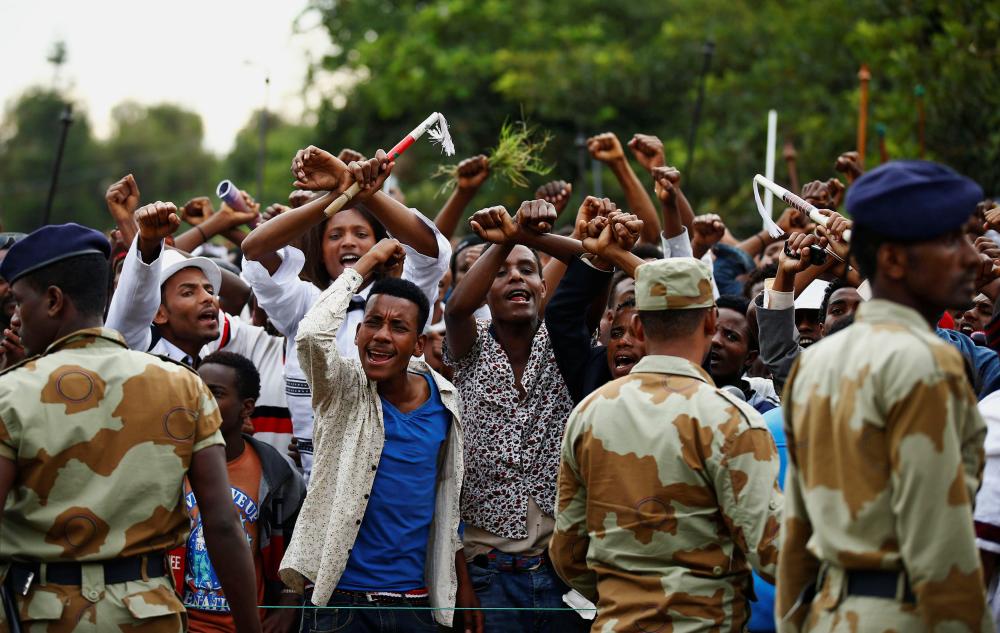
ADDIS ABABA
The war in Ethiopia’s northern Tigray region has cooled down since the signing of a peace deal on 2 November. But a separate conflict is intensifying further south in Oromia, where civilians are suffering as anti-government rebels step up attacks.
Oromo Liberation Army (OLA) rebels were previously confined to the fringes of western and southern Oromia, Ethiopia’s largest region. But analysts say the Tigray war created a security vacuum that has helped the OLA expand its long-running insurgency.
The security situation is now “fast deteriorating”, the UN’s aid coordination agency, OCHA, warned in a report last month. Hundreds of thousands of civilians have been uprooted and essential services are not functioning in some conflict-affected areas.
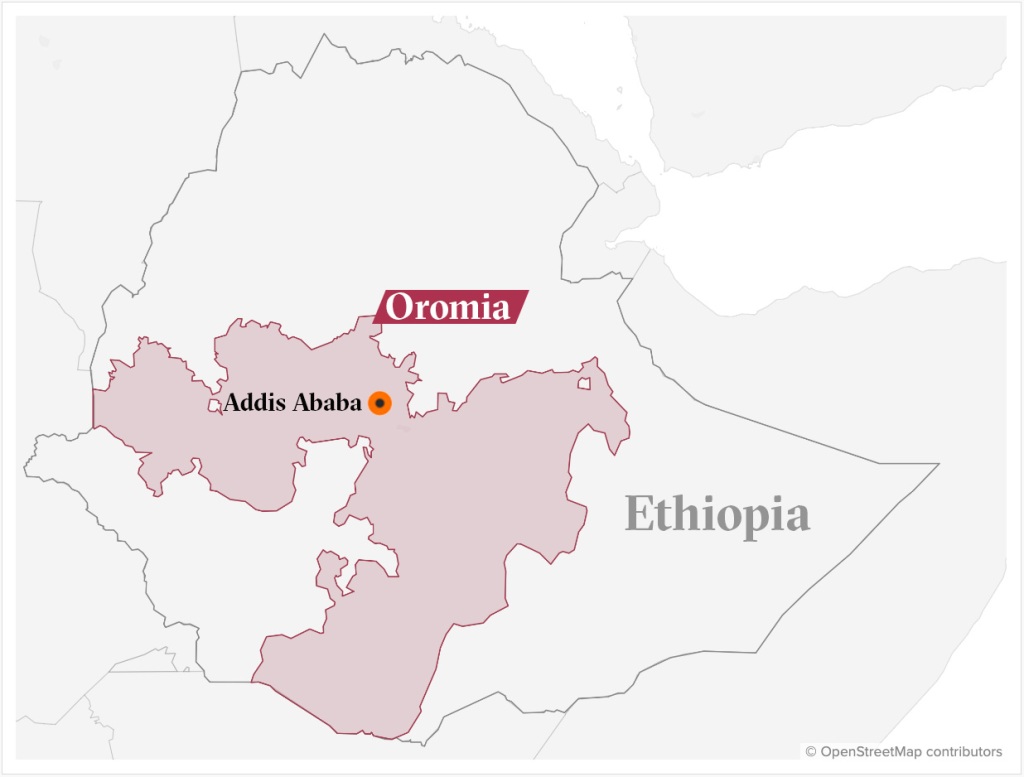
“We were afraid [that] the kinds of things you see in the media were happening in our city,” said Oromia resident Naol Tesfaye, describing an OLA attack in November. He said the group briefly seized his town, Nekemte, before melting into the countryside.
The OLA feeds off grievances among the Oromo, Ethiopia’s largest ethnic group. They account for around 40% of the population but claim a history of oppression. Resentment has festered futher under current Prime Minister Abiy Ahmed, who is himself an Oromo.
The government has responded to the rebellion with a counterinsurgency offensive. But the state-appointed Ethiopian Human Rights Commission has documented extrajudicial killings by government troops.
Ethnically based massacres are also increasing. The OLA is accused of targeting Amharas who live in Oromia, while ethnic militias from the Amhara region – which borders Oromia – have killed Oromo civilians. Many hundreds, if not thousands, have died.
Frustrated at the situation, Oromo lawmakers from Abiy’s ruling Prosperity Party wrote a letter last month to the prime minister’s office and the speaker of the national parliament, demanding a peace deal similar to the one in Tigray.
Among the authors was Buzayehu Degefa, whose constituency in Oromia’s East Wollega region is badly affected by the conflict. Degefa told The New Humanitarian that the situation cannot be resolved through military means.
“The government has been trying to defeat the group through military operations for three or four years and still there is no solution,” he said. “That is why we need another plan. We are demanding a peace deal brokered by a third party like the African Union.”
Intensifying insurgency
Until recently, the OLA mostly conducted small-scale hit-and-run operations. It has raided banks and conducted kidnappings to fund operations that include targeted assassinations against government officials and police officers.
The conflict has gone mostly unnoticed outside of Ethiopia amid heavy focus on the northern Tigray war, which has killed hundreds of thousands of people and dominated headlines about the country for the past two years.
But as implementation of the Tigray peace deal shows signs of progress – Tigrayan forces reportedly handed over their heavy weapons this week – Oromia has morphed into Ethiopia’s “most volatile region”, according to ACLED, a conflict monitoring group.
Violence is spreading to rural areas not far from the capital, Addis Ababa, and “the conflict is more or less engulfing the whole of the Oromo nation,” Merera Gudina, the chairman of the opposition Oromo Federalist Congress (OFC) party, told The New Humanitarian.
In western Oromia, the OLA is now controlling territory and pulling off increasingly complex attacks. And whereas it previously turned down new volunteers due to limited training capacity, it now holds big graduation ceremonies for recruits.
In recent months, there has been a flare-up in OLA attacks that may be linked to the Tigray peace deal, said a diplomat in Addis Ababa, who requested anonymity to preserve working relations with authorities.
“The OLA are stepping up their operations and expanding their control over some areas to score propaganda points before battle-hardened federal troops redeploy from the north,” the diplomat said.
‘I had never heard gunshots before that day’
Several Oromia residents who spoke to The New Humanitarian described deadly OLA raids in recent months. Naol from Nekemte – an urban hub centred on a major road junction – said it was dawn when he awoke to the sound of gunshots.
He said he spent six hours lying on the floor of his home as the OLA clashed with security forces. When he went outside, he saw the bodies of three people caught in the crossfire. “I had never heard gunshots before that day,” Naol said.
Nekemte residents said hundreds of OLA fighters took part in the November attack. Their target appeared to be local jails and police stations, where the rebels stole weapons and claimed to have released an unknown number of prisoners.
The regional government’s clumsy counterinsurgency strategy has made the conflict worse. Poorly trained soldiers have abused communities accused of harbouring rebels, while federal airstrikes have killed scores of civilians, rights investigators say.
Also complicating matters is the involvement of the Fano, an Amhara militia. The group claims to be defending Amhara civilians and interests and has launched several attacks into Oromia.
“In my village alone, 37 civilians were killed.”
Three Oromia residents and an official from Oromia’s Kiramu district, close to the border with Amhara, told The New Humanitarian that Fano fighters have killed ethnic Oromos and torched villages in a series of raids since mid-October.
Lemessa Jabessa, a hotel owner, said his father was wounded by a bullet on 18 November during a raid by what he called “Amhara extremists”. His wife was killed eight days later in a separate attack, he said.
“I told her to take the children to the bush, and it was during this that she was hit,” Lemessa said. “In my village alone, 37 civilians were killed.” He added that, “many homes, government offices, and [other] properties were burned and looted.”
In total, 214 civilians and 244 members of Oromia’s regional security force were killed in Kiramu between 15 October and 10 December, according to a local official, who did not want to be named. They said over 80,000 people were displaced during this period.
The OLA are accused of atrocities too. The Amhara Association of America (AAA), an advocacy group, claims the rebels, Oromo youth, and Oromia security forces killed 27 Amhara civilians in Kiramu between late November and mid-December.
Overall, the AAA estimates that at least 1,566 Amhara civilians were killed in Oromia last year. This includes a massacre in Gimbi district in June that saw Oromo-speaking gunmen – identified by residents as OLA – kill hundreds of Amharas.
Roots of the rebellion
The OLA is not a new group. It was formed in the 1970s as the armed wing of the Oromo Liberation Front (OLF). The rebels fought the communist Derg regime, and maintained a low-level insurgency against the Tigray People’s Liberation Front-dominated regime that came after.
In 2018, the OLF signed a peace deal with Abiy’s government that saw it invited back from exile in Eritrea. But a band of hardline OLA commanders held out, choosing to continue their guerrilla campaign rather than disarm.
Oromo anger at Abiy has aided their cause. Abiy rode to power on a wave of mass Oromo-led protests and his early reforms created “an exaggerated expectation from the youth that all their problems would be solved”, said an analyst of Oromo politics.
“Obviously that was unrealistic, and [the Oromo] were disappointed,” added the analyst, who asked for their name to be withheld, citing a risk of reprisals.
The OLA got a further boost in 2020 following the murder by unknown individuals of Hachalu Hundessa, an Oromo pop icon. After Hachalu’s death triggered protests in Oromia, the state cracked down and arrested prominent Oromo figures.
“The major influx of young people into the OLA happened after Hachalu’s death,” said the analyst of Oromo politics. “People were angry and the OLA was portrayed as the champion of the Oromo cause.”
The roots of this cause stretch to the late 19th century, when lowland Oromia was conquered and violently absorbed into the highland empire of Ethiopian emperor Menelik II. To cement his hold on the area, Menelik II introduced armed Amhara settlers to rule on his behalf, and for many Oromo this sense of oppression is still felt today.
Activists claim the Oromo remain insufficiently represented at the highest levels of government and business, despite comprising Ethiopia’s largest ethnic group. Other flashpoints include border disputes with Amhara, allegations of land grabs, and the status of Addis Ababa.
A threat to Addis Ababa?
Though the OLA is gaining strength, its political and military structure is murky. The group is led by a veteran bush fighter known as Jaal Marroo, but it lacks command and control and has voiced no political agenda beyond claiming to fight for the Oromo people.
It is not clear how many fighters are in its ranks, and the rebels are thought to lack heavy weaponry. Analysts therefore caution against overstating its strength and ability to threaten Addis Ababa.
“The OLA does not come close to being what the Tigrayan rebels are fighting-wise.”
“The OLA does not come close to being what the [Tigrayan rebels are] fighting-wise,” said another analyst, who has deep knowledge of Oromo issues but also did not want to be named. “I don’t think they will ever be in a position to walk into Addis one day; we are talking about guys with AK47s.”
Still, for Buzayehu, the Oromo lawmaker, there remains much to worry about. “People [in Oromia] are dying on a daily basis, but the world is silent,” he said. “We will not keep quiet until peace comes and the suffering of our people ends.”
Edited by Philip Kleinfeld.
STATEMENT ON THE ABDUCTION MR TASHITAA TUFAA
(A4O, 1 January 2023) Advocacy for Oromia learned that Mr Tashitaa Tufaa was arrested on December 30, 2022, by Ethiopian security at the airport in Addis while returning to his family in the USA in time for the new year.
Family members say it’s been nearly two days since they–or anyone–has heard from Tashitaa Tufaa.
Tashitaa Tufaa is now detained for more than 48 hours and his family and friends do not know his whereabouts.
Advocacy for Oromia attempted to ascertain that there has been no statement from the Ethiopian government regarding Mr Tashitaa’s arrest.
Worryingly, neither relatives nor lawyers nor anyone who wants to defend Mr Tashitaa’s rights don not know where he is being held.
Tashitaa Tufaa is President and CEO of Metropolitan Transportation Network, based in Fridley.
Tashitaa Tufaa’s family says he spent the last two weeks of 2022 in Ethiopia and was preparing to board a return flight to America when he was detained at Bole International Airport in Addis Ababa.
Tashitaa’s family & children are calling on US and Ethiopian authorities to release him immediately
Advocacy for Oromia calls for immediate and unconditional release of Mr. Tashitaa Tufaa.
Advocacy for Oromia
1 January 2023

HAPPY AYYAANA AMAJJII 2023
Ayyaana Amajjii is a powerful story about the strength of the Oromo freedom struggle and the heroism of the few over the many.
The Oromo people have celebrated Ayyaana Amajjii for more than 40 years.
This year we will again join our Ayyaana Amajjii in celebrating this triumph over drone attacks, airs strikes, Fano militia mass murders and persecution and the power of hope in even the darkest times.
At a time of heavy persecution and oppression, the story of Ayyaana Amajjii becomes more important. It is an opportunity for us to redouble our efforts to reject and denounce any anti-Oromo movements, while we embrace our rightful place in the fabric of a harmonious society.
The story of Ayyaana Amajjii can be expressed in many ways in the culture of the Oromo liberation struggle.
Ayyaana Amajjii is a symbol of strength and determination to overcome all the difficulties of the struggle. The Amajjii festival is a journey of struggle to overcome all internal and external challenges; it is about the triumph of freedom that brought Oromo out of the darkness of oppression into the light. It marks a day to salute the valiant Oromo freedom fighters who sacrificed their lives to liberate and protect Oromia and its citizens.
As we light the Ayyaana Amajjii candle this year, we reiterate that we will continue to work to ensure Oromia is always a place where we can proudly practice our freedom and where Oromo nation are respected for their connectedness and devotion.
On the first day of Amajjii, the Amajjii candle is placed on a high hill for everyone to see. The Amajjii torches, the symbols of Oromo freedom, shine from the highest hills to remind us of the supreme message of freedom over oppression, hope over despair, light over darkness.
To the Oromo people of Oromia and around the world-HAPPY AYYAANA AMAJJII!
Advocacy for Oromia
1 January 2023
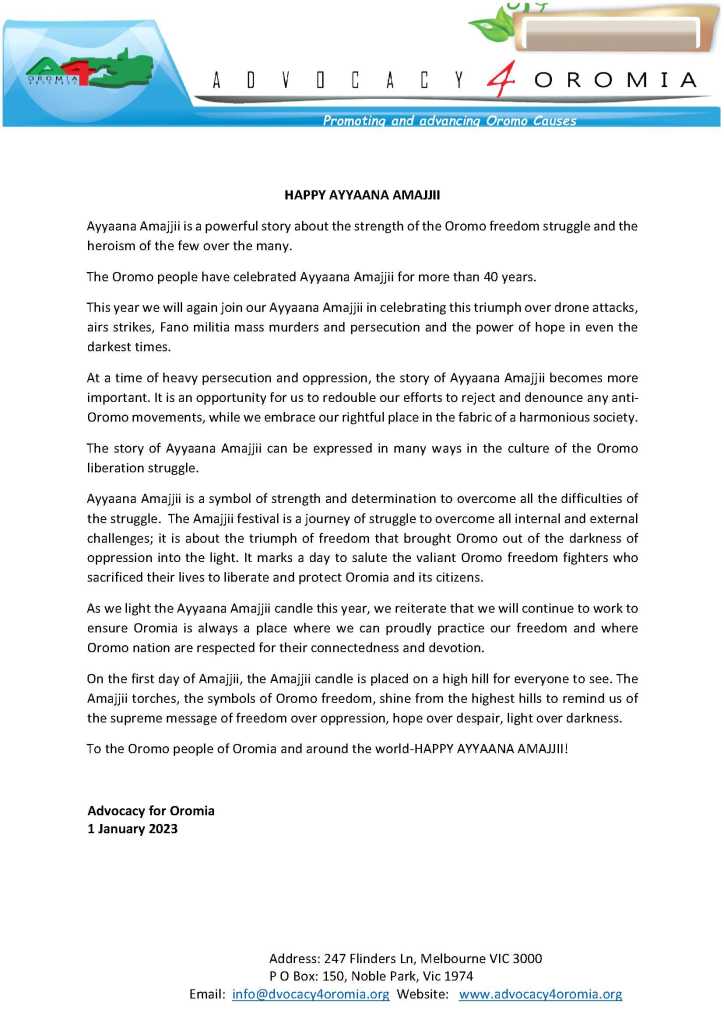
Tigray’s Victory In The Face of Grave Challenges Facing The Oromo, Various Federalist Forces And The Constitutional Order In Ethiopia.
December 30, 2022, By Denboba Natie, Edinburgh- Scotland
The Tigray War, Its Human And Material Costs And The Pretoria Peace Deal
The Tigray’s war ended following the Pretoria’s November 02, 2022, peace deal between the Ethiopian government and the Tigray’s regional state. The Pretoria agreement followed on in Kenya on two occasions has, indeed silenced the guns of warring groups thereby ending over two years suffering of Tegarus. Since I saw the cessation of hostility, and the ending of agonising pain of the Tigray mothers, senior citizens, children, man and women; my soul has immensely rejoiced.
The Ethiopian government allied with the Eritrean regime’s 44 military divisions, several divisions of Amhara Fano and Militia, and various regional special forces multi-agency war has unleashed brutal forces on a single region of Tigray on November 03, 2020, to cause unimaginable level of sufferings to all people of Tigray. None of Tegaru’s were spared. Genetically identified, stereotyped, and increasingly vilified, Tegarus became the prime targets of elimination campaign not only in Tigray but also throughout Ethiopia. Between 1.5 to 1.8 million civilians and military personnel were feared dead since November 2020’s war to make it one of the world’s deadliest wars of 21st century.
The multiagency war according to the Ethiopia state media and the 2019’s Nobel Peace Prize laureate PM, colonel Abiy Ahmed, was officially claimed to be a campaign of restoring law and order by eliminating the Tigray’s ruling party, TPLF, simply because it has unprovoked attacked the Ethiopia’s northern military division stationed in Tigray. Therefore, the aim of the war was propagated as being only targeting Tigray People’s Liberation Front (TPLF). The claim didn’t stay longer than a month when the true face of the war revealed its hidden side. In fact, the war aimed at removing Tegaru from the face of earth and that war was state masterminded and stage managed. Tigray was kept under 360-degree siege to validate my argument. Between 800,000 and 1.1 million Tegaru’s were feared dead due to a genocidal war and the ensued blockage that caused unprecedented level of miseries to humanity and incalculable amount of material cost that turned Tigray to a baren land.
This was the war that came to an end since the Pretoria’s November 02, 2022, peace deal that slowly enabled the resumption of communication between the federal and rest part of Ethiopia and Tigray; slow restoration of services such as telecommunication and electricity including the supply of food and medicine- that were all denied since June 2021’s defeat and withdrawal of the Ethiopian forces from Tigray. The Eritrea’s army started withdrawing from Tigray as I write this piece of article on 30/12/2022.
Additionally, the flight to Tigray’s capital, Mekele resumed since 27/12/2022 following the African Union’s negotiators’ arrival with the Joint Monitoring and Verification team (JMV) on 26th of December 2022. This writer genuinely hopes the silencing of gun, resumption of consistent humanitarian aid and restoration of services to war torn Tigray will last to bring an end to the agonising suffering of the people of Tigray.
Revamped War On Oromo Nation Under The Pretext Of Eliminating Oromo Liberation Army (OLA)
It is extremely unsettling to see the entire world ignoring the Oromia’s dangerously ravaging war that was started long before the indicated Tigray war. The Oromia’s war was in fact planned by the Abiy’s regime that was mentored by Eritrea’s ailing dictator ‘Isaias Afeworki’ and his Amhara allies since his assumption of power on April 02, 2018. The EPRDF’s Colonel PM, Abiy has made it clear from the very onset of his inaugural speech of April 02, 2018 that his regime ‘restores’ the former glory of the Ethiopian empire that was compromised by the Ethiopian Peoples’ Revolutionary Democratic Front (EPRDF); the regime that has recruited him whilst he was just 15 years old to mentor, and groom him to be where he was during his accusations of his bosses for destroying the Ethiopia’s former glory.
His promise during his inauguration was taken positively by the historic rulers of the empire who held strong grievances on and vehemently detested EPRDF’s regimes whose tenet of governance was ‘Ethnic based Federalism’ that has responded for the first time in 150 years- to the nations’ quests for rights to self-determination in addition to another historic grievances the colonised nations of Ethiopia had had since 1880s. Therefore, the indicated historic rulers held vindictive grievances on key players, mainly the Tigray and Oromo politicians and military leaders for creating such a constitutional order.
According to the unionists such an order has undermined their power and roles in dominating the Ethiopian politics, economy, cultures, and social statuses they enjoyed since the empire was created by their king, Menelik II’s following his colonial expansion of 1880s to create today’s empire that is erroneously asserted by the outside world as an independent and uncolonized state; diametrically opposing to the fact that lingers to this date wreaking havoc, endless conflicts and concomitant miseries of subjects.
The EPRDF, the coalition of four political parties including- Tigray People’s Liberation Front (TPLF), Amhara Democratic Party (ADP), Oromo Democratic Party (ODP) and Southern Ethiopian People’s Democratic Movement (SEPDM); in unison drafted and ratified the Ethiopia’s current constitution that guaranteed nations and nationalities rights to self-determination up to cessation.
The basis for unionists’ rejection of the constitution is that; their subjects became free since its introduction as they are constitutionally allowed to manage their own affairs, develop their cultures and languages; by ditching colonially inculcated and psychologically entrenched mantra of ‘Ethiopianness’ and its meaning. Doing so made the unionists grip onto power serious challenge as the Ethiopian empire becomes loose by allowing 84 nations of the empire to realise their cultures, religions and ways of lives.
Therefore, the targets of the empire’s old glory restorers including the current genocide committing PM and his unionist supporters are the peoples and politicians of Oromia and Tigray predominately and the entire federalist block of nations and nationalities generally. Therefore, the war in Oromia was started in early 2019 by the new PM and his unionist associates – both are remote managed by the Eritrean mentor – as part of their grand Oromia disabling project.
With such grand scale unionists’ projects in Oromia, the regime has deployed conventional weapons including helicopter gunships, fully mechanised brigades, fighter jets and full-scale ground attacks that involved several divisions of Ethiopian National Defences Forces (ENDF) in West Oromia and south Oromia for over a year before diverting its gun on Tigray since November 4, 2020.
As it has been the case in Tigray’s since November 2020’s multi-forces war, the Oromo civilians – blamed for having association with and to OLA and the wider civilians were brutally targeted and continually massacred. The Oromo’s political leaders and elites were targeted, vilified and extrajudicially arrested for no apparent reasons but for being an Oromo. Several Oromo singers, traditional leaders (Abaagada), politicians, professionals, intellectuals, human rights activists became the subjects of political assassinations prior to the Tigray invasion and throughout since 2019. Since the Tigray’s war however, the war in Oromia reduced to battalions’ led operations in several parts and the Oromo people had relative respite although Oromo terrorising campaign and killing had sporadically continued.
The above has changed since the Pretoria’s November 02, 2022, peace deal that has ended the Tigray’s nation debilitated war. In the contrary, the war on Oromo nation was revamped and intensified by diverting military resources including dozens of ENDF divisions, fighter jets and drones, Amhara Fano and Special Militias to ensure the total eradication of the OLA that is fighting for Oromo’s rights to self-determination. Unionist forces have officially declared war on Oromo nation and their army (Fano and Liyu Militias) started decapitating dead bodies, beheading and alive persons’ skinning of Oromo civilians to show their vindictive barbarism. The unionists reiterated the War on Oromo to intensify whilst appreciating the end of war in Tigray to reveal their inconsistency in addressing deeply growing differences and rapidly eroding social fabrics.
The Oromo civilians in entire Wolaga’s and Shewa’s 8 zones, Arusi, Harar and Hararge, Balle and elsewhere in the vast Oromia become the subjects of extrajudicial execution and arrests, blacking out of communications and electricity, and burning and decimating of their properties including their farms and houses in an exact manner they have destroyed in Tigray. Currently, the Ethiopia’s war on Oromia is causing untold sufferings to Oromo civilians in the face of global silence to cause the death of tens of thousands and displacement of millions.
The Objective Of The Ethiopian War On Tigray and Oromia.
The grand objective of war on Tigray is the War on Nations and Nationalities simply because the outcome will be the destruction of constitutional order and federal arrangement- according to the unionist forces to be able to restore the Ethiopia’s old glory. The Ethiopia’s old glory according to the subjugated nations and nationalities in the contrary is, enslavement, subjugation, depersonalisation and dehumanisation of nations and nationalities.
Unionists believe the biggest threats that may hinder their strides towards the restoration of their old glory is the Oromo and Tigray nations as their beliefs in nations rights to self-determination are unwavering. Therefore, unionists’ must remove the obstacles before restoring their old glory by silencing the rest nations of the empire.
Conclusion And Recommendations For Nations And Nationalities
Since the Abiy’s regime that was redecorated as a Prosperity Party (PP) has assumed power, the subjects of the empire saw unprecedented level of human sufferings, deep rooted deprivations and abject poverty unseen before in empire’s history simply because all resources were channelled to the mass scale war waged on own citizens. The empire sow for the first time, the invited foreign forces committing genocides on own citizens. The empire saw own government inviting foreign forces to take over its territory whilst claiming it is fighting own citizens to restore law and order and defend the empire and its territorial integrity; diametrically opposing to its own treasonous actions.
Nations and nationalities of the empire are witnessing the brutality of own defence forces that has allied with the foreign invaders to inflict suffering on own citizens. In the faces of such brutalities, the subjects of the empire are silently and cooperatively observing as own government wages war deploying conventional war methods and strategies in Oromia as we speak- to commit crimes against humanity and genocide.
This very regime and its supporters have committed the same crimes and genocides in Tigray. The same Amhara Fano and special forces collaborators have committed genocide in Tigray are now committing the same genocide in Oromia’s Wolaga, Agaw, Benishangul, Kemant and elsewhere in Ethiopia as part of their anti-nations’ projects. This must be clear to all nations and nationalities.
The war in Tigray, in Oromia and elsewhere in Ethiopia is the war being waged on nations and nationalities. Nations and nationalities have only one choice, untie with the Oromo, Tigray, and the other federalist forces to defend their rights to self-determination and socio-cultural identity. Nations of Ethiopia must understand unionists’ growing preparation to totally dismantle federal structures and constitutional arrangements that is already in the making by the criminal unionist, the infamous Berhanu Nega- is already changing the Ethiopia’s education structures. Nations are tasting the bitter truth that is earnestly begging for their urgent attentions.
The international community is ignoring the Oromia’s raging war that is inflicting pains and damages on tens of millions of Oromo people. We have repeatedly advised the peace process to include OLA and the entire political and social stakeholders in Ethiopia. We reiterate once again that, the only way forward to ascertain lasting peace and stability in Ethiopia will be achieved through all-inclusive round table political dialogue. The OLA is also consistently calling for such a dialogue. Unfortunately, the Ethiopia’s brutal regime emboldened by the support of the international community and the AU is hell being on resolving a political difference with military might.
Therefore, I urge the Ethiopia’s brutal regime, its supporters, and the international community and the AU to carefully consider urging it to stop its war on Oromo nation instead facilitate a means for all-inclusive round-table political dialogue that could be the only and best solution for lingering malignancy of the empire.
Left unresolved or partially investigated, the Oromia’s current conflict can easily spread to the rest of the horn of Africa to destabilize the entire horn’s geopolitical dimensions beyond the expectation of the West’s Ethiopia supporters and its partial peace agreement promoter – an inapt AU that is filled with extremely corrupt rogues who are not only failing Ethiopia but also the entire continent.
By Denboba Natie, 30 December 2022,
Can be reached on ‘denbobanatie@yahoo.co.uk
Statement on the military assault in Oromia

Advocacy for Oromia unequivocally condemn the ongoing state-sponsored violence, deployment of an armed militia that has committed crimes against humanity in Ethiopia, and drone bombardments and air strikes targeting civilians in the Oromia. This action has caused mass causalities, displacement, and a humanitarian emergency impacting millions.
Oromia has been under Ethiopian slavery since the breakdown of the 1900s. The Oromo people have been waging a continuous struggle to regain their violated human rights. During this period, the good fortunes of 1974, 1990 and 2018 failed due to the stubbornness of the Ethiopian governments.
Although the Oromo love peace and have a great desire to live in peace and freedom, these desires have not been fulfilled. Instead, the situation is getting worse in many ways. Currently, the Ethiopian government is carrying out drone and air strikes against the unarmed Oromo people and destroying many properties. The states-sponsored insurgent forces of the Amhara militia (Fanno) are also entering various places of Oromia and cutting off the foreheads of the people and singing to them; continues to loot and burn public property.
Millions of Oromo people have been displaced from their homes and properties; students are being suspended from school and their time is being wasted. The continuous violence and conflict in Oromia are destroying the lives and livelihoods of the Oromo people; it is breaking up Oromo families; it is creating a terrible trauma that is passed down from generation to generation.
Oromia is facing unprecedented lawlessness and huge humanitarian crisis almost in all parts of the region. Suffering, torture, and death of citizens are not brought to justice since there is no efficient court system in many parts of the country. Dozens of political prisoners have been languishing in prisons for without getting proper attention by the concerned bodies. It is also very worrying that the recent Prosperity Party Congress meeting has decided to resolve the conflict in Oromia by military force; it will only make matters worse, and it is important to press for a peaceful negotiation.
Currently, there is a strong protest at home and abroad for a lasting solution to the attacks and tragedies in Oromia. With all your voices and talents:
1. We respectfully urge you to pressure the Ethiopian government to resolve the conflict and fighting in Oromia through peaceful negotiations.
2. We urge the Australian Government to use all its voices to pressure the Ethiopian government to respect and enforce human rights.
3. We urge the Australian Government to play its role in ensuring an independent investigation into the beheading, killings and lootings in Oromia.
4. We urge the international community to provide humanitarian assistance to our communities who have been displaced from their homes and properties.
5. We kindly request you to call the international governments in any way to provide a safe settlement for the Oromo refugees residing in neighboring countries.
Advocacy for Oromia
10 December 2022
Oromo protest to be held in Melbourne on 15 December 2022

The Oromo community leaders said the rally aimed to condemn the massacre, drone strikes and forceful displacement of the Oromo people throughout Oromia by the Ethiopian government forces.
The community representatives urged the Oromo community and all Oromo community associations in Victoria to come together and be a voice for the Oromo people.
Melbourne’s Oromo community rally of December 15 will be a part of a world-wide action in solidarity with the Oromo protesters currently leading the #OromoProtests movement in Oromia, Ethiopia.
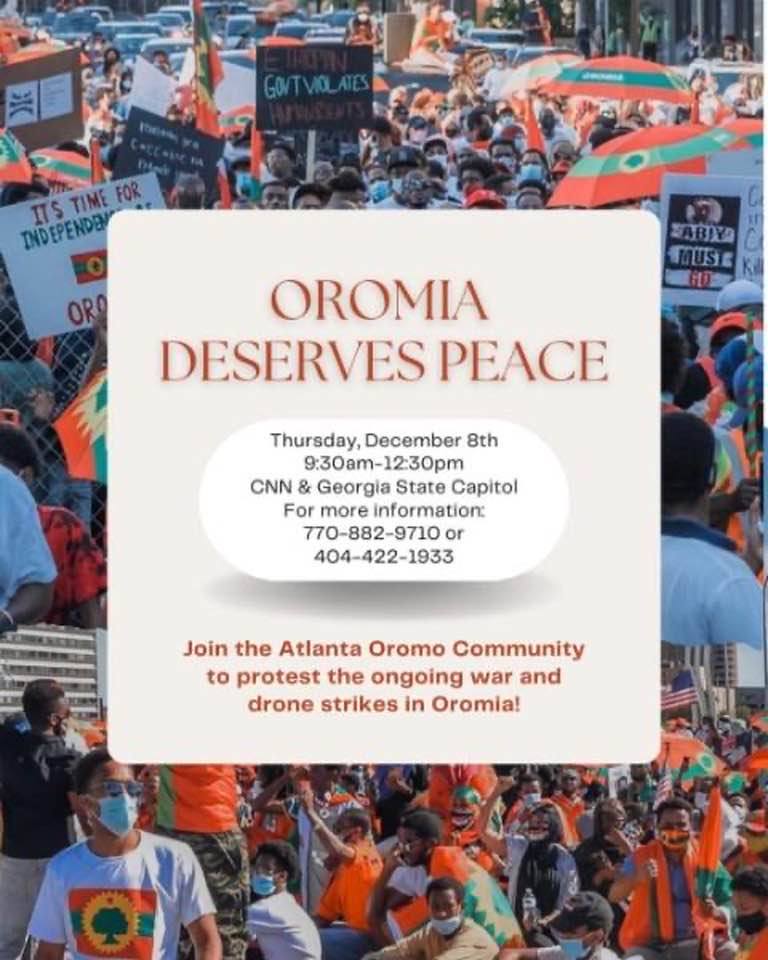
Background
Over the past few weeks, there have also been multiple reports of drone attacks and Fano attacks throughout western Oromia.
There have recently been reports of an escalation of violent attacks being carried out by the Amhara militia group known as Fano throughout Western Oromia, including in Anger Gutin, and Kiremu, in the East Wollega zone, the East Showa zone, and in Horo Guduru Wollega zone, where a video showing several members of Fano speaking in front of the decapitated heads of individuals from Jardega Jarte began circulating online.
These drone attacks have been reported most frequently in the West Wollega, West Shewa, and North Shewa zones, leading to the death of civilians. In one of these attacks, which took place on November 2, 2022, a witness told AP News that dozens of people had died, and hundreds were injured in Bila. West Wollega zone.
Most recently, we have heard reports of a drone attack in Wara Jarso, North Shewa zone on December 2nd, leading to the death of 80 civilians, and airstrikes in Sassiga, East Wollega zone on December 4th.
Social media reports have also been circulating of airstrikes in the Begi, Gidami, and Togo districts of West Wollega and Kellem Wollega zones on December 5th.
According to various reports, by beginning of December more than 350 people had died and 400,000 had been displaced due to drone sticks and Fano attacks throughout western Oromia.
Rights groups say the Oromo have been systematically marginalised and persecuted for the last 30 years. Some estimates put the number of Oromo political prisoners in Ethiopia as high as 50,000 as of December 2022.
World Bank Group Statement on Current Situation in Ethiopia

Multiple conflicts combined with historic drought and other shocks have severely impacted millions of Ethiopians, jeopardizing the economic and social development progress the country has achieved in recent years.
Consistent with our strategy to remain engaged in situations of conflict and fragility and to support greater resilience of Ethiopia’s people, the World Bank Group (WBG) remains committed to continuing its partnership with Ethiopia for the benefit of all Ethiopians. Accordingly, the WBG is supporting Ethiopia to address its citizens’ demands for basic human services such as education, food security, health, clean water, livelihood support, women’s empowerment, and social and environmental protection across the country.
Over the past decade, our support has helped Ethiopia make significant progress in key human development indicators: primary school enrollments have quadrupled, child mortality has been cut in half, and the number of people with access to clean water has more than doubled.
The WBG seeks to ensure that activities it supports are responsive to the needs of all people in Ethiopia. In particular, our Environmental and Social Framework (ESF) is applied to all Bank-financed operations. Among key ESF principles are requirements for nondiscrimination, meaningful consultation, effective public participation, property rights, accountability, transparency, and good governance.
We continue to monitor the situation on the ground across the entire country, and we sincerely hope for stability and a permanent cessation of hostilities in order to facilitate accelerated, inclusive development.
First Tigray, now violence escalates in Oromia
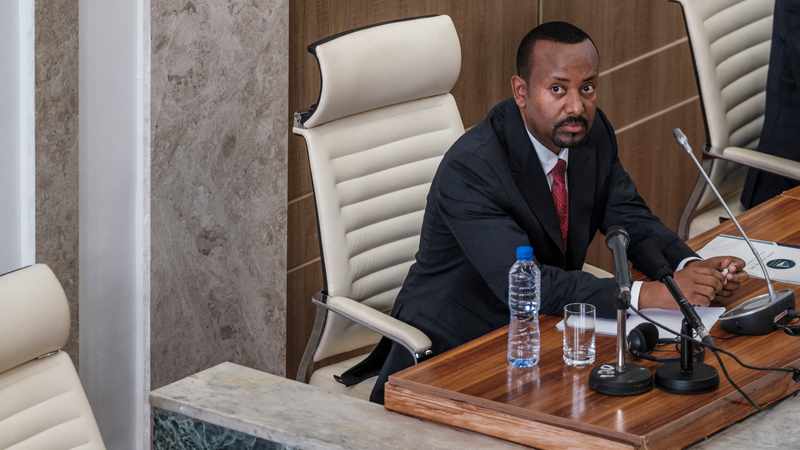
Ethiopian Prime Minister Abiy Ahmed has been under increasing global pressure to negotiate with Tigrayan officials to stop the carnage in the region, says the writer. Picture: Eduardo Soteras/AFP
By Asafa Jalata
In November 2020 an outbreak of violence in Ethiopia’s Tigray region captured worldwide attention. The conflict was between Tigrayan forces and the forces of the Ethiopian government and its allies.
Since then, Prime Minister Abiy Ahmed has been under increasing global pressure to negotiate with Tigrayan officials to stop the carnage in the region. Even before fighting broke out in Tigray, though, the government had established military command posts in Oromia, Ethiopia’s largest state. Oromo people were protesting and calling for self-determination.
In Oromia’s latest wave of violence in June, Al Jazeera, the New York Times and Reuters reported that hundreds of people were killed by the Oromo Liberation Army in Wallaga. These news reports labelled all the victims Amharas, members of Ethiopia’s second-largest ethno-national group. The Oromo are the largest.
As a scholar of Ethiopian politics and society, I’ve researched and written extensively on the Oromo movement and identified the historical forces that have shaped its current politics. My understanding – taking into account the history of oppression of the Oromo in Ethiopia and numerous reports by rights groups of attacks against the community – is that the violence in Oromia is mainly driven by the federal government and its agents.
The Oromo Liberation Army is responding to state terrorism and gross human rights violations. Oromo voices are not represented in the Ethiopian government, the global system or the media. The federal government and its allies, particularly Amhara elites and forces, blame the Oromo movement for the violence.
This is a strategy to delegitimise the Oromo struggle for self-determination. The Oromo consider themselves a nation. They are estimated to make up between 35% and 50% of Ethiopia’s 115 million people. An exact figure is difficult to come by as the government doesn’t provide this data.
Ethiopia has about 80 ethnonational groups. The Amhara make up about 27% of the population. Their language, culture, history and religion have dominated other ethno-national groups. Their warlords and leaders have dominated Ethiopia’s political economy for almost 150 years.
Despite their numbers, the Oromo consider themselves colonial subjects. This is because, like other subjugated ethno-national groups, they have been denied access to their country’s political, economic and cultural resources. Habasha (Amhara-Tigray) warlords colonised Oromia.
The region was then incorporated into Abyssinia (the Ethiopian Empire) in the late 19th century. Menelik II, the Ethiopian emperor, established a form of colonialism that settled Amhara, Tigrayan and other ethnic soldiers in Oromia. Most Oromos were reduced to serfs, providing free labour and tax revenue.
The colonial government claimed about three-quarters of Oromo lands for its officials and soldiers. It granted the remaining quarter to Oromo collaborators. In the 1970s, to oppose political, economic and cultural marginalisation, Oromo nationalists created the Oromo Liberation Front.
Its military wing is the Oromo Liberation Army. They wanted national democracy and self-determination, and participated in the failed revolutions of 1974, 1991 and 2018.
The Ethiopian state has continued to subject the Oromo people to violence and human rights violations. Successive Ethiopian governments have caused deep social, political, cultural and economic crises in Oromo society.
The government and the Oromo Liberation Front have blamed each other for the latest outbreak of violence in Oromia, particularly in Wallaga. A sub-group of the Oromo, the Macha, live in Wallaga. They have been targets of the Ethiopian government and expansionist Amharas, who claim to be the original owners of the region.
During the famine of the 1970s, desperate Tigrayans, Amharas and Oromos from elsewhere settled in Wallaga. Amhara expansionists began to call all these people Amharas to justify their claim to the territory. Prime Minister Ahmed has taken the side of Amhara expansionists.
Ahmed came to power in 2018 mainly because of the Oromo struggle but later turned against the movement. His vision is of a centralised state rather than self-determination for Ethiopia’s different groups.
The state’s ideology of “Ethiopianism” has been used to justify the subordination of the Oromo and other colonised peoples. It has empowered the class that dominates the bureaucracy, army, culture, Orthodox Christianity and Ethiopian colonial-political economy.
The Oromo Liberation Army, which has been outlawed and labelled a terror group, asserts that the government has created a clandestine security structure that masquerades as the Oromo army. It says this structure is responsible for the latest attack and those before it.
Between December 2018 and December 2019, in southern Oromia, government soldiers displaced 80 000 Oromos and detained more than 10000. An Amnesty International report found that state soldiers executed 52 people over this period on suspicion that they supported the Oromo Liberation Army.
The government additionally took incarcerated Oromos through mandatory training for several months. These detainees were trained on the constitution and the history of the Oromo people. These “lessons” were intended to get the detainees to abandon the quest for nationalism.
A July 2022 Human Rights Watch report termed the government’s actions in western Oromia “abusive”. It documented communication shutdowns, executions and arbitrary detentions. The global community must pressure the Ethiopian government to reach peace with the Oromo Liberation Army. However, this will only be successful if a neutral body mediates on behalf of the UN.
Ahmed’s government is willing to negotiate with the Tigrayan defence forces mainly because of the pressure from global powers. However, it refuses to reconcile with the Oromo Liberation Front and is determined to solve a political problem militarily.
Ethiopia cannot be at peace without an independent reconciliation body that solves the Oromo political problem fairly and democratically.
* Jalata is professor of sociology and global and Africana studies at the University of Tennessee.
The article was first published in The Conversation.
Tigray has resisted Ethiopia’s far greater military might for two years – here’s why neither side is giving in
By Asafa Jalata
The Ethio-Tigray war started on 4 November 2020. For almost two years, the governments of Ethiopia and Eritrea – along with Amhara regional forces and militia – have waged war against Tigray’s regional government and society.
Tigray is a tiny ethnonational group that makes up about 6% of Ethiopia’s population of 121 million. Yet, it has been able to hold off well-armed military forces.
As a sociologist who has written extensively on the cultures of nationalism in the region, I have studied the deep and complex roots of this conflict. I believe that understanding its history is key to comprehending how Tigray has developed the resolve to hold off a far greater military might than its own.
Neither the leaders of Ethiopia and Eritrea nor those of Tigray accept the principles of compromise, peaceful coexistence or equal partnership. According to their political cultures, winners take all. It’s zero-sum politics.
The war today
The Ethiopian National Defence Force captured Mekelle, Tigray’s capital city, on 28 November 2020. The Ethiopian army was helped by Eritrean and Amhara military forces.
Abiy Ahmed, Ethiopia’s prime minister, congratulated his army and allied forces for what looked like a quick victory.
However, the Tigrayan Defence Force made a tactical retreat. Its troops moved to rural areas and used guerrilla operations supported by war veterans. This strategy demonstrated Tigray’s effective fighting force, which was first developed in the 1970s.
As a result, eight months after the start of the war, Tigrayan troops returned to their capital. The Ethiopian army retreated from Mekelle and other cities.
Tigrayan troops then invaded the neighbouring Afar and Amhara regions, and almost made it into Finfinnee (Addis Ababa) in November 2021. However, they soon retreated to their region.
Since then, Tigrayan forces have controlled and administered most of Tigray.
The Ethio-Tigray war has been devastating for Tigrayans. They have faced mass killings, military bombardment, rape, looting and the destruction of property. The conflict has denied them access to food, electricity, telecommunications, medicine, banking services and other necessities.
Yet they support the Tigray Defence Force. To understand why requires a deeper reading of Ethiopia’s history.
A complex history
Two Amhara emperors and one Tigrayan emperor laid the foundation of the modern imperial state of Ethiopia. The first emperor of Abyssinia/Ethiopia was Tewodros (1855-1868). He was followed by Yohannes IV (1872-1889) of Tigray and then Menelik II (1889-1913).
Under Menelik II, the Amhara state elite replaced Tigray’s leaders. They made Tigrayan society a junior partner in building the Ethiopian empire.
But Tigrayan nationalists believe their society was the foundation of the Ethiopian state.
Read more: Ethiopia’s war in Tigray risks wiping out centuries of the world’s history
In the last decades of the 1800s, the Ethiopian empire expanded from its northern core of Tigray and Amhara by colonising the Oromo and other ethnonational groups.
It established slavery, the nafxanya-gabbar system (semi-slavery) and the colonial land-holding system by taking the land of conquered people.
The nafxanya (gun-carrying settlers) elite – led by the Amhara – dislodged the Tigrayan elite from Ethiopian state power. Tigray was pushed to the periphery of an Amhara-dominated society. This created political rivalry between the two groups.
The status and living conditions of the Tigrayan elite and people deteriorated. This, along with several wars in the region, aggravated political, economic and social problems.
Accumulated grievances and many forms of resistance produced the Tigray People’s Liberation Front in 1975. It aimed to liberate Tigrayans from Amhara-led governments. This helped develop Tigrayan nationalism.
Tigray’s two nationalisms
Tigrayans maintain two forms of nationalism.
The first promotes Tigrayan autonomy, self-reliance and development.
The second is Tigrayan Ethiopianism. This theoretically maintains Ethiopia’s current geopolitical boundary, with its decentralised political structures where different population groups have some autonomy.
After building military power in the 1980s, Tigrayan elite dominated other ethnonational groups, particularly the Oromo, the empire’s largest ethnonational group.
Between 1991 and 2018, the Tigrayan elite controlled state power and the political economy. The Tigrayan elite created a pseudo-democracy. The Tigray People’s Liberation Front was the mover and shaker of the Ethiopian state.
The Oromo expressed their collective grievances with this political arrangement through the struggles of the Oromo Liberation Front. The Qeerroo/Qarree (Oromo youth) movement got involved between 2014 and 2018. This eventually dislodged Tigrayan leadership from Ethiopian central power in 2018.
Abiy was a member of the Oromo People’s Democratic Organisation, a subsidiary political party of the Tigray People’s Liberation Front. The Tigrayan Front, alongside its allied organisations, elected Abiy as Ethiopia’s prime minister in April 2018. He later turned on his support base.
Once he came to power, Abiy and his allies believed they wouldn’t stay in control if they did not destroy Tigrayan and Oromo nationalists. These were symbolised by the Tigray People’s Liberation Front, the Oromo Liberation Front and the Oromo youth movement.
Zero-sum politics
Tigrayan and Amhara elites express and practice Ethiopianism differently.
The Amhara elite dominated Ethiopia from 1889 to 1991. The Tigray People’s Liberation Front overthrew them in 1991.
The wealth and experience Tigrayan elite accumulated over nearly three decades increased their national organisational capacity. This has helped them in the current war.
The Oromo have rejected the dominance and tyranny of both these groups. They have carried out their liberation struggle.
Abiy and his Amhara collaborators are fighting Tigrayans, Oromos and others to control Ethiopian state power. Their winning the war in Tigray and Oromia would allow the Abiy regime to continue a modified version of Ethiopia’s pre-1991 policy.
For Tigrayans, losing this battle would be equivalent to losing political power and returning to victimisation, poverty and the threat of annihilation.
Uncertain future
Given their complicated political history, reconciling the central government and the Tigrayan regional government is challenging. Even if these two groups negotiate a peace deal, conflict will continue if the Oromo are left out of the process.
If Tigray and Oromia’s political problems aren’t correctly understood and resolved, conflicts will continue until the collapse of the Ethiopian state.
This language was banned in Ethiopia just 30 years ago. Now, it’s being taught at Stanford
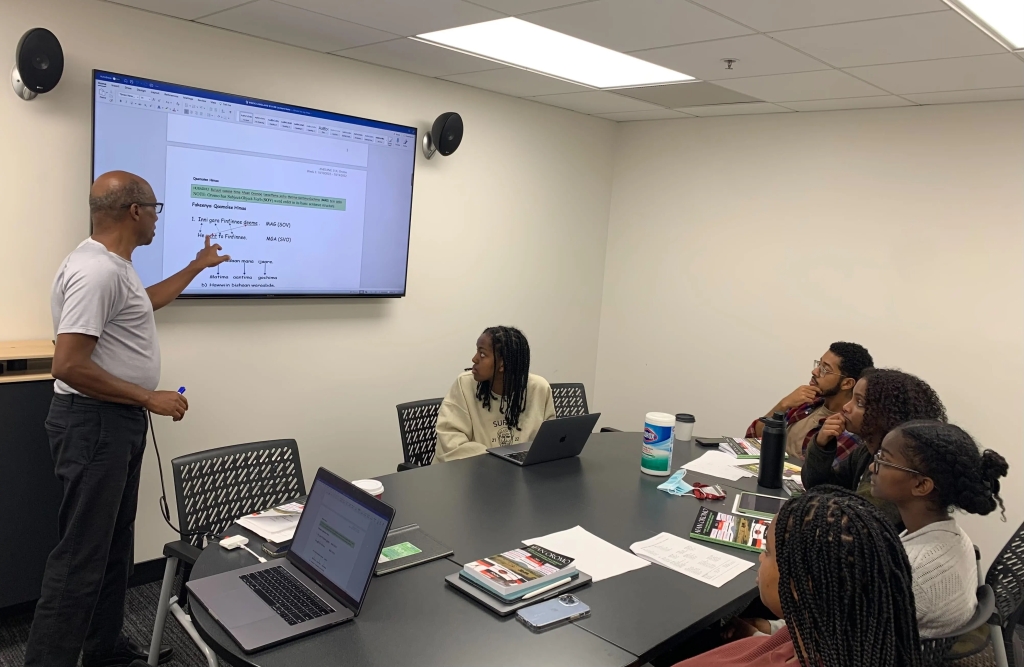
Oct. 20, 2022, 11:30 p.m.
Afan Oromo, a native language of Ethiopia, is being taught at Stanford for the first time this fall as a part of the Stanford Language Center’s African and Middle Eastern Languages Program (AMELANG) offerings.
Ethiopian emperor Haile Selassie banned Afan Oromo from being spoken, taught, or administratively used in the country in order to subdue the Oromo people and culture in 1941. After the ban was lifted in 1991, a push to give new life to the language began in and beyond Oromia and Ethiopia, led by native-born and diaspora Oromians, as well as non-Oromians. This push has now reached Stanford’s campus.
Among Stanford’s sizable East African student population, Saron Samuel ’25 along with Eban Ebssa ’25 told The Daily they sought to connect more with their heritage and put in a special language request last winter to get Afan Oromo added as a class. While their request was initially denied, they were told if they got at least one more interested student, the class might get funding. The special languages petition allows students to work with the university to add courses on less popularly taught languages.
Samuel sprang to action: “I sent the form in multiple group chats, reached out to people I knew would be interested in taking the class and posted on social media,” she said.
When the two had three more students commit to the class, the AMELANG Program expedited funding and hired a new lecturer, Afan Oromo teacher Belay Biratu, during the summer.
The University was able to add the course after a generous contribution from the Center for African Studies and in response to student requests, according to Coordinator of Stanford’s AMELANG Program, Khalil Barhoum. Afan Oromo is offered in a three-course sequence this year and will be the third Ethiopian language to be taught at Stanford, along with Amharic and Tigrinya.
Biratu told The Daily that he first learned the language secretly in the ’80s. He and other interested learners would meet in secret to explore the language. Although he was eventually caught teaching it to younger students and was punished severely for his actions, Biratu said he believes it was worthwhile, because he now gets to continue to teach the language and culture to those who seek it.
“In general, my view on teaching Afan Oromo is about doing justice to the culture. It is not against anyone, or any group. It is about doing justice to the people who are using this language as their mother tongue,” he said. “It is my passion and honest conviction that teaching language is doing justice to human culture.”
Biratu began this quarter’s class with an introduction of the sounds in Afan Oromo. Unlike English, Afan Oromo is a phonetic language and pronunciation is integral to its mastery, he said. He continues by teaching vocabulary, grammar and other foundational blocks of language-learning.
Biratu and his students consider themselves to be “pioneers who are paving the way at Stanford” for a greater appreciation and utilization of Afan Oromo.
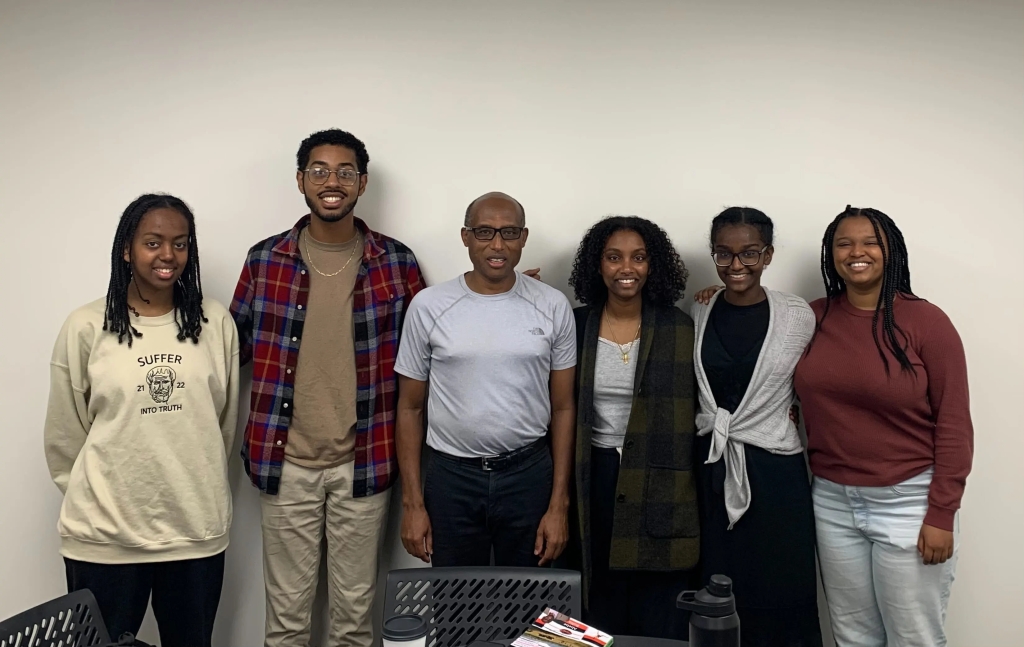
Hawi Abraham ’24 said she has been petitioning the Languages Department to add Oromo since her freshman year, but the petition was never successful until now. Like Samuel and other students, she sought to learn the language to connect with her heritage and her family.
“My grandma only speaks Oromo, and not knowing the language was blocking me from this connection with her in many ways,” she said.
Abraham said she was never able to learn the language because of the lack of resources. She recalled a time when her Bay Area community tried to mount an effort to offer a course in the language, but there were no teachers or materials available.
“That’s why when I got into Stanford I knew this was one of my only chances to finally learn,” Abraham said.
Abraham said that due to the language’s half-a-century ban, there’s a palpable sense of enthusiasm and pride, as well as triumph, in the classroom. “Every time I walk into class, there’s a genuine excitement in the air to get it right and make our communities proud,” she said. “My parents never got the chance to learn Oromo in school, so every time I walk into class, I am so grateful for the opportunity that I am given, that many were not afforded.”
“Every time I learn something new, I call my family and share it with them,” she added. “I want to show them that the youth are not giving up on their culture, we’re fighting for it.”
“I am now learning Oromo and Amharic, and hopefully Tigrinya in the future,” Samuel said.
Today, the language is widely recognized, as the most spoken language in Ethiopia and the third most spoken language in Africa, and it is the lingua franca of the Oromo region. Because the ban ended only three decades ago, Ethiopian universities and institutions are now working to standardize and teach the language. Biratu hopes Stanford will join the effort.
Feyera Hirpa, a native Oromian and current chairman in the Northern California Oromo Community, said he is excited about the addition of the new class at Stanford.
“The community is just so proud because Afan Oromo is now being taught at Stanford, one of the world’s best universities,” Hirpa said. “I hope, and share this hope with many members of the community, that this is the beginning of something large.”
Biratu shared similar sentiments: “When this kind of thing happens, the Ethiopian community is so happy, it has been a dream come true,” he said. “We are just so happy for Stanford.”
DHS Designates Ethiopia for Temporary Protected Status for 18 Months
Release Date: October 21, 2022
WASHINGTON – Today, the Department of Homeland Security (DHS) announced the designation of Ethiopia for Temporary Protected Status (TPS) for 18 months. Only individuals who are already residing in the United States as of October 20, 2022 will be eligible for TPS.
“The United States recognizes the ongoing armed conflict and the extraordinary and temporary conditions engulfing Ethiopia, and DHS is committed to providing temporary protection to those in need,” said Secretary of Homeland Security Alejandro N. Mayorkas. “Ethiopian nationals currently residing in the U.S. who cannot safely return due to conflict-related violence and a humanitarian crisis involving severe food shortages, flooding, drought, and displacement, will be able to remain and work in the United States until conditions in their home country improve.”
A country may be designated for TPS when conditions in the country fall into one or more of the three statutory bases for designation: ongoing armed conflict, environmental disaster, or extraordinary and temporary conditions. This designation is based on both ongoing armed conflict and extraordinary and temporary conditions in Ethiopia that prevent Ethiopian nationals, and those of no nationality who last habitually resided in Ethiopia, from returning to Ethiopia safely. Due to the armed conflict, civilians are at risk of conflict-related violence, including attacks, killings, rape, and other forms of gender-based violence; ethnicity-based detentions; and human rights violations and abuses. Extraordinary and temporary conditions that further prevent nationals from returning in safety include a humanitarian crisis involving severe food insecurity, flooding, drought, large-scale displacement, and the impact of disease outbreaks.
This will be Ethiopia’s first designation for TPS. Individuals eligible for TPS under this designation must have continuously resided in the United States since October 20, 2022. Individuals who attempt to travel to the United States after October 20, 2022 will not be eligible for TPS under this designation. Ethiopia’s 18-month designation will go into effect on the publication date of the forthcoming Federal Register notice. The Federal Register notice will provide instructions for applying for TPS and an Employment Authorization Document (EAD). TPS applicants must meet all eligibility requirements and undergo security and background checks.
Source: https://www.dhs.gov/news/2022/10/21/dhs-designates-ethiopia-temporary-protected-status-18-months
Oromos celebrate Irreechaa thanksgiving festival
(A4O, 2 October 2022), Thousands of Oromo people, Ethiopia’s largest ethnic group, came together in the capital on Saturday to mark the thanksgiving festival of Irreechaa; marking the end of the rainy season.
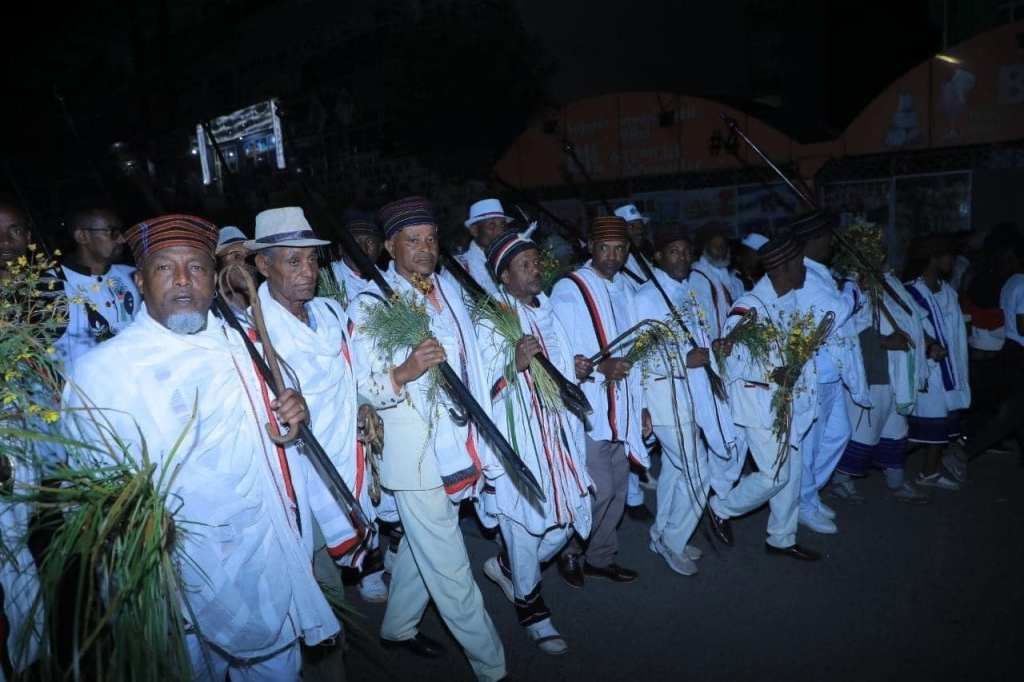
As well as traditional celebrations, including dipping flowers in water, the participants appealed for peace.
Violence has increased in the Oromia region due to long-standing complaints about a lack of political representation in Ethiopia’s federal government.
Armed militants and government forces are fighting in several locations in the region
College student, Hanan Dawud, said: “Justice should be served for those whose blood is spilt on the street and burned with their house.
“Our people should not suffer like this. Our farmers couldn’t send their children to school and farm their fields. We have to work together to solve this.”
University student, Latera Reta, added: “Currently, there is vast repression on the Oromo people. However, the Oromo people are not surrendering to it. We are overcoming oppression and securing freedom.”
Prime Minister, Abiy Ahmed said Irreechaa was a festival celebrated by all nations, nationalities and peoples of Ethiopia.
The Premier further urged Ethiopians to praise God for enabling them to overcome both manmade and natural challenges posed by enemies of the nation and welcome the brighter spring season.
He said the celebration promoted peace and love.
Irreechaa Festival Celebration Kicks Off At Hora Finfinnee
(A4O, October 1, 2022) – The Irreechaa Festival, the thanksgiving festival among the Oromo people has kicked off at Hora Finfinnee in the presence of thousands attendants, Aba Gadas, Haadha Siinqees, and guest from various countries.

Thousands from across the nation clad in colorful attires and costumes have gathered at Hora Finfinnee, God for the bounty of nature and the brighter spring season.
People in groups have flocked to Hora Finfinnee chanting songs, brandishing clubs painted in the Aba Gada tricolor of black, red and white.
Elders are calling Gada chant blessings in melodious intervals to the Almighty God while celebrants responding in a ritualistic manner.
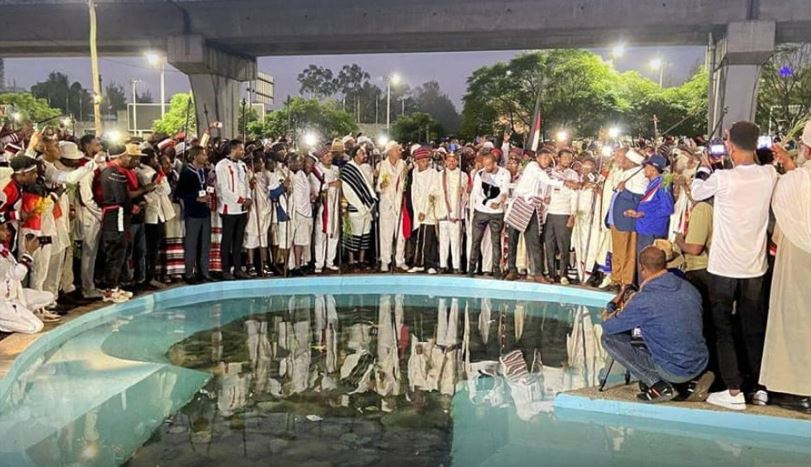
Ethiopian Oromo’s quest for self-determination
By Bernard Muhia
19th Sept, 2022, Nairobi, Kenya.
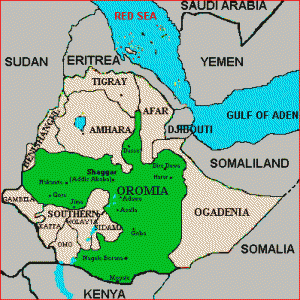
No one is free until everyone is free! This statement by Fannie Lou Hamer, filled the air this past weekend at a bookshop in the heart of Lavington, Nairobi. Hamer, an African-American woman who pushed for the civil rights movement in the 1960s led in community organizing to get black people in America to register as voters despite police harassment and death threats from the Ku Klux Klan (KKK).
In an almost similar scene, a female storyteller from Ethiopia was doing the same last weekend. Soreti organized a solidarity session for her Oromo people from the south of Ethiopia. The session was set at a bookshop/ bookclub cafe where books were in shelves on the walls and this was very symbolic because the session was meant to be an exchange of knowledge, information and ideas. The Oromo word for book is “Kitaaba” which has Arabic influence and close to “Kitabu” which is book in Swahili, another language with Arabic influence. The Oromo are 60% Muslim and 40% Christian. Then there is a small population that practice Waaqeffannaa, the traditional Oromo religion.
Soreti spent over six hours moderating a very engaged audience made up of Kenyans and Ethiopians. Her sheer presence and eloquence inspired a deep exchange of ideas and information about the various conflicts in Ethiopia and specifically for the Oromo people. There are also Oromo people in Northern Kenya. The Ethiopian Oromo extend all the way to Addis Ababa. The name Addis Ababa means ‘new flower’ and was given by Empress Taytu Betul, wife to Emperor Menelik II during his reign. The Oromo call Addis Ababa “Finfinne”.
Emperor Menelik II, also known as Sahle Maryam was Emperor of Ethiopia from 1889 to 1913 when he died. Previously, he was the King of Shewa from 1866 to 1889. He amassed great power and was highly regarded outside of Ethiopia largely due to his defeat of the Italian invaders at the battle of Adwa. He continued to expand his empire through peaceful negotiations with neighbouring kingdoms and where that wasn’t possible, he exerted crushing military takeovers where the resisters were tortured, maimed and/or starved to death. This territorial expansion facilitated the creation of the modern empire-state of Ethiopia in 1898. Menelik expanded his empire-state to the south and east, into Oromo, Kaffa, Sidama, Wolayta and other kingdoms or peoples.
The Oromo still view the Ethiopian state as an extension and expansion of the Menelik empire. We say Ethiopia wasn’t colonized but the Oromo say they were colonized by Menelik II and have never been decolonized, that they are still being colonized even now, through the state.
Despite the seat of the African Union Commission being in Addis Ababa, there is so much oppression and state violence against almost all ethnic people all over Ethiopia including the Oromo and Tigray to say the least. It had gotten so bad that according to Soreti, speaking their native Afaan Oromo language was not permissible from 1941 under the Haile Selassie rule up until 1991 when the DERG fell. Their culture was considered inferior to those of other communities. Their community faces discrimination and underdevelopment despite being rich in resources. The resources are merely taken out of Oromia and used to develop other regions and very little is invested back. This is despite the fact that the Prime Minister Abiy Ahmed is from the Oromo community. His coming to power was meant to soothe unrest and the grievances of the minorities.
However, some view him as a puppet for the state. He was awarded the 2019 Nobel Peace Prize for his efforts at ending the 20-year post-war territorial stalemate between Ethiopia and Eritrea. He has since enlisted Eritrea in his onslaught of the Tigray region which borders Eritrea. Eritrea was once a province of Ethiopia but managed to gain independence and self-rule.
The Oromo desire for self-determination and justice. Justice in the Oromo language is “Haqaa” which is close to Haki which is Swahili for Justice. Haqaa, according to the crowd present on the day, means deciding their own fate, deciding how their resources are used and being free to express themselves in their language, their culture and their political aspirations.
Soreti talked about Pan-Africanism and the need for Africans to band together to fight injustice everywhere on the continent. She walks in the footsteps of other great Pan-Africanist women like Jeanne Martin Cissé from Guinea who was instrumental in the independence of Guinea. She went on to become the first African president of the United Nations Security Council in 1972. She lobbied for and passed two resolutions, one condemning Apartheid in South Africa and the second one condemning Israel’s aggression against Palestine.
The second Pan-Africanist woman that Soreti walks in the footsteps of is Funmilayo Ransome-Kuti (FRK) who was a Nigerian activist. She was the first woman to be in a high ranking position at the National Council of Nigeria and the Cameroons. She was also the first woman in Nigeria to drive a car. Funmilayo’s son, Fela Kuti, grew up to be a very popular musician and created Afrobeat, a political musical genre that was very Pan-Africanist. His mother influenced his music a great deal.
Women are often casualties of war, however women’s involvement in war has, according to Soreti, given them a greater chance at advancement and promotion on the basis of merit more than anywhere else in Ethiopian society. Women in Ethiopia still face many inequalities. The United Nations says that women’s participation at the political level has resulted in greater responsiveness to citizen’s needs, often increasing cooperation across party and ethnic lines and delivering more sustainable peace. At the local level, women’s inclusion at the leadership level has led to improved outcomes of projects and policies. On the contrary, if policies or projects are implemented without women’s meaningful participation it can increase existing inequalities and decrease effectiveness. Soreti has risen from being a mere storyteller to a political activist and a force to be reckoned with.
Members of the Mathare Social Justice Center who were present had a feminist chant in support of women which goes like this “Women on the frontline, organize, educate, liberate and celebrate. They also advocated for Oromo women to join both the political and military wings of the struggle.
As a first hand immersion into the Oromo culture, the crowd was treated to Ethiopian cuisine. The main dish which looked like pancakes was a flat bread called Budena. It was the colour of porridge (sorghum) and was served with stew known as Shiro.
There were Oromo present who didn’t speak English and thus the session was translated to Afaan Oromo. It was a cultural exchange that left everyone feeling more connected. It opened the eyes of the Kenyans in the room to the plight of Ethiopians.
Irreechaa 2022
The Melbourne Irreechaa organsiing Committee has announced that it will be celebrating this year’s Irreecha Birraa on October 2, 2022 at Wilson Botanic Park Berwick (668 Princes Highway, Berwick, Vic 3806).
The Committee also called on the Oromo community in Melbourne, Australia to celebrate the Oromo Thanksgiving event in a warm and beautiful manner.
Irreechaa Celebration to be Held in Melbourne, Australia
By Maatii Sabaa
(Melbourne, Irreechaa, August 30, 2022)-The Oromia Irreechaa Organising Committee in Victoria is preparing to celebrate Irreechaa in Melbourne on 2nd October.
Head of the Committee, Ob Abdeta Homa said the celebration is to strengthen and promote Oromo culture, particularly the Irreechaa celebration in Melbourne.
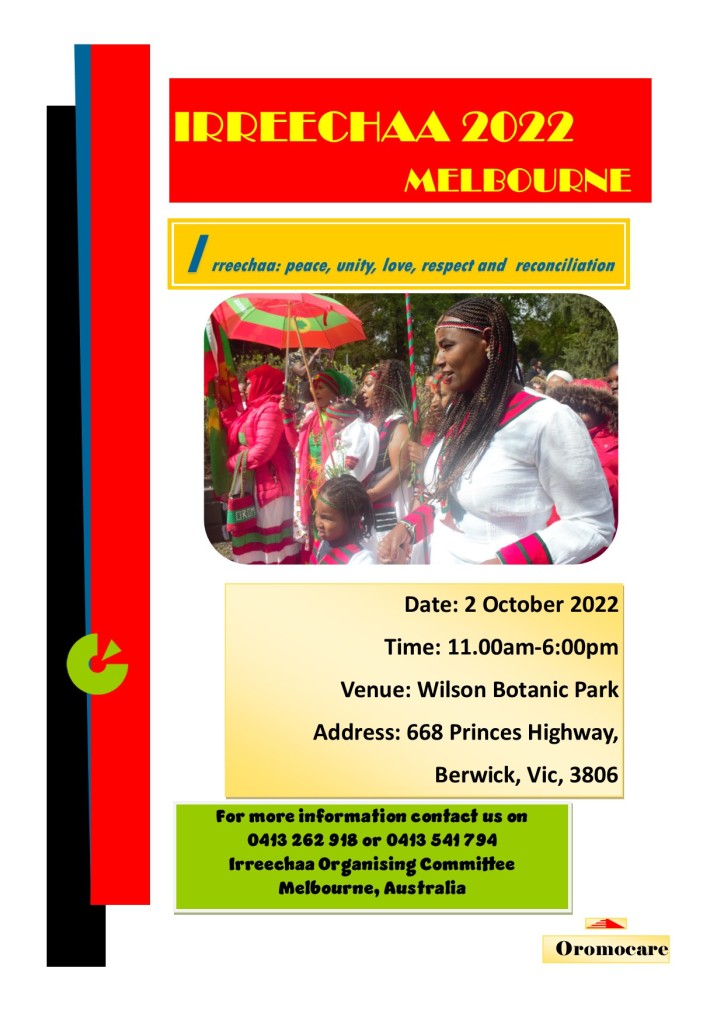
Hawaasti Oromoo Australia Ayyaana Irreecha Arfaasaa kabajatan
(A4O, 12 Waxabajjii 2022) Hawaasti Oromoo Australia Melbourne ayyaana Irreecha Arfaasaa baranaa Waxabajjii 12 bara 2022, haala hoo’aa fi miidhagaan kabajatan.

Ayyaanni Tulluu bakka Kokoda Memorial Park jedhamu irratti kabajame kun, akkum aadaa Oromootti eebba angafootaan eegalame. Angafoonnis hirmaatota ayyaanichaa eebbisuun, Waaqni Uumama maraaf nagaa fi araara akka buusu kadhannaa godhan.
Ayyaana Irreecha Arfaasaa kana irratti dhaloota ayyaana Irreechaa jiraachisuuf, keessattuu bara 2016 dhumaatii Irreechaa Harsadii irratti wareegamaniif yaadannoo godhaniiru.
Sirnicha irratti akka ibsametti, Ayyaanni Irreecha Arfaasa kun baroota lamaan darban sababa COVID-19 addaan cite ture. Yeroo sanatti, immoo afuurri ayyaanicha akka hin badneef, sadarkaa maatiitti akka kabajamu godhamuu qindeessitoonni himanii jiru.
Barana haalli waan jijjirameef, hawaastni bakka tokkotti dhufee ayyaanicha kabajuun hedduu gammachiisaa ta’uu hirmamtonnis dubbataniiru.
Ayyaana kana irratti ummanni seerota fi qajeelfamoota karaa mootummaa bahan hordofuun akka balaa COVID fi qufaa irraa ofii fi maatii isaanii eegan dhaamsi darbeera.
Irreecha Arfaasaa maal?
Irreechi Arfaasaa ayyaana galateeffannaa Oromoo kan waggaa waggaan al tokko xumura yeroo gogiinsaafi jalqabbii yeroo roobaa keessa kabajamuu dha.
Sirnichi eebbaa fi ogummaa jaarsoliif kabajaa ni qaba; hambaa kunuunsuu, madaalli guddina dhala namaa fi eegumsa naannoo waloomsuuf ni gargaara.
Ayyaanni Irreecha Arfaasaa fiixee gaarren, tulluu fi lafa olka’aa biroo irratti kabajama. Sababiin isaas lafti kun gatii jireenyaa fi uumamaa bakka bu’a jedhanii waan amananiif.
Akkasumas, ayyaana kana irratti angafoota aadaa fi seenaa Oromoo jiraachisuuf obsaa fi kutannoo agarsiisaniif – injifannoo hawaasummaa dabalataaf karaa saaquu –galateeffannaan ni godhamaaf.
Ayyaanni Irreecha Arfaasdaa aadaa, seenaa fi uumama Oromoo miidhagsuu yeroo bonni xumuramuuf jedhu yookaan yeroo ganni seenuuf haala adda ta’een kabaju.
Kaayyoo fi Hiika Irreechaa
Irreechi guyyaa galateeffannaa Oromoo ti. Ayyaanni Irreechaa waggaatti yeroo lama: Irreechaa Malkaa fi Irreechaa Tulluu, gamtaadhaan kabajama.
Ayyaanni Irreechaa mata duree aadaa fi eenyummaa irratti kan xiyyeeffatu waan ta’eef, miseensota hawaasaa duudhaa isaanii beeksisuudhaaf gargaara. Ayyaana kanarratti jaarsoliin seera, safuu, duudhaa, seenaa fi muuxannoo isaanii hawaasaaf qooduun, tokkummaa maatii fi hawaasaa eeguuf unkaalee jireenya kaa’u. Sirnichi eebbaa fi ogummaa jaarsolii kabajuu, hambaa kunuunsuu fi guddina dhala namaa madaaluuf gahee guddaa qaba.
Guyyaa kana namoonni fiixee gaara irratti yookaan qarqara Malkaatti walitti qabamanii Waaqa isaanii hundumaa danda’u galateeffatu; ammaa fi egereef immoo Araaraa, Nagaa, Walooma fi Finnaa ( Misooma Waliigalaa) akka isaaniif baay’isuuf ni kadhatu.
Irreechaan duudhaa ayyaana gaarii kan Oromoon Uumaa kabajuu fi galateeffachuuf tolfatee dha.
Faayidaan Ayyaana Irrecha maal?
Ayyaanni Irreechaa yeroo ummanni walitti dhufee gammachuun Waaqa galateefaftu. Kun immoo akka dhalli namaa yaaddoo guyyuu, dhiphuu fi jeequmsa keessaa bahee ayyaan gaarii waliin dabarsu godha; guyyaa tokkoofis ta’u, dhiphuu fi yaaddoo hunda dagannee jireenyaa gaarii kabajuuf carraa nuuf kennan; guyyoota muraasaaf yoo ta’ellee, gara jiruu nagaa qabu jiraachuutti dhufna.
Ayyaana akka Irrechaa kabajuun dhiphina karaa adda addaa nutti jiru nurraa hir’isa. Kana malees, Ayyaana gaarii nuuf baay’isa; miirota nu laaffisan immoo nurraa xiqqeessa.
Akkasumas ayyaanni Irreechaa wal-dhabdee namoota gidduu jiru hir’isuuf carraa nuuf kenna. Yeroo kanatti, hiriyootaa fi firoota adda ba’an walitti deebisee araarsuufi hariiroo jaalalaatiin walitti fiduuf nu gargaara.
Irreechaa fi COVID
Ayyaanni Irreechaa ayyaana gamtaan walitti bahanii kabajatanii dha. Haata’uutii, yeroo COVID babal’ate keessa gamtaan walitti dhufuun dhukkibicha daran babal’isa. Sababa Kanaan yeroo COVID keessa Ayyaanni Irreechaa akka addaatti kabajamuu eegale. Bakka seerri walitti qabama hawaasaa dhorkutti, ayyaanicha sadarkaa maatii qofaatti kabajuun dirqama ture.
Hawaasti Oromoo biyya Australia keessa jiraatan, fakkeenyaaf, waggoota lamaan darban ayyaanicha sadarkaa maatiitti kabajachaa turan; haala kabaja ayyaanichaa immoo karaa Zoom walitti dhufanii yaada walifi dabarsaa, suuraalee ayyaanicha akan sadarkaa maattiii gagggeefaftan waliif qoodaa fi miidiyaa hawaasaa irratti walifi qoodaa turan. Bakka seerri akka namootni muraasti walitti dhufan hayyametti immoo hawaasa lakkoofsa xiqqaa ta’an walitti dhufanii kabajachaa darban.
Seenaa Duubbee
Ummanni Oromoo Irreechaa Waaqaa galateeffachuu qofaaf osoo hin taane, yeroo qorraa kan roobaan waliin walqabate simachuuf kabaju. Ayyaana Irreechaa irratti hiriyyoonni, maatiin, firoottan walitti qabamanii gammachuu ayayaneffatu. Ayyaanni Irreechaa namoota walitti dhiheessuun, gamtaa hawaasummaa ni uuma. Aadaan kun baroota hdeeraaf kan itti fufee kabajamaa jiruu dha.
Afoola Oromoo irra akka hubatamutti, ummanni Oromoo yeroo Arfaasaa ayyaana gaariin kabajuu kan eegalan, xumura waqtii gogiinsa, kan Bona jedhamuun beekamu gaggeessuf, akkasumas yeroo roobaa, kan Ganna jedhamuun beekamu simachuuf ture.
Angafoonni Oromoo akka himanitti, ayyaanni kun, bara Gadaa Melbaa keessaa hundeeffame. Ayyaanni Irreecha Arfaasaa kun bara dheeraaf otuu addaan hin citiin kan itti fufee jiruu dha. Bara ammayyaa kanattis, ummanni Oromoo yeroo Birraa Malkaatti, yeroo Arfaasaa immoo Tulluutti bahuun gamtaan Waaqa galateeffachaa fi kadhachaa jiru. Irreechi waggoota 6400 oliif ummata Oromoo biratti kabajamaa tureera.
Australian Oromo Community Celebrates Irreechaa Arfaasaa.
(Oromedia, June 12, 2022) The Oromo community in Melbourne, Australia celebrates the Irreecha Arfaasaa festival in a grand manner.

The festival, which is celebrated on June 12, began with a blessing by the elders. Oromo mothers and fathers prayed for peace and mercy to all creatures.
The celebrators also offered silence of remembrance and prayers for the martyrs of the 2016 Irreecha massacre and those who paid their sacrifices to pass on the tradition of Irreechaa.
The Irreechaa festival was cancelled for the past two years due to the COVID-19 pandemic. According to the organisers, it would celebrate at the family level to preserve the spirit of the holiday.
Participants said they are happy to celebrate the Irreecha Arfaasaa together with their community in this year celebration held at Kokoda Track Memorial Walk (1000 Steps).
On the occasion, the people are urged to follow the laws and guidelines issued by the government to protect themselves and their families from the dangers of COVID and flu.
Irreecha Arfaasaa Spirit
Irreecha is a day of thanksgiving celebrated in the hills or mountains at the end of the dry season and the beginning of the rainy season.
The Oromo people who go to the mountains for this event not only gather for thanksgiving but also to pray for the achievement of Araaraa (reconciliation), Nagaa (peace), Waloomaa (harmony) and Finnaa (holistic development).
Irreecha celebrated on the top of the hills or mountains is called Irreecha Arfaasaa. Sometimes, it’s also called (‘Festival of the Good Spirit’). This festival is celebrated by the Oromo people in May/June.
Two seasonal Irreechaa
Traditionally, Oromo people celebrate two seasonal Irreechaa festivals nationwide. One is Irreecha Birraa that is celebrated in late September (or early October) during the sunny season and the late rainy season.
The second one is Irreecha Arfaasaa which is celebrated during the rainy season (i.e., the harvest season). This seasonal Irreechaa is celebrated to bring good spirit with rain and heat; By the way, mothers spread their seeds on the ground during the rainy season only to ensure that the last seeds will be turned into humans.
Purpose and Meaning
Irreecha Arfaasaa is an annual Oromo Thanksgiving Day that is repeated once a month in May or in June.
On this day, people have a ceremony to thank their ancestors for their determination to continue their culture and history. The dry season ends (October to April and the rainy season begins (May to September).
Respecting nature and being grateful for life are an Oromo good spirit culture. Its ceremonies celebrate the blessings and wisdom of the elders, preserve the heritage, and appraise the growth of the human child.
The Importance of Irreechaa Festival
Irreechaa festivals have a great contribution to social cohesion. Because the festival focuses on cultural issues, it helps to recognise community members and their values. During the festival, community elders share traditional laws, culture, legends, and customs with the community with examples of how to maintain community and family unity.
Irreechaa provides the opportunity to forget all our worries and celebrate the good aspects of our life. It helps us to keep our emotions balanced and to reduce negativity in our life. It also provides an opportunity to reduce unhealthy habits and unites conflicting neighbours and relatives in a loving bond.
Irreecha brings together people from all religious, economic and social backgrounds.
Historical Background
The Oromo people celebrate Irreechaa not only to thank Waaqa (God) but also to interact with nature and welcome the new rainy winter season. On Irreechaa festivals, friends, family, and relatives gather together and celebrate with joy and happiness.
Irreechaa festivals are a festival stage that brings people together and shares good values that create social bonds. Moreover, the Oromo people celebrate this exciting winter festival to welcome the beginning of winter and winter with joy.
Irreechaa was founded by Oromo ancestors in Gadaa Meelbaa in Mormor, Oromia. The auspicious day on which this last Mormor Day of Gadaa Belbaa — the Dark Time of starvation and hunger- was established on the 1st Sunday of last week of May or the 1st Sunday of the 1st week of June according to the Gadaa lunar calendar. It was celebrated as the second winter Thanksgiving by the modern Oromo people.
Irreecha has been celebrated by the Oromo people for over 6400 years.
Irreechaa Arfaasaa 2022
Irreechaa Arfaasaa is a day of thanksgiving at the end of dry seasons and beginning of rainy season every year at the top of hills or mountains to acquire and celebrate good spirit. For this event, the Oromos usually go to the mountain during the time of their worshiping rituals, or during Irreessaa celebration.
Purpose and Meaning
Irreecha Arfaasaa is another annual Oromo Thanksgiving Day that repeats once in May to mark the end of the dry season and beginning of the rainy and planting season. It marks the end of the dry season (October to April) and the beginning of the rainy season for planting (May to September). It is a unique Oromo cultural, historical and natural beautification (planting) in their full glory at the height of the season.
On this day, people come to gather on mountain tops to give thanks to the almighty Waaqaa (God) for all the blessings throughout the past dry season and ask for Araaraa (Reconciliation), Nagaa (Peace), Walooma (Harmony) and Finnaa (Holistic Development) for the present and the future. There is also a ceremony of thanking all forebears for their endurance and determination to survive their culture and history – paving the way for further social victory. Irreecha Arfaasaa has been observed by the Oromo people for more than 6400 years. The ceremony honors elders’ blessings and wisdom, preserves the heritage and assesses the progress of humanity.
We warmly invite you to join us at the 2022 Irreecha Arfaasaa festival at Kokoda Track Memorial Walk. It is an Oromo Good Spirit tradition of respect for nature and gratefulness for life.
Venue: Kokoda Track Memorial Walk (1000 Steps),
Address: Tree Fern Gully Track, Tremont, VIC, 3785
Date: June 12, 2022
Time: 11:00AM – 4:30PM
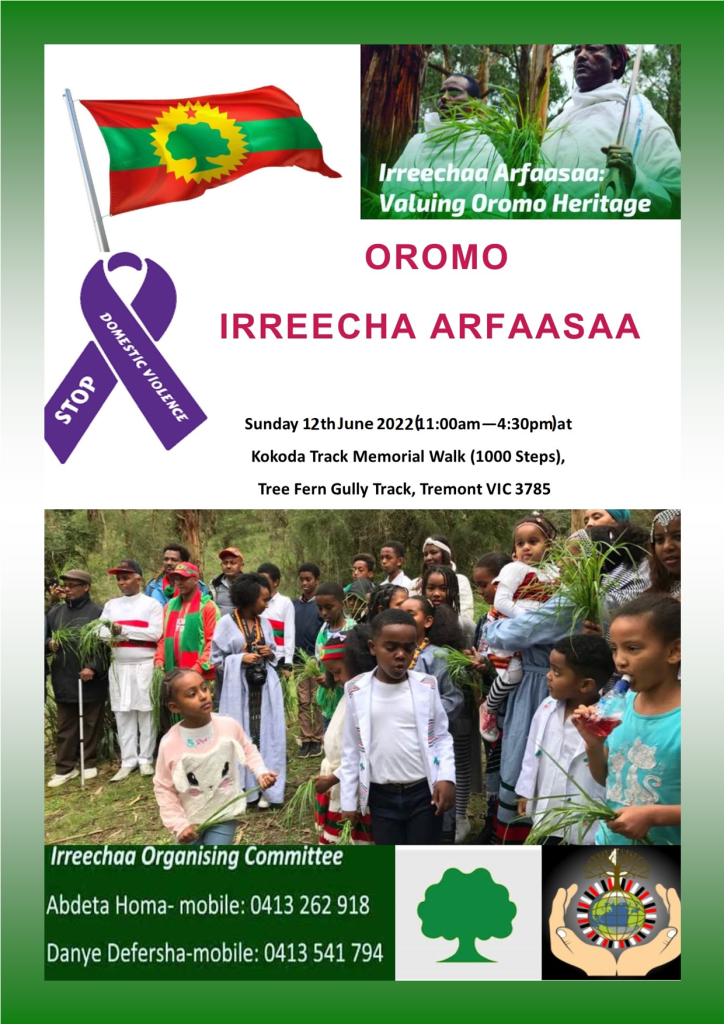
Make an End to Ethiopia’s State Terror
An Urgent National Call
May 2022
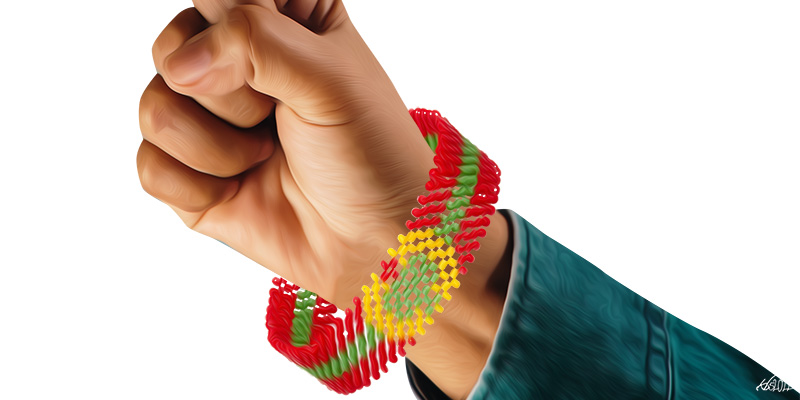
Gurmuu Hayyoota Oromoo – Oromo Intellectual’s Society (GHO-OIS), after due deliberation on the current situation in Oromia and Ethiopia, particularly on the ongoing state terror and ethnic genocide directed at the Oromo Nation, makes the following calls upon all Oromos and friends of Oromo National Cause as a matter of urgency.
Key Notes:
At the present, the clique that wields state power in the name of the so called “Prosperity Party” in Ethiopia, has deployed all armed forces at its disposal (including foreign forces) and is committing indiscriminate mass killings and systematic genocide against the Oromo people.
The ruling party in Ethiopia has declared a systematic war against the Oromo people to eradicate Oromumma (Oromoness) and the Oromo as a nation, in a bid to renew the imperial policy of creating a unitary state under Amhara political, cultural and economic hegemony. It deployed the Ethiopian National Defence Forces, Special Forces of Oromia, Amhara, Somali and other regional states, the Amhara organized bandits called “Fanno” and units of the Eritrean military ostensibly to wipe out the Oromo Liberation Army (OLA). These forces are rather killing Oromo civilians indiscriminately and with utmost brutality, looting and plundering private properties and burning down whole villages and farms like an invading foreign army of bygone times.
Although many regimes of different political makeup have risen and fallen in Ethiopia since its creation as a colonizing imperial state by king Minilik of Abyssinia, each successive regime failed to resolve its foundational predicament and thus continued on a path of repression and suppression of the quest of the colonized nations and nationalities for freedom and equality with increasingly systematic vigour and brutality. The current war of the ruling elite under the so called “Prosperity Party” against almost all the peoples of Ethiopia in general, and Tigray and Oromia in particular, is a continuation of this political culture and a clear testimony that repeated endeavours to transform the empire has unquestionably failed once again, proving that this empire can’t be democratized.
Clearly, the current ruling clique, continuing repressive and suppressive methods of the past in a more vicious manner, is conducting not only systematic ethnic and cultural genocide but also demonstrated acts of fascism against the people it is supposed to govern.
The only option left for the Oromo nation to free itself from 150 years of cyclic repression, exploitation, war and humanly suffering, and particularly to save itself from the current wholesale killings and total war of genocide, is consequently intensifying its current armed struggle led by the Oromo Liberation Army (OLA) to make an end to Ethiopia’s colonial occupation of Oromia.
Noting that saving the Oromo people from armed violence, state terror and mass murder now engulfing the whole of Oromia is the historic burden and responsibility bearing upon the current generation of Oromo sons and daughters;
Bearing in mind that the only option to end the vicious cycle of colonial repression and war of exterminating the Oromo as a nation is for Oromos from all walks of life to set aside minor political differences, and unite and bundle our human, material and intellectual resources to liberate our Nation from the yoke of colonial subjugation;
GHO/OIS calls upon all Oromians to rise in unity to discharge the historic responsibility we bear in common to liberate the Oromo, the last great nation that is still languishing under colonial yoke in the 21st century.•
I. Root of the Problem: Continuation of Colonial Rule
The Oromo is a great nation that counts the Horn of Africa as its origin and the cradle of its egalitarian Gadaa system and civilization. The Gadaa system is the epitome of equality and democracy, which has served as the administrative, cultural and psychological basis of the Oromo people for thousands of years.
However, through the invasion of kings Yohannes IV and Minilik II of Abyssinia starting in the 1870’s, the whole of Oromia was conquered and became part of the present Ethiopian empire. As a colonial subject, the Oromo nation has been subjected to abhorent repression, systematic exploitation of its human and material resources, and cultural genocide through prevarication of its history and attempted eradication of its language and culture. These colonial repressions aimed at cultural and ethnic genocide are being conducted by the current fascist regime in Ethiopia in a more systematic and vicious manner.
The aim of a colonizer is not only to occupy the invaded land, dispossess the indigenous people of their material wealth and labor produces and destroy their culture and identity, but also to eliminate the elites of the conquered people to root out potential leaders of resistance against the alien rule. Through such a brutal policy, the colonizer denies the subject nation of its own elites that could keep its history, culture and language for next generations, thereby leading to the eradication of cultures and languages of colonized peoples.
History of the Oromo nation under the subjugation of the Ethiopian empire bears witness to such extensive colonial repressions:
a. During the invasion by kings Yohannes and Minilik of Abyssinia, millions of people in Oromia and the current Ethiopia’s South were killed in wars of resistance or were rounded up and sold into slavery. Million others perished as a consequence of famine that followed an intentional spread of cattle plague. Historical documents show that the population of Oromia was reduced by half and some other smaller ethnics were brought to the brink of extinction. The land of the indigenous peoples was carved up among the invading army of Minilik and the natives who survived the devastation were made “Gabbar” – a brutal form of slavery – in which wholes families were made to toil their ancestral lands to feed and serve families of the new colonizers. The Ethiopian Orthodox Church also got its share of the booty according to its ancient pact with Abyssinian kings.
b. Emperor Haile-Silassie‘s regime, not only intensified the Gabbar system, but also embarked on the project of ‘modernizing’ his empire, in which all other languages except Amharic were banned from use in schools and public institutions. Orthodox Christianity and the Amharic language and culture were promoted as ‘national’ religion and culture, whereas all others languages and cultures were banned to gradually wither away. The aim was to amharanize (convert to Amhara) all the subjugated peoples into a one language – one culture – one religion unitary state.
c. The Dergue communist military dictatorship that ousted Haile-Silassie, in a bid to pacify the central ‘Land to the tiller’ demand of student movements against the Gabbar system, first declared all land in Ethiopia to be government property. It then exacted more onerous dues and services from the peasantry than before. To better control the rural population from supporting the various liberation fronts fighting against it, the regime embarked on Stalinist collectivization of peasants into villages. For additional control, the regime also settled northern farmers in the South and among the Oromo. Through consequent starvation and government killings in the name of fighting the rebels, millions of civilians lost their lives. In a vicious move, the regime also destroyed many Oromo religious centers and irreplaceable cultural artefacts.
d. After the Dergue was overthrown through the armed struggle of the Oromo and other rebel groups in 1991, an experiment at a system of ethnic federation began, in which the current borders of Oromia were demarcated and Afaan Oromo became the official language in Oromia. However, the TPLF from Tigray, which militarily monopolized state power, reduced the federal arrangement to the status of Haile-Silassie’s governorate generals, and similarly ruled from the centre through satellite organizations it created in the name of the various nations and nationalities in the empire. Oromia and other regions were more systematically looted and exploited to build Tigray and enrich Tigrayans. Evicting Oromo farmers at gun point, their farms were sold to the so-called investors and lands around cities especially around Finfinnee were carved up among the new Tigrayan rich and their lackeys to build villas and high rise buildings. Those who protested against these brazen dispossessions and consequent wiping out of innumerable Oromo farmer families were declared as terrorists and were either arrested, tortured and killed or were forced to flee the country.
e. After the TPLF was forced to vacate its dominant position in the ruling Ethiopian People’s Revolutionary Democratic Front (EPRDF) coalition mainly through the Oromo Qeerroo/Qarree movement and public uprising, the group led by Abiy Ahmed disbanded the former EPRDF coalition and leaving out the TPLF but co-opting other former satellite organizations, organized itself as the „Prosperity Party“ (PP). This party, without meeting the requirements for a political party under the country’s laws and as a new party without popular or any other legal mandate, grabbed state power and continued to rule the country. To consolidate its authoritarianism and to thwart any future contestation against its dictatorial rule, it declared war on parties and groups demanding more plural politics and cultural & political autonomy for their respective ethnics.
In general, although Ethiopia has seen despots and dictators of varying political tints and tones – from emperors to communists to „revolutionary democrats“ ala TPLF – one thing remained unchanged: the colonial nature of the empire, the suppression, repression and wars necessary to maintain it, and the consequent widespread human rights violations and human misery that is still ongoing in more brutal and vicious manner.
II. The Currently Ongoing Genocide
As stated above, the present ruling Prosperity Party clique took over state power without any formal mandate required of it as a new political party and without even meeting requirements under the country’s laws governing political parties. To maintain state power it usurped, it reverted to massively harass, intimidate and imprison its political opponents. After disenfranchising many opposition parties and mass arrest of members and supporters of the two main Oromo political parties, the OLF and OFC in particular, PP declared itself the winner of an election it planned, conducted and competed in alone.
To hang onto power uncontested for the foreseeable future, the clique furthermore,
a) co-opted remnants of the former communist junta and the terrorist EPRP group;
b) allied with extremist and expansionist Amhara nationalists who are striving to re-establish Amhara hegemony of Minilik II’s colonial era;
c) invited foreign armies especially that of Eritrea and other alien forces that are eager for land grab and other plunder;
and started a destructive war against political bodies that are striving for genuine democracy and the fundamental rights of nations and nationalities in the country.
Colonel Abiy Ahmed, head of the ruling party, taking Isayas Afawarqi of Eritrea as role model, mentor and supporter, aims to exterminate any political opposition for good and remain the uncontested strong man of Ethiopia. To this end, his regime tramples upon the country‘s laws and constitution and, in contravention of international conventions and norms, is committing widespread human rights violations, war crimes and crimes against humanity. The regime’s armed and security forces and regional militia forces are currently laying waste parts of Oromia and Benishangul-Gumuz, worse than they did in Tigray earlier.
The regime in Oromia particularly,
• arrested en masse leaders, members and supporters of the OLF and the OFC, the two main Oromo political parties, and holds them under criminally abominable conditions;
• hunts down and kills conscious Oromos extra-judicially and throws them into the bush for the wild beasts to devour;
• deployed the country’s national defence forces supported by fighter drones, helicopters and fighter jets, its security apparatus, police and militia forces of Oromia and neighbouring regions as well as units of Eritrean defence forces, which are currently conducting civilian massacre, burning of Oromo homesteads and whole villages, and mass eviction;
• and is openly committing war crimes, crimes against humanity and genocide.
A ruling clique, however authoritarian it may be, won’t willingly surrender sovereignty of its country and become servile to a foreign entity. The group currently ruling Oromia in the name of OPDO/PP was basically doing that from the start. It is indeed organized and steered by foreign forces for the sole purpose of suppressing and repressing the Oromo people to enable these aliens exploit and plunder the resources of Oromia. In line with the crimes it was committing in the service of the TPLF for over 27 years pre 2018, the former OPDO (now PP) recently, for example, gave large sums out of Oromia‘s budget to Amhara and other regions as a gift or bribe and invited militia and special forces of these regions to invade Oromia.
Following the motto of “drying out the sea to kill the fish”, as suggested by one party member on a session of PP’s Oromia parliament, to defeat the Oromo Liberation Army, the ruling clique officially gave the army and militia forces a free reign to conduct indiscriminate massacre of civilians, burning of homes and vicious destruction of properties.
In addition, though posturing as an Oromo regime ruling Ethiopia, the clique massacres Oromos and, in collaboration with avowed anti-Oromo elements in the country and abroad, falsely reports it as if Oromos murdered Amharas, simply to present the Oromo people as monsters in the eyes of the international community. The group calling itself OPDO (now PP) has thus proved to be more anti-Oromo than the worst enemy the Oromo people ever had.
All in all, the current regime is committing boundless crimes and fascism to eliminate Oromo nationalists and to eradicate the Oromo as a nation. The ultimate goal of Prosperity Party’s war against the people is to dismantle the current multi-ethnic federal arrangement and reinstitute the old colonial system of forced Amharanization, slavery and deprivation.
The result we see today is extensive destruction, civil war and economic collapse and possible disintegration of the empire altogether.
III. National Duty as an Oromo
History of the Ethiopian Empire, especially that of the last 60 years teaches us that, though many ideologues have exchanged hands to rule the empire, at least three attempts at democratizing it proved unsuccessful. Years of endeavour to transform Ethiopia into a modern state, where all nations, nationalities and peoples in its borders have equal rights and obligations, and where individual and group rights are respected, failed to bear fruit because of its foundation as a colonial empire that remained unchanged. It proved that an empire cannot be reformed and democratized, especially in the face of Habesha resistance to modernization and democratization.
What should be done then?
Recognizing that transforming the Ethiopian empire into a democratic state proved to be unachievable, the only option left to bring about a lasting solution of setting an end to the vicious cycle of repression, war and destruction and cutting short the era of destitution and tribulation of our people, is to intensify our national liberation struggle and consummate the right of our nation to self-determination.
The present dictatorial regime in Ethiopia is making a last ditch attempt to re-establish Ethiopia under Habesha /Amhara hegemony by reversing the few rights Oromos won through the bitter sacrifices of millions of our compatriots. To this end, the regime is conducting mass murder and eviction of Oromos from their ancestral homes, a fascistic act targeting the Oromo as a people.
Our silence and disconcert at this moment of distress of our people would later cost us all dearly and won’t save us from the judgement of history. Therefore, getting organized and organizing our people to stand up together to thwart the war of extermination targeted against the Oromo nation has become the burning issue requiring immediate response from us all children of Oromia.
After repeated attempts at dismantling colonial settings to bring peace, equality and democracy to all peoples in Ethiopia have proven futile within the confines of empire, it is naive to believe that peaceful political means would lead to attainment of liberty and self-rule especially when the ruling elite is determined to quash Oromo Quest for freedom and equality through means of brute force. Recognizing that this would only confuse and demoralize our people, it is our national duty and patriotic obligation to provide due moral, material and intellectual support to our people’s armed struggle spearheaded by OLA.
IV. Let’s Bring Oromo National Liberation Struggle to its Natural Conclusion:
Whereas the Oromo people have been continuously subjected to inhuman treatments, barbarous repression, mass evictions, exploitation and plunder as the colonial policy of the Ethiopia empire for the last 150 years;
whereas many regimes of various political colour have exchanged hands in ruling Ethiopia, and that none have addressed the root cause of the incessant political turmoil in the empire, namely its colonial foundation and continued existence as such, but rather intensified colonial repression at every turn;
whereas the current ruling clique, in a scorched earth policy tries not only to suppress the Oromo Quest for freedom and equality but also to eradicate the Oromo as a nation altogether, is thus committing abhorrent human rights violations, war crimes and crimes against humanity;
whereas liberty of the individual and freedom of every nation from alien rule are inalienable rights enshrined in UN Declaration of Human Rights, that every nation reserves the right to use any means at its disposal to regain and protect these rights and the right to self-determination;
whereas the Oromo is the last big nation still languishing under the anachronistic colonial subjugation in the 21st century, that it is imperative to close this dark chapter of African history;
To set an end to the era of brutal repression, colonial exploitation, slavery and human misery under Ethiopian colonial rule, the Oromo people have been left with a single option, namely to intensify the ongoing armed struggle led by Oromo Liberation Army (OLA) and bring it to its natural conclusion of establishing an independent Democratic Republic of Oromia.
Let’s rise up in unison to realize it!
V. A National Call of Oromumma
that democratization of the Ethiopian empire proved to be a futile undertaking, and any further attempt to reform it would only prolong the suffering of the peoples in the empire, thus to quicken its demise;
that members of the OPDO/PP, while speaking Afaan Oromo and claiming to be Oromo, are from the outset committing all the atrocities in Oromia as henchmen of alien rule, so the organization proving itself to be the worst enemy of the Oromo people, and thus must be uprooted;
that providing the Oromo national liberation struggle with financial, intellectual and manpower assistance as to hasten its goal of uprooting colonial subjugation is a national duty that demands immediate response from each and every Oromo;
1) we call upon all Oromo civic, professional and political organizations to leave minor differences aside and forge strategic alliances to foil the ethnic and cultural genocide targeted against the Oromo as a nation and lead it out of the hitherto brutal colonial bondage.
2) we call upon all Oromo sons and daughters all over the world to heed the distress call of our people and rise in unison to save our nation from the barbaric atrocities and eventual annihilation targeted against it by builders and maintainers of the colonial empire of Ethiopia. We call upon Oromo intellectuals, specifically those who tried (and still try) in vain to democratize Ethiopia and in doing so only helped maintain the vicious cycle of tyranny, war and human suffering, as the last 60 years history of Ethiopia bears witness, to invest their time and resources instead to find a lasting solution, namely the realization of the right of nations and nationalities in the empire to self-determination.
3) Given the fact that the OPDO/PP proved to be the worst enemy that from the outset made as its stated duty the repression and subjugation of the Oromo people to subdue them to alien rule, and is currently conducting state terror to annihilate the Oromo, we call upon all Oromos serving this regime in any capacity to distance themselves from the body massacring their brethren. Continuing to serve this fascist regime would undoubtedly leave an indelible mark of shame on themselves and their descendants.
That the only option left to the Oromo Nation to free itself from more than a century of state terror and humanly suffering is to fight for the establishment of the free state of Oromia;
That the stated goal of the Oromo National liberation struggle is reinstating Oromo people’s cultural and political sovereignty and Oromia’s righteous place among the free nations of the world by ending the state of colonial subjugation and exploitation;
We extend our national call to all Oromo sons and daughters to rise hand in hand for this dignified and noble cause.
Victory to the Oromo people!
Oromia shall be free!
OSG Report 59 released today, documents continuing human rights failures in Ethiopia.
OSG Press Release: Beware genocide; Ethnic cleansing; Qeerroo deliberately targeted by Abiy Ahmed; Hate speech; Wallega report; OLF detainees
Although the execution of Karrayyuu Gadaa leaders on 1 December (pp.15-17) was not genocidal in extent, the ethnic cleansing and expansion of Amhara territory which preceded and followed the massacre is part of a process which is approaching genocide in its ideology and, arguably, in its practice.
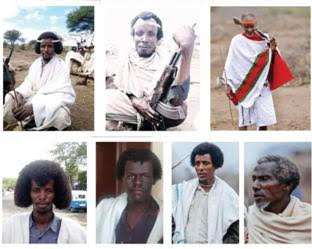
It is evident within Amhara Region as the mass graves from retaliatory killings in Wollo (p.14) attest, as do previously reported killings of Agaw (Report 57, p.23) and Kemant (Report 58, pp.17-18).
The process of killing and razing villages of non-Amhara is evident around Amhara Region too – mass killings in East and West Showa (pp.9-10), East Wallega and Horo Guduru zones, Oromia Region (pp.21-22), and in Metekel zone of Benishangul-Gumuz Region (pp.28-29).
These killings are preceded, justified and followed by hate speech aimed at the victims (pp.5-7). False claims of atrocities attributing them to OLA (p.22) are another form of hate speech – designed to increase hostility and hatred.
Civilians are also killed throughout Oromia in scorched earth campaigns in West Wallega (pp.19-21) and in East and West Guji zones (p.30). Government soldiers are told ‘to do whatever they want be it legal or illegal including murders’ (p.27).
On taking power, Abiy Ahmed’s top priority, however, was the elimination of the very group which enabled his ascendancy, the Qeerroo non-violent pro-democracy protestors. Former Minister Milkessa Gemechu confirmed that the observed trend was deliberate policy (pp.3-4).
The devastating local effects of the civil war in Oromia are revealed by the third report from the Human Rights Defenders Group, based in West Wallega (pp.24-28).
OLF political prisoners remain in filthy, secret dungeons (pp.10-13) after the release of a few OFC leaders on 7 January. Bate Urgessa, OLF Public Relations head, was released from prison on a stretcher and remains severely ill.
Opposition leaders together with civil society and grassroots organisations, must be the drivers of any dialogue to navigate Ethiopia out of its multiple crises and must be released.
Fur further details: https://advocacy4oromia.org/osg-report-59-beware-genocide/
A Diasporan Oromo Visits Kenya: A Reflection
Being from the Ethiopian side of the border, travelling and getting to know my people on the Kenyan side has brought me back down to earth regarding the way I have previously viewed the Borana Oromo.
By Soreti Kadir

I left Oromia just before turning two years old and I grew up among the first Oromo people to call Melbourne home. I vividly remember the days when we were so few that, in Clayton South, the suburb in which I spent 16 years of my life, there was an Oromo family on almost every block. Being such a small community, we didn’t scatter across the breadth of the city but huddled together in a small enclave for safety, support, and the comfort of familiarity. In those days, weddings, birthday parties, funerals, and other community events were attended by people from all the regions of Oromia who made up our little community.
But as our community grew in number, and as the number of people from every region of Oromia grew, I started to see a divide in how we congregated. By my mid-teens, I was almost completely disconnected from the spaces and networks that included Oromo people from outside the Arsi region, where I come from. Naturally, as I reached adulthood, I attended cultural and community events on my own initiative rather than at the invitation of my family.
I started to learn about my community all over again. And in the course of this experience, I was never directly and deliberately taught who the Oromo are, who I was as an Oromo, and how and why other Oromo people were different, or the same, to my family. Whereas this learning is experiential for one growing up in Oromia, there are gaps when this way of learning is transferred to the diaspora, or even to urban areas in Oromia, and so more recent generations are developing different tools and spaces for learning Oromo identity, culture, and history. What I did learn experientially though, were the nuances that make one a person from Wallaga, another from Haararge, Shewa, Arsi, etc.
Still, l had little knowledge regarding the Borana Oromo. As one who developed Oromomumma (Oromo identity) in the diaspora, and as someone who has spent over a year and a half living in the homes of Borana and Orma Oromo in Kenya, my relationship with this part of my community has developed in an intriguing and adventurous way, and it holds a special place in my heart.
I met Addee Jiloo, a Borana woman, in my early twenties. Each time I had attended Irreechaa (an Oromo thanksgiving festival), it was Addee Jiloo that led the procession to the water. If a woman needed her Gutino (Borana cultural dress) tied at an event, we would frantically search for Addee Jiloo. If we had public events, she would be the one conducting the coffee ceremonies. In many ways, she was collectively identified as a keeper of cultural knowledge, a leader of cultural practice, and an advisor on cultural affairs.
Over the years, I remember repeatedly hearing that “Borannii Hangafaa Oromo”, that the Borana are the oldest of the Oromo. This refers to the position Borana and Bareentu, as the first sons of Oromo, hold as the moieties of the Oromo nation. I had also come to learn that the Borana were among the few Oromo to still practice the Gadaa system, one of the greatest cultural assets of the Oromo nation. To me, the Borana felt almost like a thing of legend, a mystery to be revered and respected. They seemed to know things about being an Oromo that others didn’t. They seemed to have succeeded in preserving practices that the rest of us were no longer connected to. They seemed to be Oromo with the kind of defiance, resilience, and resistance that I wanted to embody. Although, from what I could see, it seemed like the Borana did so without the existential effort I sometimes felt it took to embody Oromummaa.
Language
I stayed with a Borana family for a few months when I first moved to Nairobi, but for the first few weeks of my stay, I had almost no idea what anybody was saying. I was used to most Afaan Oromoo dialects and Addee Jiloo’s dialect never sounded very different from anybody else’s, so my Kenyan experience sent me into a state of severe culture shock. With time, however, I became used to the difference in dialect and was able to improve my communication and now you can probably detect the influence of the Borana dialect in my spoken Afaan Oromoo.
In many ways, she was collectively identified as a keeper of cultural knowledge, a leader of cultural practice, and an advisor on cultural affairs.
Almost simultaneously with this sense of shock came a sense of overwhelming awe and admiration. Afaan Oromoo is a language that you feel. It is poetry in motion. Intimate, alive, revealing. I found this exemplified in the Borana dialect.
When I first heard my host answer the phone and greet the person on the other line with, “Qileensii urgooftuu?” Is the air fragrant? I almost wept. Welcoming a guest, the Orma of Tana River along the northern Kenyan coast, say “Diyaadhaa”, come closer, be close. This is a common saying among the Borana and Orma people, and I experienced it frequently during my stay in Tana River. If language is supposed to connect us, I think that the breadth of the Oromo language does so profoundly, and the dialect spoken amongst the Borana and Orma achieves this objective to grand effect.
Traveling up north
When I travelled to northern Kenya, I was bubbling with expectation. I remember sitting at a small shop trying to recover from the long journey, and striking up a conversation in Afaan Oromoo with the shop owner. He responded in a mix of Swahili and Afaan Oromoo. We continued talking and I told him that I was an Oromo from the other side of the border. This meant, well, not much at all to him.
I had expected a dramatic reunion. What I got was a shopkeeper who was not surprised or touched in any way by my presence. The cultural and linguistic relationship that we shared, despite the borders, was not profound for him. The reason that this surprised me was that, when I visited Tana River, there was a palpable sense of connection with everyone I met, for the very reason that we had a shared identity across borders.
Given that I was closer to the border of Oromia and I was in a place that was, in many ways, more engaged with the Oromo cultural and political identity, I think I expected this sense of connection to be amplified. What I experienced after leaving this shop showed me that it was actually because of the consequence of this proximity to Oromia’s border and the political landscape of the area at large, that meant that Oromos connecting and sharing experiences across borders was no special occurrence.
I sat for lunch in the compound of an ordinary looking house. As we ate, a friend, someone who had grown up in the town we were in, began to tell me stories about where we were. In 2002, the house we were in was the target of a bombing by Ethiopian government forces. Luckily, nobody was home. Chief Ibrahim Abdi Dido and his family lived in the house at the time. In the same year, Chief Buke Liban, Chief Taro Sora, Chief Denge Okotu, Chief Huqa Guled, Boru Jiloo, Sheikh Hassan (Moyale), Qasim Abdi and many others were similarly targeted by Ethiopian government forces and in most cases, these community leaders, and oftentimes, their families, did not survive. Although I knew a little about how the Ethiopian government targeted Oromo people across the border in Kenya, including the kidnapping and assassination of political refugees in urban centres, the arrest and extrajudicial killing of young people, and the displacement of communities, in the months that followed, I learned that the extent and severity of this persecution was far greater than I had first understood.
When I first heard my host answer the phone and greet the person on the other line with, “Qileensii urgooftuu?” Is the air fragrant? I almost wept.
Through listening to the stories of the many people I met on my travels, I also learned that local cultural leaders played and continue to play a role in this persecution by collaborating with the Ethiopian security forces. This was sobering to understand because it resembled the dynamic that’s been at play across Oromia since the onset of Abyssinian colonisation, whereby Oromo people, including local leaders, have opted to participate in the violence perpetrated against their own people.
My experience in northern Kenya brought me back down to earth regarding the way I viewed the Borana Oromo. I was in a place where the people were living with the challenges and consequences of choosing to live their Oromoness every day. Just as it would be incredibly weird for me to go to Wallaga or somewhere in Eastern Haragee or Balee and start wandering around asking people if they thought it was wonderful that we share a language, culture, and political reality (which I have never done), it was weird for me to do so in northern Kenya too.
The Oromo of Ethiopia and the Oromo of Kenya are, in many ways, fighting the same fight. Both make huge sacrifices for the political struggle, and suffer the consequences of this, along with enduring the consequences of simply being an Oromo in relation to the Ethiopian state, political activity or not. The indifference of the shopkeeper I met at the beginning of my travels makes sense. He experienced the same, if not more, breadth and depth of Oromummaa as I did; there was nothing novel I offered him in being an Oromo from the other side of the border.
The Borana-Gabra conflict
When I arrived in northern Kenya, I remember getting off the bus from Nairobi and wondering why on earth it had dropped me so far away from the town I was going to, only to learn that it was an Orma-owned bus company, and they were careful about infringing on the territory of the Borana. The same person who told me the story about the house in which we ate lunch has lost family to protracted conflict between the Borana and Gabra people. When I asked him what the root cause of the conflict was, he said, “It just started a long time ago. We speak the same language, we are the same people, but a feud that started between a few, a long time ago, has continued on.” I didn’t know if the origins of the conflict were as vague as my friend described them to be, or if his description is just how the existence of the conflict feels to someone who has suffered because of it, but I did come to learn that access to resources like water and land between nomadic pastoralists (Borana) and settled subsistence farmers (Gabra) and ongoing political power struggles play a huge role in the enduring and deadly conflict.
Lamu
Many years ago I spent some time in Lamu and I met two Orma people on the Island. At the time I thought that it was just a bizarre coincidence that they were there but I now know that the Orma have been living in the northern coastal region of Kenya since the late 1800s.
Being from the Ethiopian side of the border, a landlocked country, it is very interesting for me to think that I share a language, history and, even if only in small ways, a culture with a people that have lived along the coast for over a century. The Oromo worldview places great emphasis on our relationship with and duty towards land. As one develops the essence of Oromummaa, I believe that a person intuitively connects with this worldview. From this perspective, learning that we are connected to a people whose relationship to land is connected to the ocean — there is just something about that that stirs something in me.
I was in a place where the people were living with the challenges and consequences of choosing to live their Oromoness every day.
Who we are as a people is infinitely complex. I am talking about the Oromo, of course, but I think I’m also talking about us all. If I have learned anything over the past year and seven months, it is that I will only ever keep living and reliving this one truth: people, their stories, and their lived realities are not linear, rigid, or made to be easily and simply comprehended. Life exists on a continuum of relationships and storytelling. I want to remain willing to relate to who people are, as they are, rather than clinging onto what I have constructed of a people through imagination, hearsay, and the effects of groupthink. I want my analysis of the world to shift and change as I learn and grow, and I want my posture of service to people to also shift and change as I learn anew. Getting to know my people on the other side of the border has taught me that state violence is pervasive, unconfined by borders, and resistances adapt accordingly. I also learned that I can do little to effect real and lasting change if I do not cultivate my ability to meet the complexity in individuals and in communities with a willingness to learn and an openness of heart and mind.
Read more at: https://www.theelephant.info/op-eds/2022/04/22/a-diasporan-oromo-visits-kenya-a-reflection/?fbclid=IwAR1b_0cRJRYE3niprfAoV_nuwBv7BYauY6bEAwVeIdezs0IaK_Cc8rpu7rw#.YmM2ZklBDSg.facebook
The Elephant – Speaking truth to power.
New Book: Dressing Modern Like Our Mothers: Dress, Identity, and Cultural Praxis in Oromia
(17 February 2022, A4O) Author Peri Klemm has published new book titled ‘Dressing Modern Like Our Mothers: Dress, Identity, and Cultural Praxis in Oromia’.

Oromo women live as traders, wood carriers, shepherds, and farmers in and around the ancient trade center of Harar, Ethiopia. They have lived with the uncertainties of drought, famine, war, and political unrest for several generations and experienced poverty, disease, and severe restrictions in personal freedom.
These same women, both young and old, adorn themselves with an array of body modifications and supplements.
What is it about the objects and practices themselves that appear to hold such significance? This rich ethnography illustrates why Oromo women decorate their bodies in particular ways and why they invest so much timeand effort in doing so.
By tracing the development of dress within the Oromo social system from the mid-nineteenth century to today, and through a close examination of dress activated on the body in particular contexts like lifecycle rituals, spirit possession practice, and nationalist movements, the reader will uncover how truly valuable a woman’s decorated body is as an aesthetic and symbolic system.
The cover features a painting of an Afran Qallo Oromo woman by the talented Yadesa Bojia.
You can order the book online from the following links.
Africa world press books: https://africaworldpressbooks.com/dressing-modern-like-our-mothers-dress-identity-and-cultural-praxis-in-oromia-by-peri-m-klemm-hb/
Amazon: https://www.amazon.com/Dressing-Modern-Like-Our-Mothers/dp/1569027803
Tarkaanfii Lagannaa Nyaataa Hooganootaafi Qondaalota ABO Geessees Fi Haala Keessa Jiran

(A4O, Gabaasa Addaa, Finfinnee, 14/02/2022) Tarkaanfii lagannaa nyaataa Hooganooti fi Qondaaloti ABO hidhaa keessa jiran gaggeessanii fi haala isaan keessa jiran irratti gabaasa addaa qindeeffame.
Hoogganootni fi qondaalotni ABO kanneen akka :
Jaal Mikaa’el Booran,
Jaal Kennesaa Ayyaanaa,
Jaal Lammii Beenyaa,
Jaal Dawwit Abdataa,
Jaal Battee Urgessaa fi
Jaal Gadaa Gabbisaa kan jedhaman miseensota fi hoggantoota ABO biroo waliin yeroo turtii waggaa lamaaf hidhaa Keessa turuun ni yaadatama.
Waggaa lamaan kana kessatti garii isaanii manni murtii bilisa isaan gadhiisee, garii isaanii abbaa Alangaa <<himata irraa hin qabu, >> jedhee, kaan ammoo himatni homaatuu osoo itti hin dhihaatiin haala ulfaataa ilmaan namaaf hin malle keesaatti bakka tokkorraa bakka biraatti adaraa kennamaa dabarsan.
Manni murtii adeemsa seeraan bilisa isaan godhus Koomishiniin Poolisii Oromiyaa itti cichee isaan gadhiisuu dide.
Dhimma isaanii yeroo gaafataniis, Poolisiis ta’e qoratan, << Dhimmi keessan nu bira miti, furmaata isiniif kennuu hin dandeenyuu! >> deebii jedhu argataa turan.
Baatii jahan darbe ammoo bakka maatii, abukaatoo fi ummatni isaan hin arginetti geessanii dhoksaatti hidhan. Gaaffii mirgaa isaan deddeebisanii kaasaa turaniif afaaniin sobuu malee falli hin argamne.
Kanaaf isaaniis dhumarratti hidhaa seeraan alaa, roorroo fi daba kana jalatti roorrifamaa jiraachuurra du’a nuuf wayya jedhanii takkaahuu hiikamuu ykn kabajaan falmataa du’uuf murteessanii waliif kakachuun gaafa Guraandhala 1, 2022 lagannaa nyaataa eegalan.
Yeroo kanatti qondaalotni Koomishiniin Poolisii Oromiyaa itti deddeebi’an, << Dhimmi keessan guyyaa muraasa keessatti furamaa nyaata nyaadhaa!>> jedhanii kadhatan. Isaanis, << takkaahuu ammuma nu furaa, ykn nutu of fura!>> jechuun ejjennoo isaaniitti cichan.
Kana gidduutti gaafa 05/02/2022 Jaal Kennesaa Ayyaanaa waan laaffataniif hospitaala geeffamanii yaalii xiqqoo booda deebifamanii lagannaa eegalanii guyyaa saddeet booda lubbuu isaaniif waan sodaataniif bakka dhoksaatii isaan baasuun Q/P/B/Magaalaa Buraayyuutti isaan darbatan.
Achitti lagannaa waan itti fufaniif gaafa guyyaa kurnaffaa manguddoonni Waldaa Maccaa fi Tuulamaa, Abbootiin Gadaa fi Haadholii Siiqqee marga qabatanii jilbeenfatanii itti booyan.
Obbo Dirribii Damisee fi Pirooeser Asaffaa Tafarraa isaan keessatti argamu. Isaanis haala suukanneessaa keessatti dararaman ibsaniifi , << hidhaan seeraan alaa fi roorroo hamtuu kana keessa hiikamuu ykn murtii keenyan of furuu qabna!>> ejjennoo jedhu ibsaniif.
Yeroo kanatti manguddoonni jilbeenfatanii, << Nuti gama keenyaan dirqama ofitti fudhannee dhiibbaa kamuu ni goona, isin hanga tole nuuf jettanitti hin deemnu!>> jechuun imimmaan buusanii isaan kadhatan. Hoogganooti fi qondaaltonni ABOs kabaja manguddootaaf jecha mana yaalaa deemuuf waliigalan.
Haala Kanan gaafa guyyaa kurnaffaa galgala hospitaala seenanii gaafa guyyaa kudha tokkoffaa hospitaala Poolisii fi Beetezaataatti yaalaman.
Qormaata hospitaalatti taasifamaniin Jaal Battee Urgessaa dhibee tiruuf saaxilamuun hubatame. Hundi isaaniituu miidhaa qaamaaf waan saaxilamaniif hanga qaamni isaanii deebisee of danda’utti guyyaa Shanan itti aanan nyaata sasalphaa ogeessi fayyaa tartiibaan akka fayyadaman gorse fudhatu. Amma nyaata sasalphaa eegalaniiru.
Ethiopia Government forces kill 14 civilians in Oromia

Ethiopian Human Rights Commission, the independent organization funded by the Government of Ethiopia, today exposed the assassination of 14 civilians in Oromia Region by the Oromia Special Force at the end of last November.
The traditional leader of Kereyu – Abba Geda Kedir Hassen, is among the 14 civilians killed (described as ‘extra judicial killing’ in the report) by the Oromia special force, according to the report of the Commission released today. The report stated that the revenge killing by the Oromia special forces has occurred around Fentale – Metehara area in Oromia region of Ethiopia a day after 11 Oromia special force members are killed by unknown armed group.
The 8 pages report of the Commission has interviewed 46 witnesses. The report released in Amharic language stated that before killing the civilians the Oromia Special force members has taken the 30 civilians and made 14 of them to lie on the ground and assassinated them.
It is stated that before taking them to the bush for assassination, the members of the special forces of Oromia have asked the dead to tell them who killed their 11 colleges (members of Oromia Special forces) the previous day.
After the brutal revenge killings of the 14 civilians who are members of the Kereyu Michle Geda Jilla tribe, the relatives of the dead are forbidden by the killers (members of Oromia Special forces) from taking and burying their family members, according to the report. So far neither Oromia Police nor the attorney general of the region or that of Ethiopia has responded for the investigation of the Commission.
It is recalled that about a week ago, at the outskirt of Addis Ababa around Burayu area 3 civilians (followers of the Ethiopian Orthodox Church) are killed by the Oromia special force members during the celebration of Ethiopia’s Timkat (Epiphany). The three civilians are allegedly killed for weaving Ethiopia’s old smooth green, yellow and red colored flag.
Following the killing Ethiopia Government Communication Service head Legesse Tulu has indicated that the issue is being investigated. Meanwhile so far neither the Oromia Region nor the federal Government of Ethiopia has issued public statement about who from the Oromia special force have assassinated the three individuals and what action has been taken against them.
The Commission in its report urged the Government of Ethiopia to compensate the relatives of the people who lost their lives and those who are sustaining severe injuries due to the attack by the Oromia special forces.
Before the investigation of the Commission, the Government media at the time reported that the 14 civilians are killed by the armed group designated as a terrorist group in Ethiopia – Oromia Liberation Front (OLF-Shene).
በከረዩ የሚችሌ ገዳ የጅላ አባላት ግድያ ላይ የተደረገ የምርመራ ሪፖርት
የኢትዮጵያ ሰብአዊ መብቶች ኮሚሽን (ኢሰመኮ) በኦሮሚያ ክልል ምሥራቅ ሸዋ ዞን ፈንታሌ ወረዳ በኅዳር 22 ቀን 2014 ዓ.ም. የከረዩ የሚችሌ ገዳ አባላት አርዳ ጅላ ላይ በተፈጸመ ጥቃት የሕይወትና የአካል ጉዳት ስለመፈጸሙ በደረሰው ጥቆማ መሰረት፣ ከታኅሣሥ 7 እስከ ታኅሣሥ 12 ቀን 2014 ዓ.ም. በቦታው በመገኘት ምርመራ አካሂዷል።
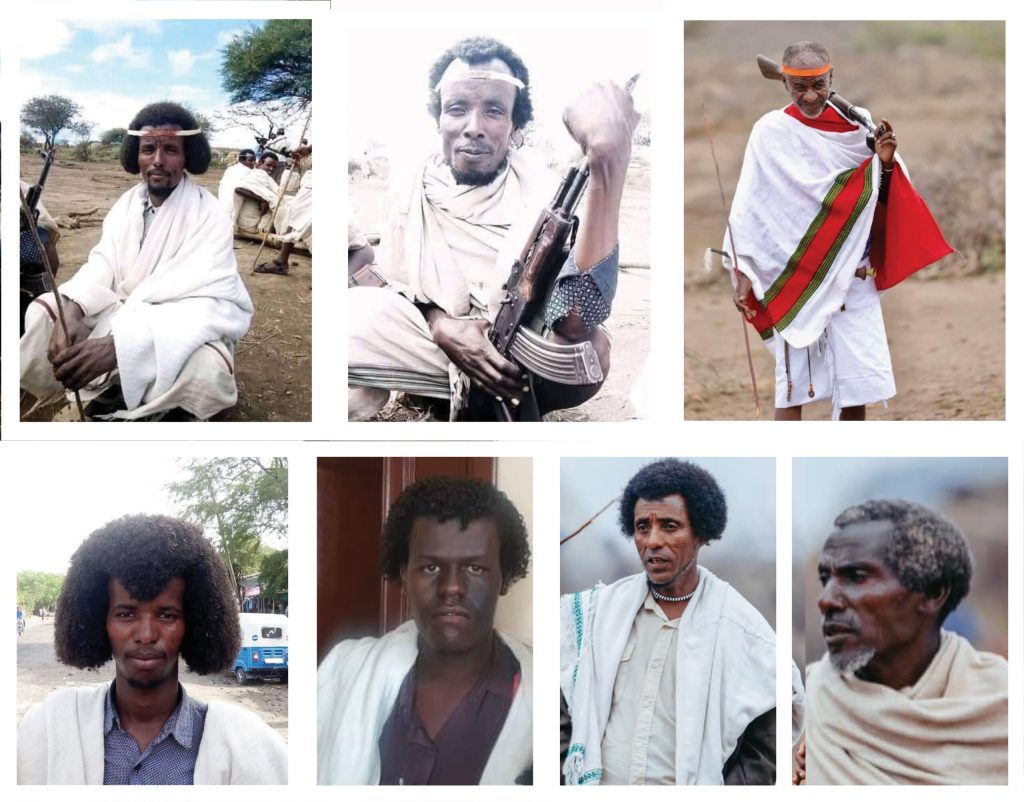
Dhaabbileen Oromoo Jaatamaa ol Ta’an Marii Biyyalessaa Irratti Yaaddoo Qaban Ibsan

Finfinnee, Amajjii 21/2022-Dhaabbileen hawaasaa Oromoo jaatamaa ol ta’an hundeeffamuu Komishiini Marii Biyyalessaa Itoophiyaa ilaalchisuun ibsa kennan. Yeroo jalqabaaf dhaabbilee Sivikii, Falmattoota Mirga Dhala Namaa fi Waldaalee Hawaaasaa Oromoo idil-addunyaa walitti dhufanii marii biyyaalessaa adeemsifamuuf jiru irratti yaaddoo qaban ibsan.
Sadaasa darbe manni maree bakka bu’oota uummaataa labsii hundeeffama Komishiini Marii Biyyaalessaa raggaasisuun isaa ni yaadatama. Manni maree bakka bu’oota uummaataa labsiin kun beekumsa biyyaa keessaa fayyadamuun furmaata waaraa ni fida, akkasumas duudhaalee hawaasaa walitti ni hidha jedhe. Manni marichaa hoggansa Komishiini Marii biyyaalessaa uummataan akka kadhimamuu fi mana maree bakka bu’oota uummaataatiin akka ragga’u eere.
Dhaabbileen kunneen adeemsa fi tarkaanfileen marii biyyaalessaa keessatti fudhatamanii amanamuummaa uumuun marii dhugaatiif haala ni mijeessuu danda’an lafa kaa’an. Ibsi kun marii biyyaalessaan dura tarkaanfilee fudhatamuu qaban tarreessa. Isaanis Lammilee waraanan miidhaman hundaaf haal duree tokko malee deeggarsa namooma adda hin cinne taasisuu, hidhamtoota siyaasaa hunda haalduree tokko malee hiikuu fi Humnootni alaa hunduu, keessumaa humni nageenyaa, loltootni fi basaastotni Ertiraa, Itoophiyaa keessaa akka ba’an dabalata. Dhaabbileen Oromoo kunneen mootummaa Itoophiyaa fi qooda fudhattoota hundaaf tarkaanfii waraana dhaabsisuu fi marii walabaa, hunda haammate fi hunda hirmaachise akka taasifamuuf qooda isaanii akka ba’atan waamicha dhiyeessan.
“Marii biyyaalessaa keessatti adeemsii fi tarkaanfileen fudhataman amanamuummaa uumuun marii dhugaatiif haala mijeessa. Kunis Oromiyaa keessattii fi naannoollee hundatti alatti dirree siyaasaa jiru bal’isuun miidiyaaleen walabaa akka jiraatan, mariiwwaan bu’uraa fi lammilee hundaa hirmaachisu taasisutu barbaachisa. Haaluma kanaan marii bal’aani fi hirmaachisaan qamoolee dhimmi ilaallatu waliin,yeroo, turtii, raawwii, iddoo, qabiyyee, saffisa, adeemsa, fi hojiirra oolmaa marichaa irratti akka taasifamu irra deebi’uun waamicha dhiyeessina.” jedha ibsichi.
Ibsa Guutuu
Ibsa hundeeffama Komishinii Marii Biyyalessaa (KMB) Itoophiyaa ilaalchisuun Dhaabbilee Sivikii, Falmattoota Mirga Dhala Namaa fi Waldaalee Hawaaasaa Oromoo idil-addunyaa irraa kenname.
Nuti dhabbileen asii gaditti maqaan keenya dhahame, qophii mootummaan Itoophiyaa dhimmoota bu’uraa biyyaalessaa irratti waliigaltee umuuf, marii biyyaalessaa jalqabuuf taasisu itti dhiyeenyan hordofaa jirra.
Mootummaan labsii hundeeffama KMB ulaagaa ifa hin taaneen kophaa isaa raggaasiseera. Yeroo ammaa kana, hojimaata ifa hin taanee fi abbootii dhimmaa ijoofi deeggartoota waliin marii ga’aan utuu hin taasifamiin namoonni Komishiini Marii Biyyaalessaa gaggeessan filatamaa jira.
Hidhamtootni siyaasaa muraasni hiikamuu isaanii agarree jirra; garuu hidhamtootni kuma hedduu ta’an ammayyuu mana hidhaa jiru. Tarkaanfiin dura kun mootummaan biyya bulchaa jiru hidhamtoota siyaasaa hafanillee hiikuuf akka yaade fi qalbii guutuun maricha irratti hirmaachuuf fedhii qabaachu agarsiisa jennee abdanna.
Haa ta’u malee, mootummaan Itoophiyaa qaama walaba, Komishiinii loogii siyaasa irraa bilisa ta’e hundeessuu danda’u miti. Kuni ammoo marii biyyaalessaa hunda hammate godhuuf ulaagaa ijoofi barbaachisaadha .
Kanaafuu, ibsa Hagayya 18, 2021 basneen waraanii akka dhaabatuu fi mariin hunda hirmaachise akka taasifamu gaafatu irra deebi’uun, gaaga’amni siyaasaa walxaxaan biyyattiin keessa jirtu furamee nageenni waaraan akka dhufu gorsa armaan gadii dhiyeessuu barbanna.
1.Waraanni hatattamaan akka dhaabbatu taasisuun, humnoota federaalaa fi garee hidhattootaa naannoo Oromiyaa, Tigraay, Beenishaangul Gumuz, Amhaara fi Affaar keessa jiran giddutti walii galteen dhukaasa dhaabuu taasifamee, mariin siyaasaa hunda hirmaachise akka godhamuuf haala miijessuu.
2.Lammilee waraanan miidhaman hundaaf dhiyeessii nyaataa fi qorichaa dabalatee deeggarsa namooma adda hin cinne haal duree tokko malee akka taasifamu; kanneen amma sababa hongeetiin beelaaf saaxilaman deeggaruu fi tajaajiloota bu’uura akka baankii, telekoomi, geejjibaa fi tajaajila ibsaa, lammilee miliyoonan lakkaa’aman naannolee Oromiyaa, Tigraayi, Beenishaangul Gumuuz, Affaar, Amaaraa fi Somaalee keessatti argamaniif akka deebi’u.
3.Hoggantoota Adda Bilisummaa Oromoo (ABO) dabalatee, hidhamtootni siyaasaa hundi haalduree tokko malee akka hiikaman. Caamsaa 2021 irraa eegalee hidhaa mana keessaarra kan jiran hayyu dureen dhabichaafi, dargaggootni Oromoo kumatamootan mana hidhaa adda addaa keessa jiranii fi hidhamtootni biroo haalaa sabummaa irratti xiyyeffateen erga labsiin yeroo muddamaa bahe hidhaman hundi akka hiikaman.
4.Humnootni biyya alaa hunduu, keessumaa humni nageenyaa, loltootni fi basaastotni Ertiraa, Itoophiyaa keessaa akka ba’an taasisuun biyyootni naannoo gaanfa Afrikaa fi biyyootni Itoophiyaa wajjiin walitti dhufeenya qaban deeggarsa akka godhaanii fi haala dhiittaan mirgaa akkasumas wal waraansi waliinii itti dhaabbatu haala miijessuu.
5.Komishiinii marii biyyaalessaa walaba ta’e, qooda fudhattoota hundaa biratti fudhatamummaa qabu fi marii biyyaalessaa ifaa fi hunda haammataa ta’eef haalaa miijessu danda’u hundeessuu. KMB mootummaan deeggaramu itti gafatamummaa barbaachisaa fi seena qabeessa kana amanamummaan ba’uu danda’a jennee hin amannuu; komishiiniin qaama kamirrayyuu walaba ta’e akka hundeeffamuuf hawaasni idil-addunyaa deeggarsa barbaachisa akka taasisu waamicha dhiyeessina.
6. Marii biyyaalessaa keessatti adeemsii fi tarkaanfileen fudhataman amanamuummaa uumuun marii dhugaatiif haala mijeessa. Kunis Oromiyaa fi naannoollee hundatti dirree siyaasaa bal’isuun miidiyaaleen walabaa akka jiraatan, mariiwwaan bu’uraa fi lammilee hundaa hirmaachisu taasisutu barbaachisa. Haaluma kanaan marii bal’aani fi hirmaachisaan qamoolee dhimmi ilaallatu waliin,yeroo, turtii, raawwii, iddoo, qabiyyee, saffisa, adeemsa, fi hojiirra oolmaa marichaa irratti akka taasifamu irra deebi’uun waamicha dhiyeessina.
Nuti dhabbileen asii gaditti maqaan keenna eeramee, waldaaleen hawaaasaa, dhaabbileen Ogeeyyii, falmattoonni mirgoota namoomaa fi hawaasni waligalaa Oromoo, mootummaa Itoophiyaa fi qooda fudhattootni biyyattii hundaa akkasumas Hawaasa idil addunyaa, Dhabbatni Motummoota Gamtoomanii, Yunaayitid Isteets, Chaayinaa, Gamtaan Awurooppaa fi biyyootni miseensa gamtichaa, Gamtaan Afrikaa fi biyyootni miseensa gamtichaa, Gamtaan Emireetota Arabaa, Turkii fi Iraan, naannolee Itoophiyaa hunda keessatti walitti bu’iinsi akka dhaabbatuu fi adeemsi marii biyyalessaa haqa qabessaa fi hirmaachisaa ta’e akka itti fufuf tarkaanfii barbaachisu akka fudhattan gaafanna.
A Dagger to the Heart: Ethiopian Party Officials Order the Killing of 14 Indigenous Oromo Leaders
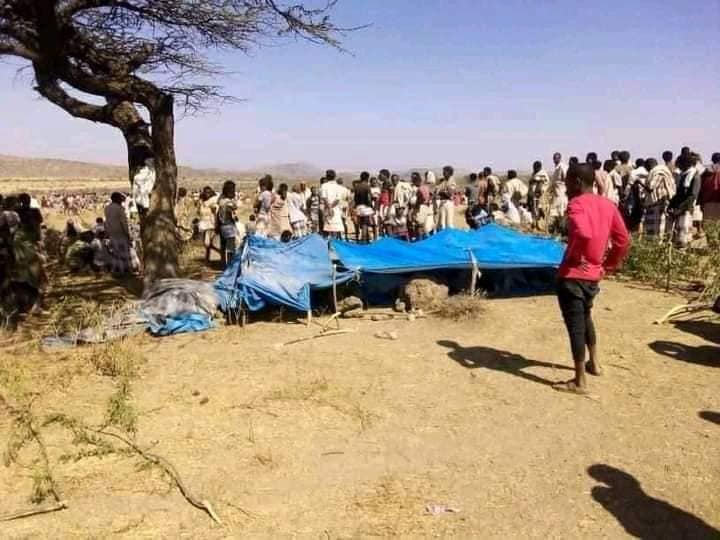
On the evening of December 1, 2021, 14 respected, experienced and culturally venerated leaders
in the Karrayyuu Oromo community of 100,000 in central Ethiopia were killed in minutes by
Oromia Special Police and Federal forces operating on orders by ruling party officials sitting a
hundred kilometers away in Adama city. The murdered men were located at Fantalle district,
East Shewa Zone of the Oromia regional state in Ethiopia. They were killed execution-style at
7:00 PM far from the village where they were abducted when Prosperity Party bosses gave the
go-ahead signal via cell phone message to awaiting members of the special forces. The murdered
men had just finished conducting Waaqa Kadhaa, a sacred indigenous prayer ceremony held on
special ground designated for that purpose. In the close-knit iconic livestock-rearing culture of
the Karrayyuu people, this was an unthinkable atrocity.
We, a coalition of Oromo advocacy and human rights groups operating internationally consider
that this horrifying series of events indicate the intentionality and destructiveness of Abiy
Ahmed’s government against Oromo and other Southern and marginalized peoples who do not
support his direction for the country. We urge the international community, in particular those
concerned with justice, peace, stability and human rights, to take note of what has happened in
Karrayyuu. Those who were deeply committed to spirituality and to democratic principles above
all, were brutally massacred with lightning speed: an act that sends a menacing warning to the
populace that no one is safe right now in Ethiopia.
Historic, Political and Economic Contexts
The shocking massacre was carried out amid ongoing brutal wars between Ethiopian Defence
Forces and the Tigray Defence Forces in the north of the country and with the Oromo Liberation
Army in the south. The site of the killing is the Karrayyuu camel-rearing, pastoral grazing and
watering lands located near coveted trade routes for lucrative commodities in a cash-strapped
economy. This valued territory has become a target of territorial expansionism by Amhara
militias emboldened by Abiy Ahmed’s government’s failure to protect vulnerable peoples like
the Karrayyuu. In the days leading to the event, the Karrayyuu Oromo’s community leaders had
resisted releasing young people to be conscripted to leave their homeland to fight as part of the
Ethiopian Defense Forces in the north. Among Oromo communities throughout Ethiopia, the
Karrayyuu are well-known and esteemed for their consistent practice of the principles of the
time-honored Gadaa system of socio-political organization that encompassed all Oromo prior to
incorporation into Ethiopia at the turn of the 20th century. These and other factors make the
tragedy of December 1 resonate throughout the population and account for an ongoing sense of
threat and foreboding among other vulnerable groups in the country.
FOR IMMEDIATE RELEASE: ‘A Consensus Oromo Statement on the NDC’
We, the initiators of the idea behind the joint statement by worldwide Oromo Civic, Professional, Advocacy, Human Rights, and Community organizations, would like to express our deepest gratitude for all the co-signers of the joint statement for taking your time, receiving and approving the joint statement. As it stands now the joint statement is co-signed by a total of 64 Oromo civic organizations of various backgrounds and portfolios.
For that purpose it is safe to refer to the joint statement as an ‘A Consensus Oromo Statement on the NDC’ calling for careful sequencing of actions leading to inclusive dialogue in Ethiopia. We are scheduled to release the statement to the public through the media in the late afternoon on Friday 21 January.
To that end, we would like to make the following important points:
1 – The Statement BELONGS to all the co-signers. No single individual or institution lays exclusive claim on its ownership. Each co-signer owns it and is free to make use of it to advance the Oromo civic organizations’ recommendation with regard to inclusive dialogue in Ethiopia.
2 – We encourage all the co-signers to release the statement using respective institutional communication channels of each institution/organization which is the co-signer.
3 – We encourage all the co-signers to consider and promote the statement as ‘Consensus Oromo Statement on the NDC’ for various purposes, including during lobbying, awareness creating campaigns, distribution to the media and the international community including members of Parliaments /House /Senate, among others, in your respective districts. Let the world know what 64 Oromo civic organizations are recommending as a way out of Ethiopia’s crisis.
4 – We encourage all the co-signers to communicate and distribute the statement to their grassroots members and encourage them to use it during campaigns and lobbying works as well as social media engagements to create global awareness on what more than 60 Oromo civic organizations are recommending to be done before the commencement of inclusive dialogue in Ethiopia.
Once again, we thank each and every Oromo institution/organization for co-signing on this important statement. Together, we can be heard loud and clear.
Regards,
21 January 2022
For full statement click below link:
Oromo Peace Ambassadors Graduate
(A4O, Melbourne, 2019) Advocacy for Oromia held a series of 10 Peace Education Project workshops from July to August 2019 at Ross House.
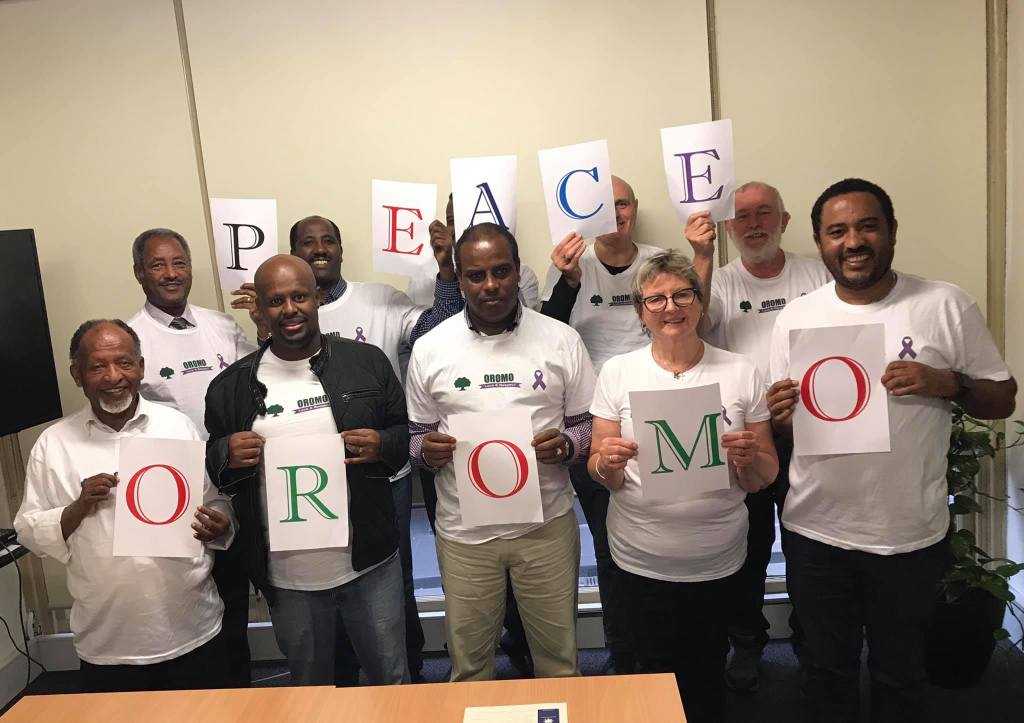
The course, which was hosted by the Perm Rawat Foundation, held in
collaboration with Advocacy for Oromia, is called the Oromo Peace
Education Project. “The workshops help us not only to recognise, but also
to build our inner strength and hope,” said Dabessa Gemelal, the Peace
Education coordinator at Advocacy for Oromia.
The Peace Education Program is a series of 10 sessions that guide an
individual toward discovering inner resources integral in developing healthy
life skills. Each session focuses on one of ten topics: Peace, Appreciation,
Inner Strength, Self-Awareness, Clarity, Understanding, Dignity, Choice,
Hope, and Contentment.
A graduation ceremony for our first Oromo Peace Ambassadors was held at
Ross House on August 3, 2019; 8 Oromo Peace Ambassadors graduated.
“The impact of this program is very positive, it has helped us to cultivate
inner strength,” Dabessa said. “I myself have grown from it, and I have
seen the positive effect it has had on the participants.” The Oromo Peace
Ambassadors were handed their graduation certificates by Gerry O’Connor
and Beatrice & Jeremy Collier from the Peace Education Team, Melbourne,
who facilitated the workshops.
The Oromo Peace Education Program helped participants feel empowered
to face past events, gain a willingness to change, better manage their day
to day life and spread a culture of peace and love.
By attending the peace education, the participants gained a deeper
understanding of different cultures and an enhanced capability in analysing
and solving conflicts by peaceful means. They also learned the importance
of mutual respect and co-operation and were taught about human rights,
causes of conflict and peaceful solutions.
Advocacy for Oromia work with Australian-Oromos to change lives for the
better and we couldn’t run these significant events without the support of
Ross House. We are proud of our achievements so far, however there is so
much more exploring and discovering left for us to do in the future.
Our thanks to the many, many people who have contributed to this peace
education project along the way. We appreciate the constant support of
Ross House and we proudly call the space, the Oromo House, where we
feel at home – for this we wish to thank Ross House and its staff for always
being so helpful and friendly.
Freedom Rally stages in Melbourne
(Advocacy4Oromia, Melbourne, 9 December 2021) Australian Oromo and Tigray communities stage Multicultural Freedom Rally in Melbourne today.
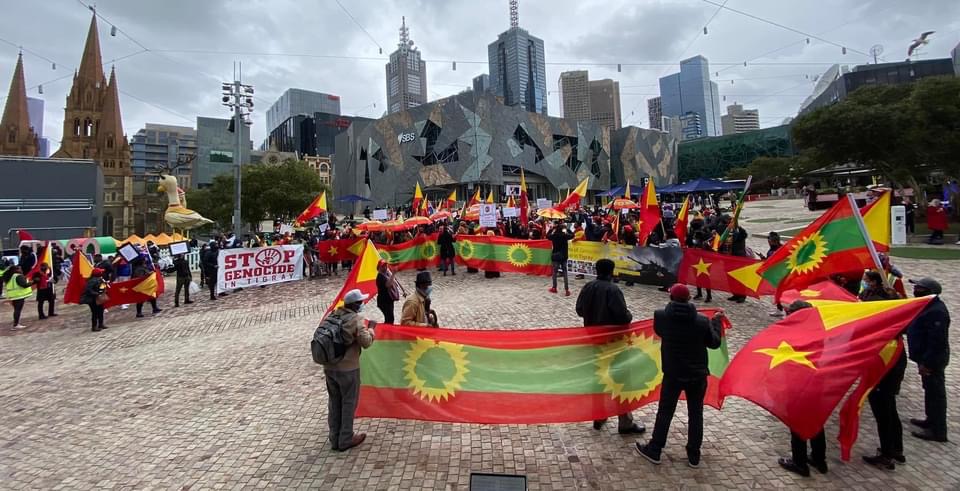
According to the organisers the rally is a part of world-wide action to condemn a recent series of atrocities, mass arrests, and airstrikes against civilians.
Melbourne’s Oromo, Tigray and other communities marched from Victorian Parliament to Federation Square, where community leaders spoke of unity in the face of oppression.

The participant states that the aim of the rally is to express their grave concerns and to demand the international community to pay attention to the development in Ethiopia.
“We’re not afraid to stand together, to be able to stand against violence and repression. Today, we join the Multicultural Freedom Rally in Melbourne to help raise our voices against a shared experience of brutal repression by Abiy regime.”

Demonstrators denounced the killings and violent repressions being meted out by the Abiy regime.
“We’re here today in the spirit of freedom rally to denounce any forms of violence. Violence is the last refuge of the incompetent. Abiy regime must respect the Oromo and Tegaru dignity, peace and freedom.”
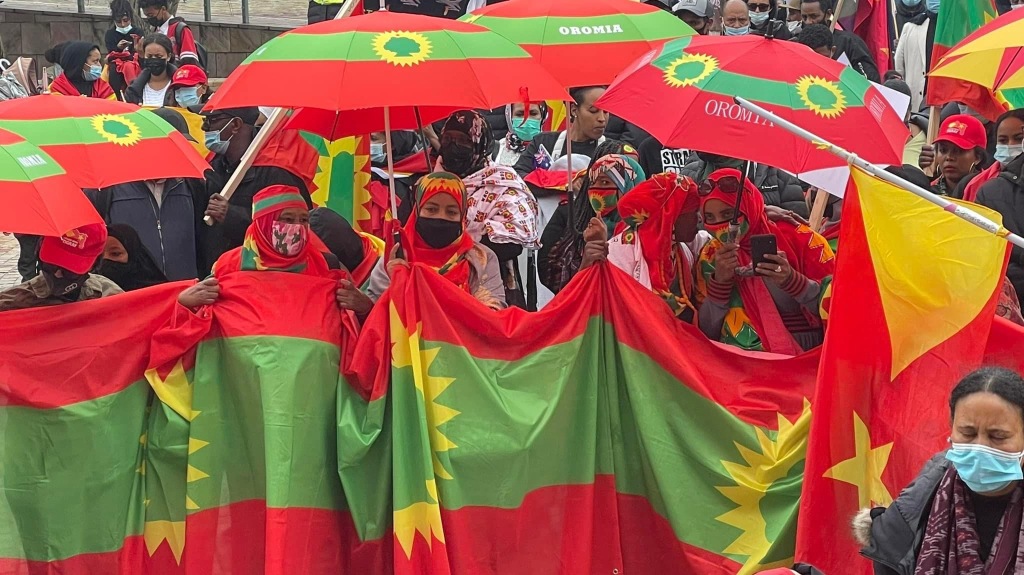
Rights groups say Abiy regime has opened wide ranging military campaign in many parts of Oromia; continuously carrying out hostilities and mass arrests on these civilians. Journalist, book author, translator and bookstore owner, Hinsene Mekuria, has been arrested by gov’t security forces from his workplace in Finfinne on 4th Dec 2021 around 1:30 local time. He often writes on social media and speaks for the cause of the Oromo people. His whereabouts is unknown.

Reports by the Ethiopian Human Rights Commission (EHRC) and Amnesty International describe widespread arrests of ethnic Tigrayans, including Orthodox priests, older people, and mothers with children.

In many parts of the country individuals are being arrested and detained without charges or a court hearing and are reportedly being held in inhumane conditions.
Demonstrators also appealed to the Government of Australia and the wider international community to put diplomatic, political, economic pressure on the Ethiopian regime.
“We URGE the good people of our international community to avoid the ultimate tragedy of silence over cruelty of the worst genocide in Ethiopia. We specifically urge the Australia and the wider international community, to take action and help stop the heinous crimes of the regime before Ethiopia potentially becomes a historic African tragedy.”
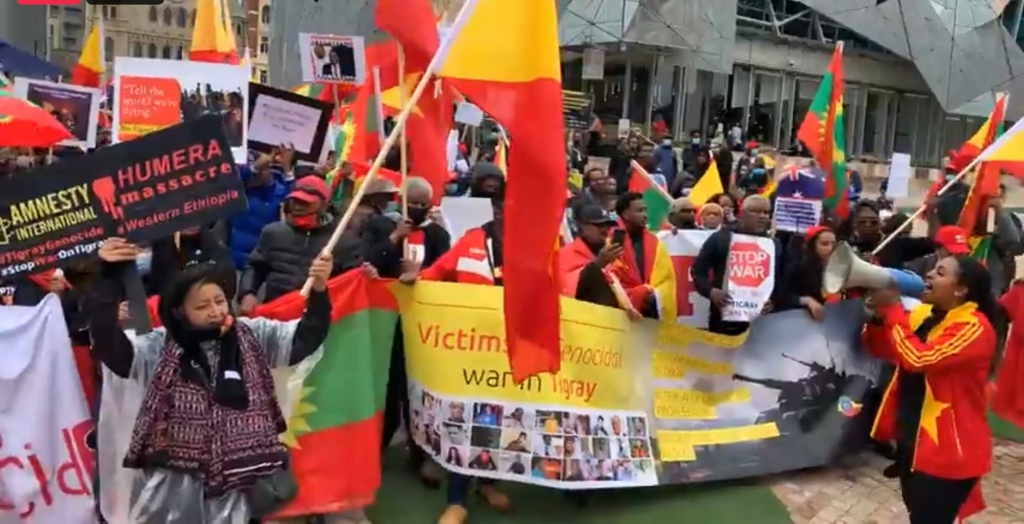
The message of Australian Oromo and Tigray communities is just calling for peace and freedom. “We’re not afraid to stand together, to be able to stand against violence and repression. We join this Freedom Rally to help raise our voices against a shared experience of brutal repression by the State.”
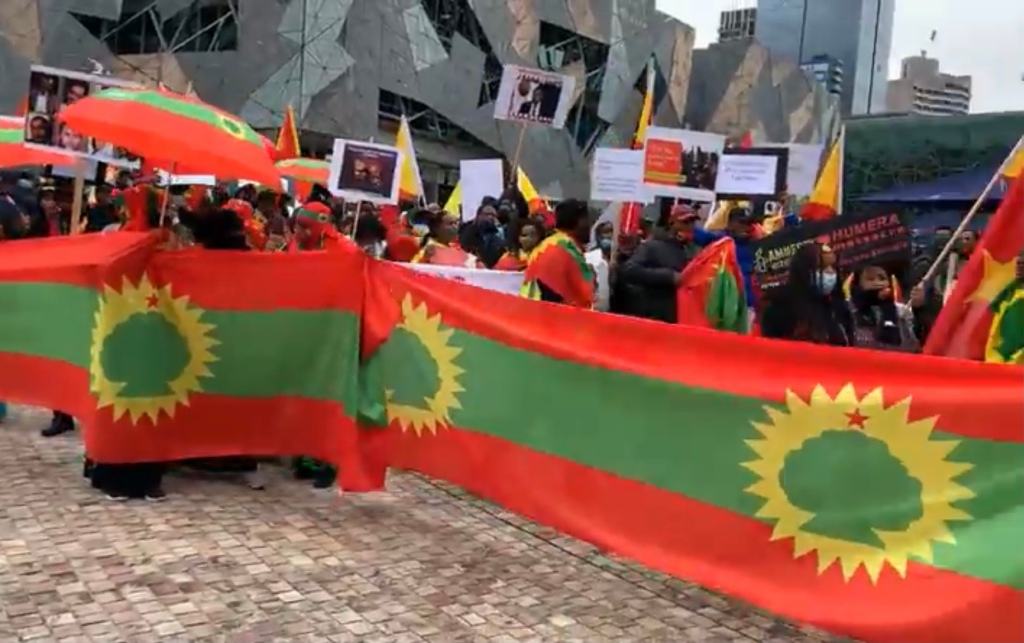
NEWS: AUSTRALIA, CANADA, DENMARK, THE NETHERLANDS, UK, & US CALL FOR “LARGE NUMBERS” DETENTION OF TIGRAYANS IN ETHIOPIA TO “CEASE IMMEDIATELY”
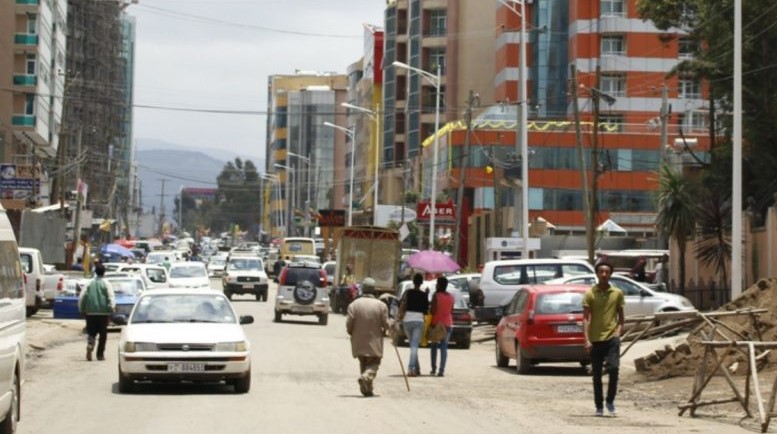
Addis Abeba, December 06/2021 – A joint statement signed by the governments of Australia, Canada, Denmark, the Netherlands, the United Kingdom, and the United States and released this afternoon expressed profound concern about the “detention of certain ethnic groups” in Ethiopia and called on the government for the detentions to “cease immediately.”
Full Statement
We, Australia, Canada, Denmark, the Netherlands, the United Kingdom, and the United States, are profoundly concerned by recent reports of the Ethiopian government’s detention of large numbers of Ethiopian citizens on the basis of their ethnicity and without charge. The Ethiopian government’s announcement of a State of Emergency on November 2 is no justification for the mass detention of individuals from certain ethnic groups.
MANY OF THESE ACTS LIKELY CONSTITUTE VIOLATIONS OF INTERNATIONAL LAW AND MUST CEASE IMMEDIATELY. WE URGE UNHINDERED AND TIMELY ACCESS BY INTERNATIONAL MONITORS
JOINT STATEMENT
Reports by the Ethiopian Human Rights Commission (EHRC) and Amnesty International describe widespread arrests of ethnic Tigrayans, including Orthodox priests, older people, and mothers with children. Individuals are being arrested and detained without charges or a court hearing and are reportedly being held in inhumane conditions. Many of these acts likely constitute violations of international law and must cease immediately. We urge unhindered and timely access by international monitors.
We reiterate our grave concern at the human rights abuses and violations, such as those involving conflict related sexual violence, identified in the joint investigation report by the Office of the United Nations High Commissioner for Human Rights and the EHRC, and at ongoing reports of atrocities being committed by all parties to the conflicts. All parties must comply with their obligations under international humanitarian law, including those regarding the protection of civilians and humanitarian and medical personnel.
It is clear that there is no military solution to this conflict, and we denounce any and all violence against civilians, past, present and future. All armed actors should cease fighting and the Eritrean Defense Forces should withdraw from Ethiopia. We reiterate our call for all parties to seize the opportunity to negotiate a sustainable ceasefire without preconditions. Fundamentally, Ethiopians must build an inclusive political process and national consensus through political and legal means, and all those responsible for violations and abuses of human rights must be held accountable.
Oromo guerrilla: Abiy is like a dying horse

Published yesterday at 06.22
Swedish Radio has, as one of the few media, met one of the main actors in the Ethiopian civil war – Oromo Liberation Army, OLA.
The OLA, together with Tigranian armed forces, will soon surround the capital Addis Ababa, which could lead to Prime Minister Abiy Ahmed being forced out of power and the entire political landscape being redrawn.
Addis Ababa is increasingly isolated and Abiy Ahmed has now decided to head to the front line. OLA’s commander describes Abiy as a dying horse kicking for the last time.
We are a bit across the Kenyan border into southern Ethiopia. It is hot, dry and mountainous. In the background, a dromedary roars. Here I meet a force of young soldiers from the armed group Oromo Liberation Army, some years ago a relatively unknown guerrilla, now one of the main actors in the Ethiopian drama.
Maybe they are a hundred . Most were former university students, some from high school, who joined here to fight the federal government and Prime Minister Abiy Ahmed and for what they see as an oppression of Oromos, Ethiopia’s largest population. Sure, it’s a bit of a show here, far from the front line, but just a few weeks ago, most people here were involved in battles further north, here they now get a much-needed but short rest.
One of them is Galmo, 22 years old. She joined the armed struggle as a teenager.
- I’m not afraid of fighting, she explains. I’m determined to free the Oromo people, I’m not afraid.
- I fight against the oppression that Oromos lived under. That is what drives me, to live a free life where the rights of Oromos are taken advantage of.
The Oromo warriors show their strength with a march and a short maneuver through the bushes. They wear simple uniforms, wear their equipment in shawls around their upper bodies, and wear only sandals in the barren landscape. The weapons are automatic rifles and machine guns and not much more. Yet here, and thousands of others in the Oromo Liberation Army, the Federal Ethiopian Army has fallen to its knees.
They have now surrounded Addis Ababa from three directions, from the west, south and southeast. In the northeast, they are acting together with the Tigranian armed forces, which may soon cut off the capital from the strategic road leading to the port city of neighboring Djibouti.
Jaal Gammachii’s Aboye is the second highest commander of the Oromo Liberation Army. For 20 years he has been in the armed forces and now it may be nearing an end. He says that Addis Ababa or Finfinne as the city is called in Oromo, will fall soon.
“No matter how much the federal Ethiopian army tries to resist, we are constantly approaching the capital together with the Tigranian forces,” he says. The main challenges have been the difficulties for communication, because the murderous regime in Addis, as he puts it, does not want the abuses to be known in the outside world, they have shut down the internet and mobile network, despite that we are steadily moving forward, he says.
The Ethiopian government has been widely criticized for almost completely isolating the Tigray region, preventing emergency aid from entering and allowing looting and mass rape. Hundreds of thousands are threatened with starvation there now. But all parties to this conflict are accused of abusing the civilian population, both the Ethiopian army, Tigranian forces and the Oromo Liberation Army.
However, this is something that is rejected by all parties. It is clear, however, that hatred and violence have led some observers to believe that reconciliation is possible between the second largest group of Amharis on the one hand and Oromos and Tigers on the other. Former Peace Prize laureate and Prime Minister Abiy Ahmed has long been criticized for his harsh rhetoric, in which he specifically accused tigers of all guilt in the conflict.
Several of his posts on social media have therefore been removed because they were considered to drive ethnic hatred. As the one who can now try to get out of Addis Ababa, Abiy Ahmed decided to go to the front, which some see as a sign of desperation. So did the second-in-command of the Oromo Liberation Army.
- It’s like one last kick from a dying horse, says master Jaal Gammachii’s Aboye. This is a way for him to show courage in the end. Even if he were not killed on the battlefield, this is a way for him to show some form of pride before he is ousted from power, he says.
But if now the Tigranian forces and the Oromo Liberation Army take over Addis and get rid of Abiy Ahmed – what happens then?
- Our goal is to liberate the Oromo people. But when all this is over, it is up to Oromos to vote for themselves about how they want to see their future and what the relations with the other groups should look like. The Ethiopian government has not defended our rights, that is what has driven us to this armed struggle, he says. But this may be decided later.
While the commander expresses himself a little cautiously, there is no doubt in the case of the young guerrilla warrior Galmo.
- Our long struggle is soon over, she says. I see a bright future for our people.
Richard Myrenberg, Ethiopia
richard.myrenberg@sverigesradio.se
Source: https://sverigesradio.se/artikel/oromo-gerillan-abiy-ar-som-en-doende-hast
Genocidal Conquest, Plunder of Resources and Dehumanization of the Oromo in Ethiopia
By Prof. Mohamed Hasasan*
To cite this article: Mohammed Hassen (2021): Genocidal Conquest, Plunder of Resources
and Dehumanization of the Oromo in Ethiopia, Journal of Genocide Research, DOI:
10.1080/14623528.2021.1992925
To link to this article: https://doi.org/10.1080/14623528.2021.1992925
Ernest Gellner aptly described Ethiopia as “a prison-house of nations if ever there was one.”75 In that prison-house of nations the Oromo language was banned from being used for radio broadcasting and publishing up to 1974. Up to 1991, it was neither permissible to teach nor to produce literature in the Oromo language, and nor was it possible to use it in legal forums. “In court or before an official an Oromo had to speak Amharic or use an interpreter. Even a case between two Oromos, before an Oromo-speaking magistrate, had to be heard in Amharic.”76 Even today, Oromo Orthodox Church clergy are not permitted to preach in their language. Oromo Orthodox Christians are denied the right for learning and understanding their religion in their language.
From the time of its creation during the 1880s and 1890s and up to 1991, the Ethiopian state never recognized the identities, languages, and cultures of most of its peoples, including the Oromo. The identity of the Amhara national group, their language,
culture, religion and way of life were projected as pan-Ethiopian identity. It was only after the establishment of federal system in Ethiopia in 1992, that the Oromo were able to administer themselves in Oromia, and for the first time to write and develop literature in their own language.
At stake in the current genocidal war in Tigray, Oromia and other parts of Ethiopia is the existence of the federal system, and the threat that the Oromo will lose their democratic rights if it is dismantled. The Oromo fear that their language will be banned from being used for teaching, governmental services, and publishing in their country.
The history of the Oromo reveals the meaning of Ethiopian imperial-nationalism and warns against its revival: “It remains the belief of the Amhara elites that to be an Ethiopian one has to cease to be an Oromo. The two things were/are seen as incompatible.”77
A must read article just published:
74 Bulcha, “The Making of the Oromo Diaspora,” 192.
75 Ernest Gellner, Nations and Nationalism (Ithaca: Cornell University Press, 1991), 85.
76 Paul Baxter, “Ethiopia’s Unacknowledged Problem: The Oromo,” African Affairs 77 (1978): 288.
77 Mekuria Bulcha, “The Language Policies of Ethiopian Regimes and the History of Written Afaan Oromo: 1844–1994,”
Journal of Oromo Studies 2, nos. 1–2 (1994): 101.
*Mohammed Hassen joined Department of History at Georgia State University in January 1992 and
retired in 2017. His research interest is in Ethiopian history, with special focus on Oromo history, the
area in which he has published extensively.
Irreecha Birraa to be held October 3
(Melbourne, Irreechaa, September 30, 2021)-The Oromia Irreechaa Organising Committee in Victoria is preparing to celebrate Irreecha Birraa in Melbourne on 3rd October.
Irreechaa is the annual Oromo people Thanksgiving Day that is celebrated every year in Birraa near the river bank or water and tree.

Head of the Committee, Ob Abdeta Homa, said the celebration marks the end of the rainy season (June to September and the beginning of the spring season for planting (September to June).
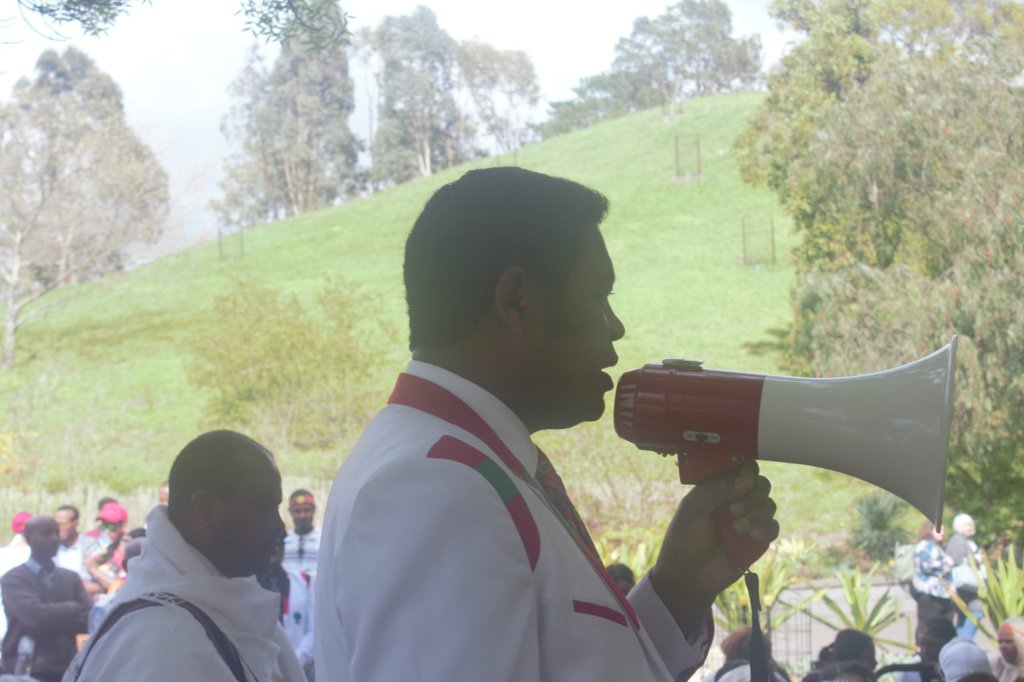
Irreechaa is celebrated every year in the end of September or beginning of October in various part of the globe where the Oromo community resides.
The organisers states that this year celebration in Melbourne will be held in the context of the country at family level due to COVID-19 lockdown while cultural values of the Irreechaa celebration are maintained. The celebration still helps to strengthen and promote the Oromo tradition of respect for nature and gratefulness for life in Melbourne.
Head of Cultural Education Committee, Danye Dafarsha, also said the Irreecha festivity celebrated in Birraa (in September and October) is the cultural expression of thankfulness to Waaqaa for providing life necessities to human beings and other living things.
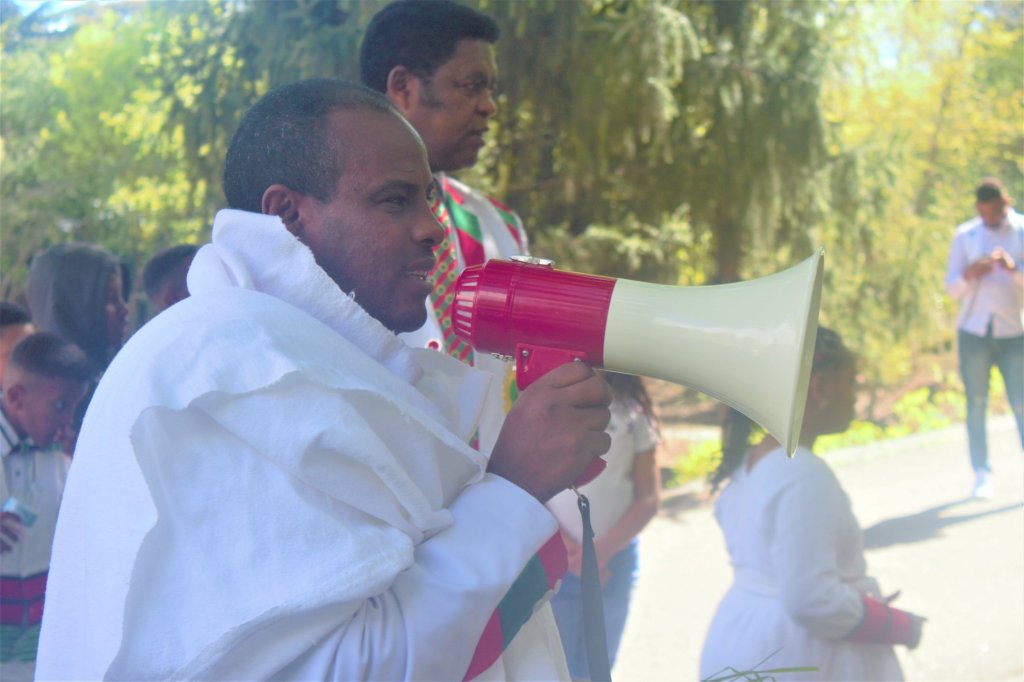
This is because the Oromo believe Waaqaa is the sole creator of everything and source of all life. It is also regarded as pure, omnipresent, infinite, incomprehensible and intolerant to injustice, crime, sin and all falsehood. It can do and undo anything.
On this day, family come to gather at their best place (near the river bank or water) depending on their states lockdown restrictions, to give thanks to the almighty Waaqaa(God) for all the blessings throughout the past dry season and ask for Araaraa (Reconciliation), Nagaa (Peace), Walooma (Harmony) and Finnaa (Holistic Development) for the present and the future.
Australian Oromo formally celebrated this Irreecha every year in Birraa near the river bank or water and tree.
According to the Irreechaa Organising Committee, all Oromos in Victoria are expected to take part in the celebration at the family level.
“What a wonderful time we had on a cooler than typical spring day in 2021 enjoying all that the Irreechaa Festival presented,” Ob Abdeta Homa added.
Accordning to Ob Oluma Qubee, the Oromo elder who has been involved in nurturing Oromo culture for many years, Irreechaa is the celebration of peace, unity and cooperation where the celebrants carrying bunch of straw and daisies in their hands praising, blessing and praying Waaqa in their songs.
“The Oromo people celebrate Irreechaa not only to thank Waaqaa (God) but also to welcome the new season of plentiful harvests after the dark and rainy winter season associated with nature and creature,” Ob Oluma added.

In the traditional religion of the Oromos, the spirit is the power through which Waaqaa (The Almighty God) governs all over the world. Thus, Oromos believe that every creation of Waaqaa has its own spirit.
The ceremony honors elders’ blessings and wisdom, preserves the heritage and assesses the progress of humanity.
“Here in Australia, Melbourne, we continue this fabulous event every year for since 2007.
“The celebrations are unique in that the Melbourne celebration has come again and that contributes to the development of Oromummaa in the Diaspora,” Ob Abdeta said.

There is also a ceremony of thanking all forebears for their endurance and determination to survive their culture and history – paving the way for further social victory.
In the Oromo tradition river banks, the tops of mountains, the hills and other elevated grounds are respected landscapes because they believe that these landscapes represent the value of life and nature.
It is a unique Oromo cultural, historical and natural beautification in their full glory at the height of the season.

Oromos are celebrating this auspicious event to mark the end of rainy season[1], known as Birraa, was established by Oromo forefathers, in the time of Gadaa Melbaa[2] in Mormor, Oromia.
The auspicious day on which this last Mormor[3] Day of Gadaa Belbaa[4]-the Dark Time of starvation and hunger- was established on the 1st Sunday of last week of September or the 1stSunday of the 1st week of October according to the Gadaa lunar calendar ‐‐ has been designated as our National Thanksgiving Day by modern‐day Oromo people. Oromo communities both at home and abroad celebrate this National Thanksgiving Day every year.
Irreechaa as a medium for bringing all Oromias together
The Oromian Irreechaa Festival will not only serve as a medium for bringing all Oromias together, from all its diasporas, as one voice, but will also focus on promoting and enhancing Oromummaa in freedom struggle, tourism, arts and crafts, business, restaurants and hospitality, and entertainment.
Moreover as a moving and flourishing heritage, Irreechaa also connects our Oromo identity with the global civilization in which the industrial and manufacturing sectors of heavy and light machinery of natural resources and raw materials.
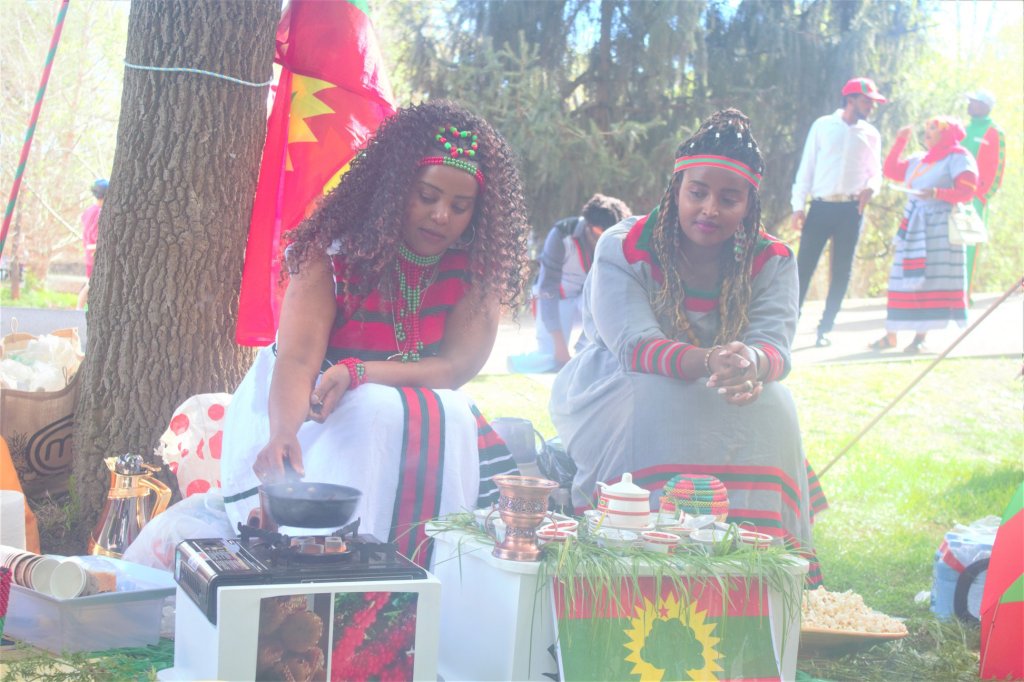
During the event, we will be serving with Oromo foods and featuring with traditional dances by Oromo children, youth and dance troupes. Irreechaa is about a lot more than just putting on shows, it encourages engagement and participation from everyone in the greater community across our great city, country and the globe.
On Irreechaa festivals, friends, family, and relatives gather together and celebrate with joy and happiness. Irreechaa festivals bring people closer to each other and make social bonds.
Irreecha is one of the previous Cushitic religious traditions of praying to God (Waaqa). It has been observed by the Oromo people for more than 6400 years.
[1] Rainy season symbolized as a dark, disunity and challenging time in Oromia.
[2] Gadaa Melbaa was established before 6400 years ago at Odaa Mormor, North-west Oromia.
[3] Mormor in Oromo means division, disunity, chaos.
[4] Gadaa Belbaa is the end time of starvation.
Advocacy for Oromia Statement over the safety of OLF Chairman
(A4O, 29 May 2021) Advocacy for Oromo request to the international community expressing concern over the safety of Chairman of Oromo Liberation Front, Dawud Ibsa.
Advocacy for Oromia called on the international community “to pressure the Abiy government to ensure the safety of Mr. Dawud Ibsa, the Chairman of the Oromo Liberation Front, and his family who are under PM Abiy’s security siege during this volatile time.”
Find full statement

Irreecha Arfaasa to be held May 30
(Melbourne, Irreechaa, September 20, 2021)-The Oromia Irreechaa Organising Committee in Victoria is preparing to celebrate Irreecha Arfaasaa in Melbourne on 30th May.
Head of the Committee, Ob Abdeta Homa, said the celebration marks the end of the dry season (October to April) and the beginning of the rainy season for planting (May to September).
The organisers states that the celebration helps to strengthen and promote the Oromo tradition of respect for nature and gratefulness for life in Melbourne.
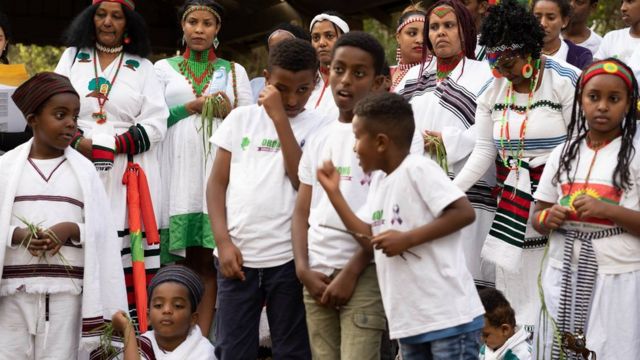
Australian Oromo celebrated this Irreecha on the Mount Dandenong which is found in the South Eastern region of Melbourne.
On this day, people come to gather on mountain tops to give thanks to the almighty Waaqaa(God) for all the blessings throughout the past dry season and ask for Araaraa (Reconciliation), Nagaa (Peace), Walooma (Harmony) and Finnaa (Holistic Development) for the present and the future.
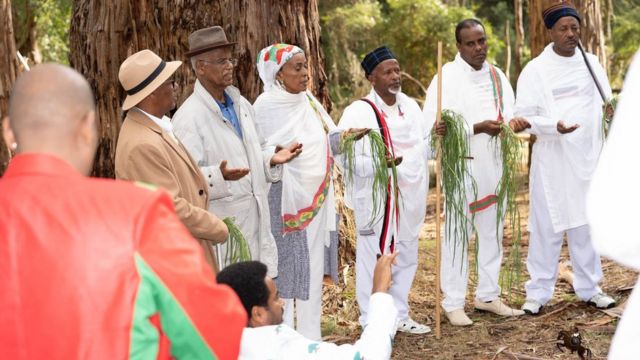
Irreecha Arfaasaa is another annual Oromo Thanksgiving Day that repeats once in a year to mark the end of the dry season and beginning of the rainy and planting season.
The ceremony honors elders’ blessings and wisdom, preserves the heritage and assesses the progress of humanity.
There is also a ceremony of thanking all forebears for their endurance and determination to survive their culture and history – paving the way for further social victory.
In the Oromo tradition the tops of mountains, the hills and other elevated grounds are respected landscapes because they believe that these landscapes represent the value of life and nature.
It is a unique Oromo cultural, historical and natural beautification (planting) in their full glory at the height of the season.
Irreecha Arfaasaa is one of the previous Cushitic religious traditions of praying to God (Waaqa). It has been observed by the Oromo people for more than 6400 years.
Advocacy for Oromia Press Release
(Advocacy for Oromia, 15 May 2021) Advocacy for Oromia condemns the illegal, brutal, barbaric killing of Amanuel Wandimu.
On its press release, Advocacy for Oromia calls all concerned bodies to exert the maximum possible pressure on the Ethiopian government
- to immediately give appropriate political space to the Ethiopian people,
- to address their long-term grievances and demands,
- to allow all-inclusive National Dialogues among political organizations, and
- to extend the election time to include all political parties in the upcoming national poll.







